Copyright © 2022 by WageIndicator Foundation (Netherlands) and Centre for Labour Research (Pakistan)
All rights reserved. No part of this publication may be reproduced, distributed, or transmitted in any form or by any means, including photocopying, recording, or other electronic or mechanical methods, without the prior written permission of the publisher, except in the case of brief quotations embodied in critical reviews and certain other non-commercial uses permitted by copyright law. For permission requests, write to the publisher, addressed “Attention: Permissions Coordinator,” at the address below.
WageIndicator Foundation - www.wageindicator.org
WageIndicator Foundation is a non-profit NGO. It develops, operates and owns national WageIndicator websites with labour-related content, using data from its WageIndicator Salary and Working Conditions Survey, Minimum Wages Database, Collective Agreement Database, Salary Checks and Calculations, Decent Work Checks and related Labour Law Database, and Cost of Living Survey and resulting Living Wages Database. The mission of WageIndicator is to promote labour market transparency for the benefit of all employers, employees and workers worldwide by sharing and comparing information on wages, labour law and careers. WageIndicator does so by making this information freely available on easy to reach and read national websites in the national language(s). WageIndicator now has operations in 196 countries.
Centre for Labour Research - www.clr.org.pk
Centre for Labour Research, a non-profit organisation registered in Pakistan under section 42 of the Companies Act 2017, works on comparative labour issues. Besides its advisory work with the federal and provincial governments in Pakistan, the Centre is the WageIndicator Global Labour Law Office. The Centre creates the Decent Work Checks and maintains the WageIndicator Labour Law Database and WageIndicator Minimum Wages Database.
Bibliographical Information
WageIndicator Foundation and Centre for Labour Research (2022), Labour Right Index 2022. Amsterdam, the Netherlands; Islamabad, Pakistan, October.
© WageIndicator Foundation and Centre for Labour Research 2022. All rights reserved. For queries and feedback, please write to us at office@wageindicator.org
Disclaimer: The maps used in this report are sourced from AM Charts and may not reflect the political ground realities. For reference, please see https://www.amcharts.com/
Credits: Photos used in the section on "Indicators for Decent Work" are sourced from Pexels and are free to use. Photo credits are given at end of each photo.
Acknowledgements
The WageIndicator Foundation and the Centre for Labour Research co-produced the first edition of the Labour Rights Index in 2020. This is the second edition of the Index with 135 countries.
WageIndicator Foundation, a Dutch non-profit established in 2001, works towards increased transparency in labour markets by providing access to minimum wages, living wages, and labour rights information.
The Centre for Labour Research, an independent non-profit registered in Pakistan, has a niche speciality in comparative labour research. Other than advising the federal and provincial government in Pakistan, the Centre is the WageIndicator’s Global Labour Law Office and maintains Labour Law Database and Minimum Wages Database.
As explained in the first version, the Labour Rights Index is the culmination of more than 13 years of comparative labour law work by Iftikhar Ahmad[1]
, who has spearheaded this report. The work has benefited from valuable inputs from the WageIndicator Foundation.
The team gratefully acknowledges WageIndicator for their input and continuous support. Paulien Osse, Dirk Dragstra and Kea Tijdens reviewed the report and made valuable suggestions. In addition, feedback from Professor Rob van Tulder and Willy Wagenmans (WageIndicator Board), Fiona Dragstra (Director WageIndicator), Daniela Ceccon ((Director Data, WageIndicator), Professor Evert Verhulp (University of Amsterdam), Professor Beryl ter Haar (University of Leiden), Professor Elena Sychenko (University of Bologna) and Asghar Jameel (Centre for Labour Research Board) helped refine the Index and its methodology.
We are also grateful to all the organisations from which we source the key facts that are part of the country profiles. These include the World Bank, the International Labour Organization and the WageIndicator Foundation.
The scoring for country profiles under different indicators, though essentially hinged on the Decent Work Checks, have also been confirmed from other indices/reports, including the Women, Business and Law Database (World Bank), International Social Security Association (ISSA) Country Profiles, various ILO databases, the US Department of State’s Country Reports on Human Rights Practices (USDOS CRHRP), the US ILAB Findings on the Worst Forms of Child Labour, the ITUC Global Rights Index and the Centre for Global Workers’ Rights. Our special thanks and appreciation go to the International Labour Organization, whose instruments (conventions and recommendations) are part of our scoring methodology: the country scoring has been based on these instruments as much as possible. The comments and observations of the ILO supervisory body, the Committee of Experts on Application of Conventions and Recommendations (CEACR), were considered while scoring trade union questions. Similarly, the US Department of State’s Country Reports on Human Rights Practices has also been used for scoring the trade union questions.
Special thanks are due to the team members at the Centre for Labour Research who have worked long hours for months to produce this work.
Iftikhar Ahmad has led the legal research, the methodology behind the Index, the scoring of countries and the drafting of the report. Shanza Sohail and Heena Tariq, at the Centre for Labour Research have assisted in the drafting of this report. Tasmeena Tahir has been involved in the whole process, ranging from the collection of contextual indicators to legal research and reviewing the legal basis for countries.
Scoring is done by the WageIndicator/Centre for Labour Research team comprising Iftikhar Ahmad, Shanza Sohail, Tasmeena Tahir, and Heena Tariq. Ayesha Kiran and Ayesha Mir have supported the work by maintaining the Minimum Wages Database and Labour Rights Database, respectively. Nasir Zaman, Rida Mukhtar and Sehrish Irfan have contributed to legal research, scoring and reviewing the legal basis. Sobia Ahmad reviewed the scores and did a quality check of the data. Our former team members, Asma Effendi, Rabia Bano and Ahad Raza Chohan, also need to be acknowledged for being part of the journey.
The report and country profiles are designed by Heena Tariq and Seemab Haider. Rogério Marques Benedito Júnior has created informative video about the Labour Rights Index 2022. The Labour Rights Index heat map has been developed by Seemab Haider. Special thanks to Paulien Osse and Gunjan Pandya for bringing the heat map and country profiles online. The Index, heat map, and country profiles are available on https://labourrightsindex.org.
Team behind the Index
Iftikhar Ahmad (Team Lead)
CORE TEAM
(Centre for Labour Research/WageIndicator)
- Shanza Sohail
- Tasmeena Tahir
- Heena Tariq
- Ayesha Kiran
- Ayesha Mir
- Sehrish Irfan
- Seemab Haider
- Nasir Zaman
- Rida Mukhtar
TECHNICAL SUPPORT TEAM
(WageIndicator Foundation)
- Paulien Osse
- Kea Tijdens
- Fiona Dragstra
- Daniela Ceccon
- Marta Kahancová
- Rupa Korde
- Niels Peuchen
- Rogério Júnior
- Shantanu Kishwar
- Vasudha Ghai
- Gunjan Pandya
COUNTRY LEVEL CONTRIBUTORS
(WageIndicator Foundation)
Albania
- Elvisa Drishti
Argentina (and Latin America)
- Lorena Ponce De Leon, Mariana Robin
Bangladesh
- Bangladesh Institute of Development Studies
Belgium
- Dirk Dragstra
Brazil, Portugal and Angola
- Ludmilla Caminha Barros, Rogério Júnior
Burundi (and French Africa)
- Liberat Bigirimana
Egypt
- Hossam Hussein, Rana Medhat
Ethiopia
- Eyuel Mekonnen, Gashaw Tesfa
Greece
- Stefani Kostagianni
Hungary
- Szilvia Borbély
India
- Rupa Korde
Indonesia
- Nadia Pralitasari, Dela Feby
Italy
- Daniela Ceccon
Bosnia and Herzegovina
- Nermin Oruc
Malaysia
- Nor Farah Ashikin binti Abdul Rahim
Mexico
- Angelica Flores
Mozambique and Cape Verde
- Egidio G. Vaz Raposo, Rogério Júnior
Netherlands
- Leontine Bijleveld, Fiona Dragstra, Niels Peuchen
Pakistan
- Centre for Labour Research
Russia (plus Azerbaijan, Belarus, Kazakhstan, and Ukraine)
- Elena Golovko
South Africa (Botswana, Ghana, Kenya, Lesotho, Malawi, Namibia, Nigeria, Rwanda, South Sudan, Uganda, Zambia and Zimbabwe)
- Karen Rutter
Spain
- Miquel Lóriz Toro
Tanzania
- Oscar Mkude
Uganda
- Birabwa Maria Namukusa, Nadera Saphina
Vietnam
- Thuonghien Dong
Foreword
With gratitude and a big smile on our faces, WageIndicator proudly presents the Labour Rights Index 2022 with the world. The Labour Rights Index is a unique Index that scores and rates 135 countries in the world on the basis of their national labour law and how these laws relate to the Decent Work Agenda of the International Labour Organisation. It is the only Index in the world that compares national labour laws at this scale.
As the legal backbone of the Labour Rights Index, we find WageIndicator’s Decent Work Check. The Decent Work Check is used in national WageIndicator websites in 135 countries, and in WageIndicator projects at factory and plantation level in Indonesia, Ethiopia and Uganda, empowering garment workers and flower growers.
The Index is not stand-alone but is part of ongoing research on and structuring of national labour laws in 135 countries and counting, as part of WageIndicator’s aim towards more labour market transparency on a global scale. The Labour Rights Index 2022 is a collective effort within WageIndicator with our labour law team at the Centre for Labour Research in Pakistan, and the global team.
In comparison to the first launch of the Labour Rights Index in 2020 that covered 115 countries, we see that there are many global and country level changes in the areas of family responsibilities and fair treatment, including but not limited to paid paternity leave, equal remuneration for work of equal value, and allowing women to have access to the same jobs as men. Together with the ripple effects within their regions, these reforms have the potential to lead toward greater equality in the global labour market.
Next to celebrating the unique nature of the Index, we also take a moment to reflect on the timing in which this second Labour Rights Index came to life, as in 2020 the world changed rapidly. The COVID-19 pandemic was not only a health crisis, but it also affected the world of work. Millions of people lost their jobs, many started to work from home and/or remotely, and policy makers were struggling with laws and regulations that proved inadequate to this new situation. Because of this, the 2022 Labour Rights Index also includes the effects of COVID-19 on the countries included in the Index.
In the countdown to the launch, Pakistan was hit by devastating floods during the 2022 monsoon season, and hence the team in Pakistan had to pause their work for a while. We are grateful for their hard work and dedication, and are thankful that they are safe, while our hearts are with the victims of the floods.
We hope you enjoy this comprehensive Labour Rights Index and that it provides you with the information that you need for your work, your research, your advocacy campaign, your policy paper, or simply broadening your understanding of labour laws in a comparative perspective.
Happy Decent Work Day!
Fiona Dragstra
Director WageIndicator Foundation
Section 1 INSIGHTS
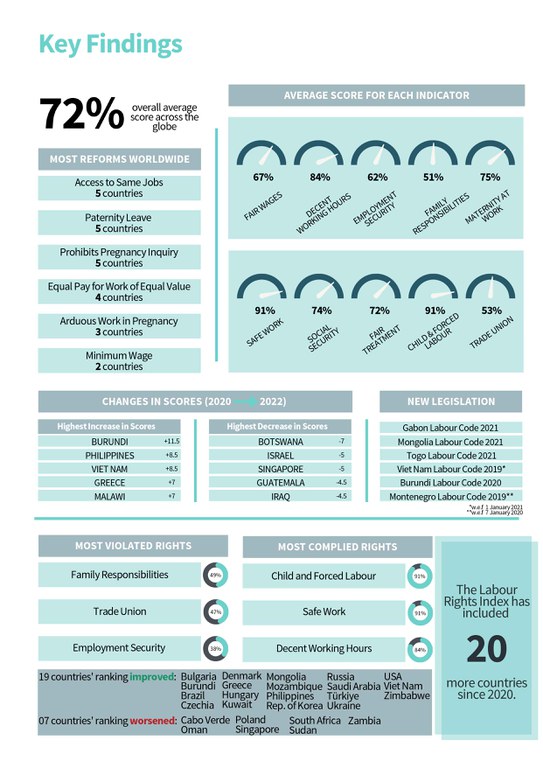
Reforms Around The World
Summaries of Reforms
Between 1 January 2020 and 1 January 2022, we recorded 54 changes to indicator scores. There were 33 countries which introduced positive legal reforms, resulting in a change of score to 1. Over the same period, 21 countries either introduced legislative changes or did not revise their minimum wages during the last two years, resulting in a change in their score to 0. Bangladesh, Burundi, Mongolia and Togo were the only countries to have introduced changes in their legislation frustrating workers rights or inaction on their parts, thereby affecting the provision of labour rights in these countries.
Angola
❌ Fair Wages: Angola last updated its minimum wage before 1 January 2020.
Bahrain
✔ Fair Treatment: Bahrain mandated equal remuneration for work of equal value. Bahrain also lifted restrictions on women’s ability to work at night and repealed provisions prohibiting or restricting women from working in certain jobs or industries.
Bangladesh
❌ Fair Wages: Bangladesh last updated its minimum wage before 1 January 2020.
✔ Trade Union: Bangladesh has allowed workers in export processing zones to bargain collectively with employers through their representative unions.
Bolivia
✔ Fair Treatment: Bolivia has removed restrictions on women’s employment. The law now allows women to work in the same jobs as men.
Botswana
❌ Trade Union: Botswana has imposed limitations on the scope of collective bargaining of public sector workers not engaged in the administration of the State.
Burundi
✔ Employment Security: Burundi has restricted the hiring of fixed-term contract workers by limiting the length and renewals of fixed-term contracts to 12 months
❌ Maternity at Work: Burundi has made maternity benefits an employer's liability.
✔ Safe Work: Burundi has required employers to provide free personal protective equipment to workers. The country has also restricted work that is prejudicial to the health of the mother or the child.
✔ Social Security: Burundi has introduced state-administered unemployment benefits for its workers.
✔ Fair Treatment: Burundi has mandated equal remuneration for work of equal value.
✔ Trade Union: Burundi has prohibited employers from terminating employment contracts of striking workers.
Cabo Verde
❌ Fair Wages: Cabo Verde last updated its minimum wage before 1 January 2020.
The Democratic Republic of the Congo
❌ Fair Wages: The Democratic Republic of the Congo last updated its minimum wage before 1 January 2020.
Greece
✔ Family Responsibilities: Greece introduced paid paternity leave of 16 calendar days.
Iraq
❌ Fair Wages: Iraq last updated its minimum wage before 1 January 2020.
Kenya
❌ Fair Wages: Kenya last updated its minimum wage before 1 January 2020.
Kuwait
✔ Maternity at Work: Kuwait has implicitly prohibited inquiring about pregnancy during recruitment.
Lebanon
✔ Fair Wages: Lebanon has updated its minimum wage after or on 1 January 2020.
Lesotho
❌ Fair Wages: Lesotho last updated its minimum wage before 1 January 2020.
Madagascar
❌ Fair Wages: Madagascar last updated its minimum wage before 1 January 2020.
Malawi
✔ Family Responsibilities: Malawi introduced paid paternity leave of 14 calendar days. The country has also passed a law requiring paid nursing breaks until the child is six months of age.
Mongolia
❌ Fair Wages: Mongolia requires overtime compensation to be 150% of the regular hourly rate for employees who worked overtime and were not provided with compensatory rest.
✔ Decent Working Hours: Mongolia has restricted maximum working hours, including overtime, to 56 hours per week.
✔ Employment Security: Mongolia has restricted the hiring of fixed-term contract workers by limiting the length and renewals of fixed-term contracts to 24 months.
❌ Employment Security: Mongolia has extended the length of the probation period, including renewals, from three months to a maximum of six months.
✔ Family Responsibilities: Mongolia has introduced a paid paternity leave of 14 calendar days. The country now also requires flexible work arrangements for workers with family responsibilities.
✔ Fair Treatment: Mongolia mandates equal remuneration for work of equal value.
❌ Child and Forced Labour: Mongolia has set the employment entry age lower than the compulsory schooling age.
❌ Trade Union: Mongolia has not regulated the right to collective bargaining of civil servants not engaged in the administration of the State.
Montenegro
✔ Fair Treatment: Montenegro has removed restrictions on women’s employment. The law now allows women to work in the same jobs as men.
Myanmar
❌ Fair Wages: Myanmar last updated its minimum wage before 1 January 2020.
Nigeria
❌ Fair Wages: Nigeria last updated its minimum wage before 1 January 2020.
Peru
❌ Fair Wages: Peru last updated its minimum wage before 1 January 2020.
Qatar
✔ Fair Wages: Qatar has updated its minimum wage after or on 1 January 2020. It is the first country in the region to announce a non-discriminatory wage that applies to all workers, irrespective of their sector of employment and nationality.
Senegal
❌ Fair Wages: Senegal last updated its minimum wage before 1 January 2020.
✔ Safe Work: Senegal has restricted work that is prejudicial to the health of the mother or the child.
Spain
✔ Trade Union: Spain has prohibited employers from terminating employment contracts of striking workers.
Togo
❌ Maternity at Work: Togo does not protect workers from dismissals during or on account of pregnancy.
✔ Fair Treatment: Togo has removed restrictions on women’s employment. The law now allows women to work in the same jobs as men.
❌ Trade Union: Togo has imposed limitations on the right to strike by extending the list of essential services outside the scope defined in the Labour Rights Index.
Ukraine
✔ Family Responsibilities: Ukraine has introduced a paid paternity leave of 14 calendar days.
United Arab Emirates
✔ Family Responsibilities: UAE has introduced a paid paternity leave of 7 calendar days.
✔ Fair Treatment: UAE now mandates equal remuneration for work of equal value.
Vietnam
✔ Maternity at Work: Vietnam has implicitly prohibited pregnancy inquiry and testing during recruitment.
✔ Fair Treatment: Vietnam has prohibited discrimination in employment matters. The country has also removed restrictions on women’s employment. The law now allows women to work in the same jobs as men.
Zambia
❌ Fair Wages: Zambia last updated its minimum wage before 1 January 2020.
Global Trends in Labour Rights
The Labour Rights Index tracks the changes in workplace rights during the past two years.
However, some countries have enacted regressive and repressive labour legislation, undermining and frustrating workers' rights.
The section describes some major trends before delving into detail at the country level.
Minimum Wage
Our data, under the Labour Rights Index, shows that minimum wages, statutory or negotiated, exist in more than 90 per cent of the 135 countries. While three countries have no provision for minimum wages, there are seven countries which stipulate minimum wages either for nationals or for public sector workers only. Seven of these ten countries either have no minimum wage or no minimum wage for private sector workers are from the Middle East and North Africa region. Given this background, Qatar announced a minimum wage that applies to workers in all sectors and does not discriminate between nationals and migrant workers.
Qatar is the first country in the Gulf region to introduce a non-discriminatory minimum wage for all workers, irrespective of their nationality. Other countries in the region may wish to emulate it.
Paternity Leave
In 2022, 58 of 135 countries covered under the Labour Rights Index 2022 provide for a statutory right to paid paternity leave of at least seven calendar days to fathers in the event of childbirth Many countries (36) stipulate a right to paid paternity leave of 1-4 working days. Others provide for unpaid paternity leave. In the last two years, six countries (Greece, Malawi, Mongolia, Ukraine and the United Arab Emirates) have enacted legislation providing a paid paternity leave of more than seven calendar days..
These countries are from different regions and can serve as trendsetters within their regions. For instance, in the MENA region, only two countries have legislative provisions for paid paternity leave. Iran has had the necessary provisions since 2013, while the United Arab Emirates started offering paid paternity leave in 2020. Malawi is one of the five countries in the Sub-Saharan Africa region to have a paternity leave of at least one calendar week.
Women’s Access to Same Jobs as Men
One of the components of the Labour Rights Index measures whether women can get the same jobs as men. Labour legislation in nearly half of the countries assessed under the Index prohibits women’s access to the same jobs as men on the pretext of protection. This happens by setting prohibitions on night work, creating an extensive list of jobs considered dangerous or hazardous for women, and prohibiting women’s employment in mining, construction, certain factories, and the transport sector. These legislative provisions limit employment options for women leading to women’s concentration in low-income and low- productivity jobs. Bahrain, Bolivia, Montenegro, Togo and Viet Nam have enacted necessary legislation allowing women to have access to the same jobs as men and allowing for greater women workforce participation.
Pregnancy Testing
Though international regulatory standards (C183) prohibit requiring women workers to take pregnancy tests, with a few exceptions related to occupational risks to the worker’s or child’s health, there are 62 countries where the practice is not prohibited under legislation. Since 2021, Kuwait and Viet Nam implicitly prohibit pregnancy testing or inquiring about pregnancy during recruitment. This allows women to join the workforce rather than being stopped at the door.
Equal Pay for Work of Equal Value
The gender wage gap, the difference between their earnings, expressed as a percentage of men’s earnings, is a useful measure to indicate how far behind women are in terms of wages. Women earn, on average, significantly less than men. Globally, the gender wage gap currently stands on average at 23 per cent – meaning that women earn 77 per cent of what men earn for each hour worked. The pay gap is even wider for mothers, women of colour, immigrant women, and disabled women. Legislation requiring equal pay for work of equal value and mandating minimum living wages can help narrow the gender pay gap in a country. Four countries, Bahrain, Burundi, Mongolia, and United Arab Emirates, now mandate equal pay for work of equal value.
| BEST COUNTRIES FOR WORKERS* | WORST COUNTRIES FOR WORKERS* |
| Belgium | Bangladesh |
| Bulgaria | Botswana |
| Czechia | Lebanon |
| Denmark | Malaysia |
| Finland | Nigeria |
| France | Oman |
| Greece | Papua New Guinea |
| Hungary | Qatar |
| Italy | Singapore |
| Latvia | Sri Lanka |
| Lithuania | Sudan |
| Portugal | United Arab Emirates |
| Romania | |
| Serbia | |
| Slovakia | |
| Sweden |
*The list of countries in the tables on best and worst countries for workers are alphabetical. For detailed scores, please refer to the scores table at the start of this report.
Section 2 CONCEPTUAL FRAMEWORK
Introduction
This is the second edition of the Labour Rights Index. The first edition was launched in the midst of the COVID-19 pandemic and covered 115 countries. The second edition is being launched at a moment when Pakistan, where the core team is located, is hit hard by the most devastating floods in its history, affecting 33 million people and claiming more than 1600 lives.
The second edition of the Index has 135 countries and covers labour market regulation affecting approx. 95% of the global labour force (3.57 billion workers). Labour Rights Index is a wide-ranging assessment of labour market regulations in 135 countries. It focuses on de jure (according to law) aspects of the labour market. The report scores 135 economies on 10 areas of labour market regulation. These are referred to as indicators. There is no other comparable project in terms of scope. The Index sheds light on a range of differences in laws/regulations on 46 topics or components across 135 countries.
The Labour Rights Index, while one of the many[1] de jure indices, is arguably the most comprehensive one yet in the field of workers’ rights, as it encompasses every aspect of the working lifespan of a worker and identifies the presence of labour rights, or lack thereof, in national legal systems worldwide. The Index measures decent work and provides detailed information on rights at work as well as the local legal framework for regulating the labour market.[2]
While grounded in SDG 8[3], the Labour Rights Index is a tool essentially directed at governments and international organisations. And even though the underlying document for this Index, i.e., the Decent Work Check, is aimed mainly at workers and trade unions, the Index targets national-level organisations like government agencies, trade union federations and multilateral organisations such as the United Nations. This Index measures all labour rights protections that have been referred to in Target 8.8.[4] The Labour Rights Index emphasises the importance of a well- functioning legal and regulatory system in creating enabling conditions for the achievement of Decent Work. As a corollary, it lays bare the adverse impact of lack of regulation or inadequate regulation on the smooth functioning of (a) labour market(s).
The 2010 World Social Security Report notes that even the widest and most expansive legal foundations cannot achieve the desired outcomes if these are not enforced and backed by sufficient resources. Nevertheless, strong legal foundations are a precondition for securing higher provisions and resources. There is not a single situation where a country provides generous benefits without a comprehensive legal basis.[5]
Similar points have been raised by Botero et al.[6] that formal rules, although different from “on the ground” situations, still matter a lot. Botero’s work forms the basis of the Doing Business Indicators by the World Bank. Research indicates that in the absence of legislation, even the wealthiest country in the world, i.e., the United States of America, is unable to ensure decent working conditions for a majority of its citizens. As explained by Heymann and Earle [7], “laws indicate a state’s commitment to its people, lead to change by shaping public attitudes, encourage government follow-up through inspection and implementation of the law and allow court action for enforcement.”
As an international qualification standard, the primary focus of the Labour Rights Index on larger administrative bodies does not limit its usability for actors at multiple levels. National scores can be used as starting points for negotiations and reforms by civil society organisations. Ratings can be made prerequisites for international socio- economic agreements to ensure compliance with labour standards, similar to EU’s GSP+ and USA’s GSP, which require compliance in law and practice with specific labour standards in order to avail certain trade benefits through reduced tariffs. The Index provides meaningful input into policy discussions to improve labour market protections at the country level.
The Labour Rights Index is also a useful benchmarking tool that can be used in stimulating policy debate as it can help in exposing challenges and identifying regulatory best practices. The Index provides meaningful input into policy discussions to improve labour market protections at the country level. The Labour Rights Index is a repository of “objective and actionable” data on labour market regulation along with the relevant best practices which can be used by countries worldwide to initiate necessary reforms. The comparative tool can also be used by Labour Ministries for finding legislative best practices within their own regions and around the world.
The Labour Rights Index can work as an efficient aid for workers as well to gauge the labour rights protections in laws across countries. With increased internet use, the availability of reliable and objective legal rights information is the first step towards compliance. The Labour Rights Index helps in achieving that step. The Index is similarly useful for national and transnational employers to gauge their statutory obligations in different workplaces and legal settings.
It can be used as a benchmarking tool for policy making. While the Index does not promote “legislative transplants”, it shows the international recommended standard based on UN or ILO Conventions and Recommendations. Similarly, the Index does not advocate the idea of “one size fits all”; rather, countries may provide certain rights through statutory means or allow negotiation between the parties at a collective level.
Linkage with SDGs
In September 2015, 193 states decided to adopt a set of 17 goals to end poverty and ensure decent work as part of the Sustainable Development Goals (SDGs). Each goal has specific targets to be achieved over 15 years. There are 169 targets and 232 indicators listed under these 17 SDGs. The Labour Rights Index aims at an active contribution to the Sustainable Development Goals[1] by providing necessary (complementary) insights into de jure provisions on issues covered in particular by SDG 8 (Decent Jobs), SDG 5 (Gender Equality), SDG 10 (Reduced Inequalities) and SDG 16 (Strong Institutions).
The inextricable yet dormant link between decent work and economic growth has had a special trajectory with respect to development goals.
Unlike the Millennium Development Goals (MDGs), where full employment and decent work were addressed through the inclusion of a new target (Target 1B[2]) in 2007 (six years after the start of the MDGs in 2001), Goal 8 under the SDGs focuses on the promotion of inclusive and sustainable economic growth that leads to employment and decent work for all[3]. This has not necessarily resulted in a positive response. The linking of economic growth and decent work under Goal 8 has been criticised as the relegation of decent work – a human rights concern – to being a mere dividend of economic growth[4].
Despite this criticism, owing to the global financial crisis of 2008 and the current COVID-19- induced labour market crisis, employment and work has gained centre-stage. Employment and employment-related issues are also referred to in other goals[12].
Target 8.8 refers explicitly to the protection of labour rights and promotion of safe and secure working environments for all workers, including migrant workers, in particular women migrants and those in precarious employment. While Target 8.8 talks about the protection of all labour rights, Indicator 8.8.2 is solely concerned with national compliance with freedom of association and collective bargaining rights.
There is no doubt that the freedom of association and the right to collective bargaining are enabling rights. These not only have a direct bearing on labour and economic outcomes but also help in guaranteeing democracy in a country. The 2014 Nobel Prize to Tunisia’s National Dialogue Quartet, especially to The Tunisian General Labour Union (UGTT), was a testimony of labour support to democracy after the Jasmine Revolution.[13] The Tunisian General Labour Union (UGTT) was one of the four organisations that were awarded the Nobel Prize.
However, as required under Target 8.8, the protection of labour rights has to be holistically ensured, including for those in precarious employment, the most recent form of which is the gig economy. Instead of focusing only on trade union rights, all workplace rights can and should be measured and monitored both in law and practice.
The Labour Rights Index also covers the regulation of the gig economy as one of the evaluation criteria and gives a positive score to a country where gig workers are not treated as merely independent contractors.
No country or state has enacted comprehensive legislation to protect the rights of these precarious workers. The scoring methodology, however takes into account access to basic social protection, i.e., old age benefits, invalidity benefits and survivors’ benefits, for independent contractors. The majority of the countries give access to basic social protection to independent contractors.
Despite their unprecedented status,[14] SDGs indicators were not ascertained through conventional global consultations. These were finalised by a select group of experts in March 2017.[15] The implementation and achievement of Target 8.8 depend on the availability of data on labour laws and labour practices. Various indices have targeted the latter or a combination of the two. The Labour Rights Index attempts to make a distinctive contribution by being one of the few that focus on the former.
Significant work in this sphere exists in the form of few ILO databases[16] and some indices like the World Bank’s Employing Workers database[17], the Women, Business and Law Database[18], the World Economic Forum’s Global Competitiveness Index (Labour Market Efficiency Pillar)[19], the Harvard/ NBER Global Labour Survey[20], the Index of Economic Freedoms (Labour Freedom component)[21] and the International Social Security Association (ISSA)[22], the OECD Indicators of Employment Protection[23], and the CBR-LRI (CBR Labour Regulation Index)[24]. While the International Labour Organisation is the lead agency for indicator 8.8.2, some work is already in progress on the issue.
Each of the mentioned surveys deals with specific aspects concerning labour rights. The ITUC[25] Survey on Violations of Trade Union Rights covers trade union rights.[26], the ITUC Global Rights Index, contrary to its name, measures only trade union rights using nearly 97 indicators.[27] Similarly, The Centre for Global Workers’ Rights under Penn State University has worked on the Labour Rights Indicators measuring compliance both in law and practice for freedom of association and rights to collective bargaining through 108 indicators.[28] The same indicators or evaluation criteria have been proposed by the ILO for measuring progress under SDG Indicator 8.8.2.
Despite this glut of indices on labour rights, experts at the WageIndicator Foundation and the Centre for Labour Research[29] have been working on the idea of a new de jure index, i.e., the Labour Rights Index. While various targets under SDG 8 focus on statistical data, none of those targets and indicators delves into the de jure labour rights protections as required under Target 8.8.
Based on 10 indicators and 46 evaluation criteria, the Index compares labour legislation[30] in 135 countries. There is no other comparable work in scale and scope on labour market regulations.
The 10 indicators cover the following aspects: fundamental workers’ rights (the right to unionise and the elimination of employment discrimination, child labour and forced labour), fair wages, decent working hours, employment security, social protection (access to the living wage, unemployment, old age, disability and survivor benefits and health insurance), work-life balance for workers with family responsibilities and access to safe and healthy workplaces. All index components are grounded in and linked with a selected list of international conventions and covenants.
The work is essentially based on ten substantive elements which are closely linked to the four strategic pillars of the Decent Work Agenda, that is, (i) Core labour standards and fundamental principles and rights at work (ii) Employment creation (iii) Social protection and (iv) Social dialogue and tripartism. The ILO Declaration on Social Justice for a Fair Globalisation 2008 has emphasised that the four strategic objectives of the Decent Work Agenda are “inseparable, interrelated and mutually supportive. The failure to promote any one of them would harm progress towards the others”.[31]Based on the recommendation of the 2008 ILO Declaration to establish appropriate indicators to monitor and evaluate the progress achieved, the ILO adopted a framework of statistical and legal Decent Work Indicators.
The framework indicators cover the ten substantive elements of the Decent Work Agenda. These elements are:[32]
- employment opportunities
- adequate earnings and productive work
- decent working time
- combining work, family and personal life
- work that should be abolished (child labour and forced labour)
- stability and security of work
- equal opportunity and treatment in employment
- safe work environment
- social security
- social dialogue, employers’ and workers’ representation
The Index is further built on the Decent Work Checks, which have detailed explanations of de jure provisions on various workplace rights under national labour law. None of the above-referred indices is as comprehensive and detailed as the Labour Rights Index.
While many would argue against building another index focusing only on de jure labour market institutions and provisions (namely, due to the existence of large informal sectors in developing countries, non-compliance coupled with the tepid and lacklustre implementation of labour laws), well-drafted and inclusive laws are still a precondition for attaining decent work. Well-drafted laws provide clear and explicit answers to difficult and perplexing questions.
The results and insights from the comparative Labour Rights Index can be used to bring much-needed labour legislation reforms in various countries. Universal labour guarantees or basic labour protections should be available to everyone. This essentially means that all workers, regardless of their contractual arrangement or employment status, should enjoy fundamental workers’ rights (freedom of association and right to collective bargaining, non-discrimination, no forced or child labour), an adequate living wage, maximum limits on working hours, safety and health at work, and access to the social protection system. The Index will not only help reform and develop missing legal provisions but will also help in tracing the jurisprudential evolution of legal systems in one of the most impressionable legal spheres.
Progress on Target 8.8, requiring protection of labour rights for all workers, including those in precarious employment, can be measured only through the comprehensive Labour Rights Index. Given the labour market havoc wreaked by the COVID-19 pandemic in recent years,[33] this is the most opportune time to address the protection of all labour rights and measure the progress of member countries.
In the words of the California Attorney General, Xavier Becerra, “Sometimes it takes a pandemic to shake us into realising what that [lacking basic labour protections] really means and who suffers the consequences.”[34] It is time to measure every country’s progress on all labour protections instead of merely focusing on trade union rights under SDG Indicator 8.8.2.
Data Notes
The WageIndicator Foundation and the Centre for Labour Research have developed the Labour Rights Index, which looks at the status of countries in terms of providing laws related to decent work for the labour force. The data set covers 10 indicators for 135 countries. The Index aims to provide a snapshot of the labour rights present in the legislation of the countries covered.
The following assumptions have been used while constructing the Labour Rights Index. The worker in question
- Is skilled;[35]
- Is at least a minimum wage worker; Resides in the economy’s most populous province/state/area;
- Is a lawful citizen or a legal immigrant[36] of the economy;
- Is a full-time employee with a permanent contract in a medium-sized enterprise with at least 60 employees;
- Has work experience of one year or more;
- Is assumed to be registered with the relevant social security institution and for a long enough time to accrue various monetary benefits (maternity, sickness, work injury, old age pension, survivors’, and invalidity benefit); and
- Is assumed to have been working long enough to access leaves (maternity, paternity, paternal, sick, and annual leave) and various social benefits, including unemployment benefits.
Methodology
The subtopics in a Decent Work Check (DWC)[37] have been used to structure 46 questions under the indicators in constructing this Index. However, what differentiates the Labour Rights Index from the Decent Work Checks is that it is more specific, adds newer topics like pregnancy inquiry, comparison between minimum age for employment and compulsory schooling age, and scoring of trade union questions is not solely dependent on labour legislation in the country. Forty-six data points are obtained across 10 indicators, each containing four to five binary questions. Each indicator represents an aspect of work which is considered important for achieving decent work.[38] The scores for each indicator are obtained by computing the unweighted average of the answers under that indicator and scaling the result to 100. The final scores for the countries are then determined by taking each indicator’s average, where 100 is the maximum score to achieve. Where an indicator has four questions, each question/component has a score of 25.
Where an indicator has five questions, each question/component has a score of 20. A Labour Rights Index score of 100 would indicate that there are no statutory decent work deficits in the areas covered by the Index.
Conceptual Framework
The Index consists of ten elements disaggregated into 46 components. These indicators and their components are presented below. Detailed description for each component can be found in the section on Indicators for Decent Work.
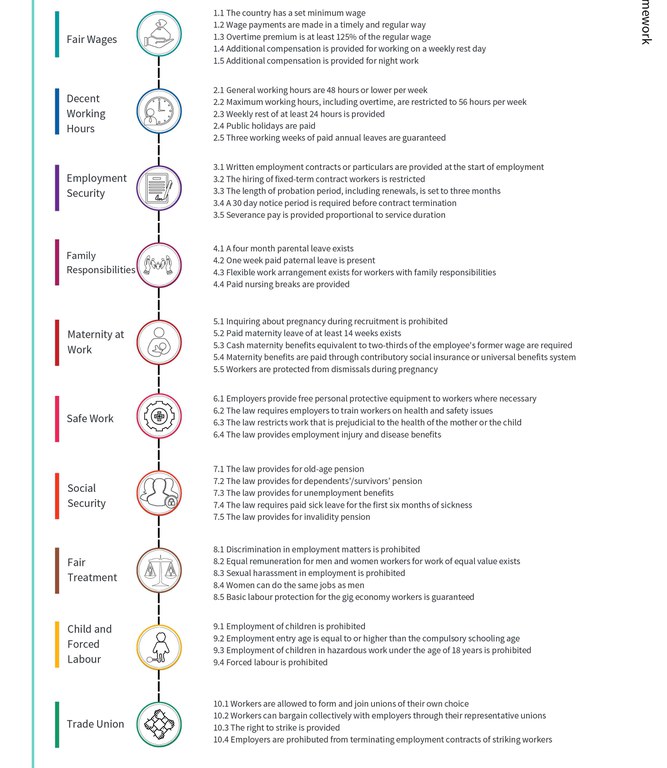
To illustrate the scoring process in the Index, Kenya, for example, receives a score of 100 under the indicator of Child and Forced Labour. This signifies that the country has legal protections in place for young workers participating in the labour market. However, under the indicator of Family responsibilities, Kenya scores 50 since the legislation does not guarantee parental leave and flexible work arrangements for workers with family responsibilities.
Scoring along these lines for a country, the overall score of Kenya is determined by taking the unweighted average of the scores for all 10 indicators on a 0-100 scale, where 0 represents the worst regulatory performance and 100 the best regulatory performance in the labour market. The overall score for Kenya is 66. For a comparison with other countries, please refer to the overall scores table at the start of this report.
The labour legislation of the 135 countries, applicable on 1 January 2022, is the source of information used to answer questions in the Labour Rights Index. The Index does not take into account COVID-19-related labour market measures initiated by countries. Strengths and limitations exist with this approach. While the Labour Rights Index has been designed to be an easily replicable tool to benchmark countries, there are certain advantages and limitations. To ensure comparability of data across 135 economies, specific assumptions have been made. The indicators in the Index are based on standardised assumptions to make the laws comparable across countries. For instance, an assumption used for this Index is that the worker in question who is affected by the labour laws has experience of one year or more at a workplace, as questions on annual leave and severance pay can only apply to this kind of worker. Hence, workers with temporary contracts of a duration of less than one year may not have access to such rights.
Another assumption underlying the Index is that the focus is on the labour legislation, which applies to the most populous province/state/area of a country.
This allows the Index to give a more accurate depiction of a country’s labour rights as the labour laws affect most of its population, even though the legislation affecting workers in areas with lower populations may be different.
Furthermore, the Index is also based on labour legislation which applies to the formal economy in the private sector. Despite more than 60 per cent of the global workforce in need of transitioning from informal to the formal economy,[39] focusing on the labour laws affecting the formal sector retains attention on the sector since the labour laws in the formal economy are more applicable and that is the ultimate goal. ILO Recommendation 204 also recommends gradual transition from the informal to the formal economy through the enactment of necessary legislation and reduction of barriers to transition. Focusing on the formal economy and its applicable legislation also indicates the kind of rights that will be available to the informal economy workers on successful transition to the formal economy.
Other than statutes, the Labour Rights Index also considers general or inter-professional collective agreements applicable at the national level. For countries where minimum wages are determined through collective bargaining, sectoral agreements (for major economic sectors) can also be considered.
Strengths and Limitations of the Labour Rights Index
| Feature | Strength | Limitation |
| Standardised assumptions | Makes labour legislation comparable across countries and methodology uncomplicated | Limits legislation under review |
| Focus on workers having one year or more at a workplace | Allows maximum coverage of labour rights | Does not consider the rights of casual and temporary workers. Non-standard workers may not have access to some of the workplace rights and components under the Labour Rights Index |
| Coverage of most populous province/state/area | Makes labour legislation comparable across countries where different areas have different labour laws for their populations; Gives a more accurate picture of a country’s labour rights | Can decrease representativeness of labour rights where differences in laws across areas exist |
| Focus on the formal economy | Retains attention on the formal sector where labour laws are more applicable | Does not cover the rights of the workforce in the informal economy, which could have a substantial part of the labour force in some countries |
| Use of codified national labour legislation only | Allows actionable indicators since the law can be changed by policymakers | Where lack of implementation of labour legislation, making changes solely in the law will not gain the desired outcome; Does not consider socio-cultural norms |
Moreover, this report acknowledges the presence of gaps between legislation and its practice. For instance, gaps could stem from the lack of implementation of laws because of poor enforcement, weak design, or limited capacity.
Still, observing differences in legislation helps give a clearer understanding of where labour rights may be limited in practice.
This study also recognises the presence of social, economic and cultural factors affecting the practice of legal rights. For example, women may not be working at night, although legally allowed, as social and cultural norms could restrain such options. Or a lack of safe transport may limit women’s employment during night hours.
Poverty-stricken areas may have children under the minimum working age being employed for long hours and not in light work. Workers may be doing overtime exceeding the weekly hour limit because the culture at their organisations may view such workers as harder working and thus more deserving of a reward.The Labour Rights Index 2022 acknowledges the restraints of its standardised assumptions and focuses on codified law. Even if these assumptions do not cover all the labour force in the country, they ensure the comparability of data.
Unlike other indices, the Labour Rights Index does not consider ratification of international conventions in its scoring or rating system since mere ratification is not a good indicator of actual implementation of international labour standards. It uses the standards prescribed in these Conventions (e.g., 14 weeks of maternity leave or the minimum age for hazardous work as 18 years) and scores countries on that basis.
All the 10 indicators and 46 evaluation criteria of the Labour Rights Index are grounded in substantive elements of the Decent Work Agenda. The legal basis for all components (regulatory standards) emanates from the UN or ILO Conventions. Table explains in detail these legal sources.
In summary, the Labour Rights Index methodology has various useful features. The methodology:
- Is transparent and based on facts taken directly from codified laws.
- Uses standardised assumptions for data collection, thereby making logical comparisons across countries.
- Allows data to identify the labour rights and their presence (or lack of) in the legislation of 135 countries.
International Regulatory Standards and Labour Rights Index
| Indicators and Components | Source of the Regulatory Standard | |
| 1. Fair Wages | ||
| 1 | Minimum wage (statutory or negotiated) | Article 23 (3) of the Universal Declaration of Human Rights; Article 3 of Minimum Wage Fixing Convention 1970 (No. 131); Article 7 of the International Covenant on Economic, Social & Cultural Rights (Fair Wage clauses) |
| 2 | Regular wage | Article 12 (1) of Protection of Wages Convention 1949 (No. 95); Article 11 (6) and 12 of Social Policy (Basic Aims and Standards) Convention 1962 (No. 117) |
| 3 | Overtime premium (≥125%) | Article 6 of Hours of Work (Industry) Convention 1919 (No. 1); Article 7 of the Hours of Work (Commerce and Offices) Convention 1930 (No. 30) |
| 4 | Weekly rest work compensation (time-off) | Article 5 of the Weekly Rest (Industry) Convention, 1921 (No. 14); Article 8 (3) of the Weekly Rest (Commerce and Offices) Convention, 1957 (No. 106)[1] |
| 5 | Night work premium | Article 8 of Night Work Convention, 1990 (No. 171) |
| 2. Decent Working Hours | ||
| 6 | General working hours (≤48 hours per week) | Article 2 of Hours of Work (Industry) Convention 1919 (No. 1); Article 3 of the Hours of Work (Commerce and Offices) Convention 1930 (No. 30); Article 1 of the Forty-Hour Week Convention, 1935 (No. 47) |
| 7 | Maximum working hours (≤56 hours per week) | Para 17 of the Reduction of Hours of Work Recommendation, 1962 (No. 116); Article 6 (2) of Hours of Work (Industry) Convention 1919 (No. 1); Article 7 (3) of the Hours of Work (Commerce and Offices) Convention 1930 (No. 30) |
| 8 | Weekly rest (≥24 hours) | Articles 3-6 of Hours of Work (Industry) Convention 1919 (No. 1); Article 2 of Weekly Rest (Industry) Convention 1921; Article 6 of Weekly Rest (Commerce and Offices) Convention 1957 |
| 9 | Paid public holidays | Article 5 of Working Conditions (Hotels and Restaurants) Convention 1991 (No. 172); Article 6 (1) of Holidays with Pay Convention (Revised) 1970 (No. 132); Article 7 (c) of the Part-Time Work Convention, 1994 (No. 175) |
| 10 | Annual leave (≥3 working weeks) | Article 3 of Holidays with Pay Convention (Revised) 1970 (No. 132) |
| 3. Employment Security | ||
| 11 | Written employment contract | Articles 7-8 of the Domestic Workers Convention, 2011 (No. 189); Part II (5) of the Private Employment Agencies Recommendation, 1997 (No. 188) |
| 12 | Fixed term contract (≤5 years) | Article 2 (3) of the Termination of Employment Convention 1982 (No. 158); Article 3 (2) of the Termination of Employment Recommendation, 1982 (No. 166) |
| 13 | Probation period (≤3 months) | Article 2 (b) of the Termination of Employment Convention 1982 (No. 158) |
| 14 | Termination notice period (1 month) | Article 11 of the Termination of Employment Convention 1982 (No. 158) |
| 15 | Severance pay (≥14 days per year of service) | Article 12 of the Termination of Employment Convention 1982 (No. 158) |
| 4. Family Responsibilities | ||
| 16 | Parental leave | Article 1 of the Workers with Family Responsibilities Convention, 1981 (No. 156); Paragraph 22 of the Workers with Family Responsibilities Recommendation, 1981 (No. 165); Paragraph 10 of the Maternity Protection Recommendation, 2000 (No. 191) |
| 17 | Paternity leave (≥1 week) | 2009 ILC Resolution Concerning Gender Equality at the Heart of Decent Work |
| 18 | Flexible working arrangements | Article 1 of the Workers with Family Responsibilities Convention, 1981 (No. 156); Paragraph 18 of the Workers with Family Responsibilities Recommendation, 1981 (No. 165); Article 9 (2) of the Part-Time Work Convention, 1994 (No. 175) |
| 19 | Nursing breaks | Article 10 of the Maternity Protection Convention, 2000 (No. 183) |
| 5. Maternity at Work | ||
| 20 | Prohibition on inquiring about pregnancy | Article 9 of the Maternity Protection Convention, 2000 (No. 183) |
| 21 | Maternity leave (≥14 weeks) | Article 4 of the Maternity Protection Convention, 2000 (No. 183); Article 11 (2) of UN Convention on the Elimination of All Forms of Discrimination against Women (CEDAW) |
| 22 | Cash maternity benefits (≥66.67% of former wage) | Article 6 of the Maternity Protection Convention, 2000 (No. 183) |
| 23 | Source of maternity benefits (social insurance or state financing) | Article 6(8) of the Maternity Protection Convention, 2000 (No. 183) |
| 24 | Protection from dismissals (pregnancy/maternity) | Article 8 of the Maternity Protection Convention, 2000 (No. 183); Article 11 (2) (a) of UN Convention on the Elimination of All Forms of Discrimination against Women (CEDAW) |
| 6. Safe Work | ||
| 25 | Personal protective equipment (free of cost) | Article 16 and 21 of the Occupational Safety and Health Convention, 1981 (No. 155) |
| 26 | Training on health and safety | Article 19 (d) of the Occupational Safety and Health Convention, 1981 (No. 155) |
| 27 | Restriction on work (prejudicial to health of mother or child) | Article 3 of the Maternity Protection Convention, 2000 (No. 183) |
| 28 | Employment injury benefits | Part VI of the Social Security (Minimum Standards) Convention, 1952 (No. 102) |
| 7. Social Security | ||
| 29 | Old age pension | Part V of the Social Security (Minimum Standards) Convention, 1952 (No. 102) |
| 30 | Survivors’ pension | Part X of the Social Security (Minimum Standards) Convention, 1952 (No. 102) |
| 31 | Unemployment benefits | Part IV of the Social Security (Minimum Standards) Convention, 1952 (No. 102) |
| 32 | Sickness benefits (≥ 6 months) | Part III of the Social Security (Minimum Standards) Convention, 1952 (No. 102) |
| 33 | Invalidity benefits | Part IX of the Social Security (Minimum Standards) Convention, 1952 (No. 102) |
| 8. Fair Treatment | ||
| 34 | Prohibition of employment discrimination | Article 2 of the Discrimination (Employment and Occupation) Convention, 1958 (No. 111); Articles 8 and 9 of the Maternity Protection Convention, 2000 (No. 183); Article 4 of the Vocational Rehabilitation and Employment (Disabled Persons) Convention, 1983 (No. 159); Article 1 of the Right to Organise and Collective Bargaining Convention, 1949 (No. 98); Article 5 and 27 of the Convention on the Rights of Persons with Disabilities |
| 35 | Equal remuneration for work of equal value | Article 2 of the Equal Remuneration Convention, 1951 (No. 100) |
| 36 | Prohibition of sexual harassment | Article 7 of the Violence and Harassment Convention, 2019 (No. 190) |
| 37 | Absence of restrictions on women’s employment | Article 2 of the Discrimination (Employment and Occupation) Convention, 1958 (No. 111) |
| 38 | Basic labour protections for gig workers | Global Commission on the Future of Work 2019[2]; Tripartite Declaration of Principles concerning Multinational Enterprises and Social Policy (MNE Declaration), 2017 |
| 9. Child and Forced Labour | ||
| 39 | Prohibition on child labour (<15 years) | Article 2 of Minimum Age Convention 1973 (No. 138); Article 32 (2) of the Convention on Rights of Child |
| 40 | Age (employment entry ≥ compulsory schooling) | Article 2(3) of Minimum Age Convention 1973 (No. 138) |
| 41 | Prohibition on hazardous work for under 18 | Article 3 of Minimum Age Convention 1973 (No. 138); Article 32 (1) of the Convention on Rights of Child |
| 42 | Prohibition on forced labour | Article 2 of the Forced Labour Convention, 1930 (No. 29); Protocol of 2014 to the Forced Labour Convention, 1930; Article 8 of the International Covenant on Civil and Political Rights |
| 10. Trade Union | ||
| 43 | Right to unionise | Article 2 of the Freedom of Association and Protection of the Right to Organise Convention, 1948 (No. 87) |
| 44 | Right to collective bargaining | Article 4 of the Right to Organise and Collective Bargaining Convention, 1949 (No. 98), Article 2 of the Collective Bargaining Convention, 1981 (No. 154) |
| 45 | Right to strike | Para 751, Compilation of Decisions of the Committee on Freedom of Association, 2018 |
| 46 | Prohibition on replacing striking workers | Article 1 of the Right to Organise and Collective Bargaining Convention, 1949 (No. 98) |
Data Sources and Collection
While the Index is essentially based on Decent Work Checks, the Index has at least 20 new countries for which Decent Work Checks are yet to be developed. For all countries, labour legislation, including various decrees, amendments and collective agreements, was revisited to score each component and provide a direct legal basis. The legal basis has been provided in individual country profiles. The cut-off date for all data collection is 1 January 2022. Any legislation or change in the law that occurs after said date, where the effective date is set later than 1 January 2022, or where the effective date is not yet precisely known, is not reflected in the Index.
However, the situation in individual countries might have shifted.
The Scoring System
We use a dichotomous scoring system for the 46 indicators (1 for a yes and 0 for a no).
Non-binary scores (such as a scale of 1 to 5) introduce difficulties in defining meaningful and comparable standards or guidelines for each score. This can lead to arbitrary, erroneous and incomparable scores. For example, a 2 for one country may be a 3 for another, and so on.
Alternatively, an expert may find a country- specific indicator that differs from another country. This violates a fundamental principle of measurement known as reliability – the degree to which a measurement procedure produces accurate measurements every time, regardless of who performed it.
Weights
The Labour Rights Index does not use weights. Each indicator features either four or five underlying components framed as questions. Every component contributes equally to the indicator, and every indicator contributes equally to the overall score. The overall score (from 0-100) is calculated from a simple unweighted average of scores from 10 indicators.
As pointed out at the outset, the indicators and components of the Labour Rights Index cover the employment lifecycle of a person. Consider the example of annual leave and sick leave. While annual leave is accessed by a greater percentage of workers every year compared with sick leave, giving them weights (whether equal or unequal) would be arbitrary and would not serve the purpose.
Similarly, consider the example of child labour and forced labour questions. While the majority of workers may not have to experience these menaces, it is a harsh reality for many, at least in developing countries. Giving weights would mean prioritising one component over the other.
Countries at different stages of development may also have different legal provisions. For example, as is evident throughout the study, work-life balance and gender equality related legislation is also linked with economic development. With certain exceptions, most high-income countries have instituted provisions on paternity leave and parental leave.
If these components are given higher weightage than the other, developing countries’ scores will be comparatively much lower.
Greater weightage to certain areas of labour law can create an inherent bias and also lead to the agents’ skewed efforts to initiate reforms in areas with higher weights. Countries will inherently target laws with greater weightage.
If giving weights were an option, fundamental principles and rights at work would be given higher weights. These are freedom of association and the effective recognition of the right to collective bargaining; the elimination of all forms of forced or compulsory labour; the effective abolition of child labour; the elimination of discrimination in respect of employment and occupation, and a safe and healthy working environment.[40]
Even before the amendment of the 1998 Declaration in 2022, ILO had started giving importance to other workplace rights. The 2019 Declaration notes that “all workers should enjoy adequate protection following the Decent Work Agenda, taking into account:
- respect for their fundamental rights;
- an adequate minimum wage, statutory or negotiated;
- maximum limits on working time; and
- safety and health at work.”
Similarly, social protection, or social security (both terms are used interchangeably), is enshrined as such in the Universal Declaration of Human Rights (1948) and the International Covenant on Economic, Social and Cultural Rights (1966). ILO Recommendation 202 suggests that countries should establish and maintain national social protection floors as a nationally defined set of basic social security guarantees that secure protection to prevent or alleviate poverty, vulnerability and social exclusion.
Hence, instead of preferring one component or indicator over the other, the Labour Rights Index has been developed without assigning weights.
Ranking
Similarly, the Labour Rights Index does not “rank” countries.
The ordinal ranking method (for example, “first”, “second”, and “third”) is problematic as it leads to the naming and shaming of countries at the bottom of the list. Moreover, as argued by the World Bank’s Doing Business Report in 2016, rankings may encourage the agents (countries being ranked) to “game the system”.[41] There is a risk that the agents may divert a disproportionate amount of resources and efforts to the areas which are measured/scored while leaving aside areas which are equally important but not scored. To deal with this issue, the Labour Rights Index does not use ordinal ranking, although it covers the whole gamut of labour rights.
The Index does not aim at producing a single number in the form of ranking. Rather it gives a run down on the local labour legislation, supported by detailed Decent Work Checks, updated annually.
The Labour Rights Index, however, does place 135 countries into six categories and rates these from “Decent Work” to “Total Lack of Decent Work”. [42]
Description of the Ratings
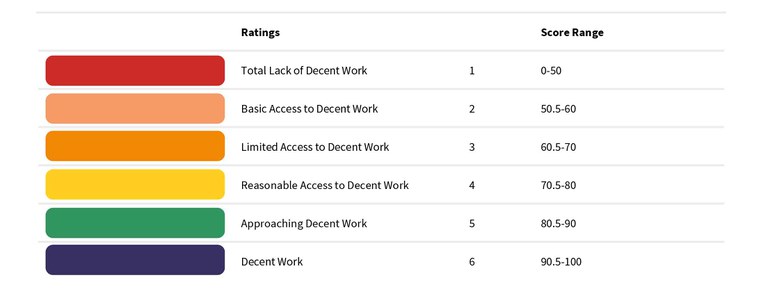
1 - Total Lack of Decent Work
Decent work deficits are rife in countries with a rating of 1 (Total Lack of Decent Work). The national/local legislation barely meets the international standard on even half of the 46 evaluation criteria. There is an absence of minimal labour rights under the legislation. Workers are deprived of access to decent work in nearly every aspect of working life.
2 - Basic Access to Decent Work
Minimal labour rights are provided under the legislation in countries with a rating of 2 (Basic Access to Decent Work). There are systematic violations of workplace rights through statutory means. Workers have nominal access to decent work in a few aspects of working life only. The national/local legislation does not meet the international standard on nearly 20 of the 46 evaluation criteria.
3 - Limited Access to Decent Work
Restricted labour rights are provided under the legislation in countries with a rating of 3 (Limited Access to Decent Work). Workers have access to decent work in limited aspects of working life only. The national/local legislation does not meet the international standard on nearly 18 of the 46 evaluation criteria.
4 - Reasonable Access to Decent Work
Generally, labour rights are reasonably provided under the legislation in countries with a rating of 4 (Reasonable Access to Decent Work). Workers have fair access to decent work in some aspects of working life. The countries with this rating have scored Yes on at least 33 of the 46 evaluation criteria.
5 - Approaching Decent Work
Countries with a rating of 5 (Approaching Decent Work) have generally a lower level of labour rights than those with a rating of 6. Countries with this rating have scored Yes on at least 37 of the 46 evaluation criteria. Most labour rights are provided under the legislation. Workers have frequent access to decent work in most aspects of working life.
6 - Decent Work
Almost all labour rights, as covered by the Index, are provided under the legislation in countries with a ranking of 6(Decent Work). Workers have regular access to decent work in nearly every aspect of working life. Reforms in labour legislation in a couple of areas can improve the statutory rights further.
What is Next?
In the upcoming editions of the Labour Rights Index, we plan to include the following components: Provision of daycare/childcare centres at the workplace; fair treatment of part- time workers equivalent to comparable full-time workers with respect to different aspects of employment; the labour inspection system; prohibition of worst forms of child labour; establishment of social dialogue or tripartite mechanism to discuss labour market issues at the economy level.
The establishment of a vibrant labour inspection system and social dialogue mechanism with due representation from all relevant stakeholders is important from a governance viewpoint. While these are not directly associated with workers’ rights, these make the attainment of workers’ rights easier by simplifying the processes and removing any institutional hurdles.
It is also planned to extend the coverage to 145 countries. These mainly include countries from Central Asia, Sub-Saharan Africa, and some South American countries. Any future legal updates which lead to changes in the scores will also be included.
How to Read the Country Profiles
The Country Profiles section shows a two-page profile for each of the 135 countries covered in the Labour Rights Index 2022. The country profiles are informative about the major aspects of labour legislation in an economy.
Performance Overview
In this section, the performance of a country in the Labour Rights Index is illustrated. On the top right of the page, the overall average score (out of 100) and rating (out of six categories) give a snapshot of a country’s standing in the Labour Rights Index. The top right of the page also shows the overall score in 2020, along with region and income group information.
The overall scores benchmark countries with respect to regulatory best practices, as identified in the relevant ILO Conventions, thereby indicating the proximity to the regulatory standard on each component. Each country is allocated ratings according to its overall score. The ratings follow a certain coding; [90.5-100] Decent Work (Blue), [80.5- 90] Approaching Decent Work (Green), [70.5-80] Reasonable Access to Decent Work (Yellow), [60.5- 70] Limited Access to Decent Work (Orange), [50.5- 60] Basic Access to Decent Work (Peach), [0-50] Total Lack of Decent Work (Red).
The Contextual Indicators of the country provide a picture of the economy and its labour force at a glance. These facts include Population, Labour Force, GDP per Capita, Poverty Headcount, Informal Employment, Total Fertility rate, Trade Union Density, Collective Bargaining Coverage, Social Protection Coverage, Labour Income Share, Female Labour Force (absolute number and participation rate), Non-Standard Employment (Part-Time Employment-A and Temporary Employment-B), Work Injuries (Fatal and Non-Fatal), Minimum Wage, and number of Workers per Labour Inspector. The contextual indicators have been sourced from International Labour Organization, World Bank data, and the WageIndicator’s own Minimum Wages Database.
The first page also introduces the Index and gives information about the average regional score and the highest scoring country in the region.
The overall score and each of the indicators are denoted by different colours; Overall score (Grey), Fair Wages (Teal), Decent Working Hours (Blue), Employment Security (Violet), Family Responsibilities (Purple), Maternity at Work (Red), Safe Work (Pink), Social Security (Orange), Fair Treatment (Brown), Child & Forced Labour (Yellow), Trade Union (Green). To read about the scoring methodology, refer to the chapter on Indicators for Decent Work.
The second page of the country profile shows the decent work indicators of the Labour Rights Index and the answer for each component, along with its legal basis. It is a step toward ensuring greater transparency in the scoring of the countries. The last column shows the trend over the previous two years (2020 to 2022); if the score increased due to a positive reform, it decreased due to a legislative reform or if the score was adjusted to increased availability and access to more legal information about the country. A total of 46 components are shown under the 10 indicators for each of the 135 countries in the Labour Rights Index.
The end of the second page also shows Covid-19 and labour market related information about the country. The data on covid cases, deaths and vaccinations is as on 19 July 2022 and is taken from Our World in Data.[43] The labour market and social protection measures are sourced from the February 2022 edition of the World Bank study, “Social Protection and Jobs Responses to COVID-19: A Real- Time Review of Country Measures”.[44]
It must, however, be mentioned that for data regarding COVID-19 and labour market regulations and COVID-19 cases in countries, we have mostly relied on World Bank and Our World in Data, respectively. It can be the case that in countries with good protection of sick leave, job security and the like, the laws also protect against COVID-19, yet this is not reflected in the data from the World Bank. The information regarding COVID-19 and labour issues does not affect the countries scoring and rating. If you have any questions about a country and the data provided, please contact the team.
Sample Country Profile
Kenya
Country profiles for all 135 countries are available for download on http://labourrightsindex.org/

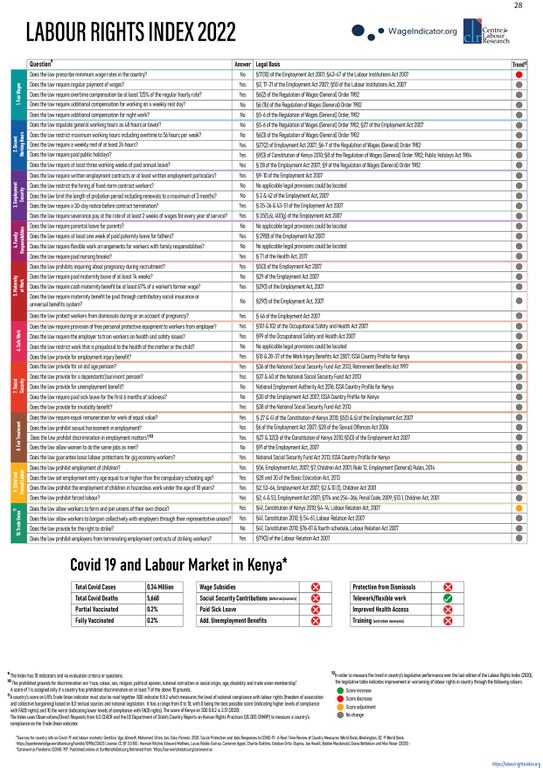
Section 3 SCORES AND RANKINGS
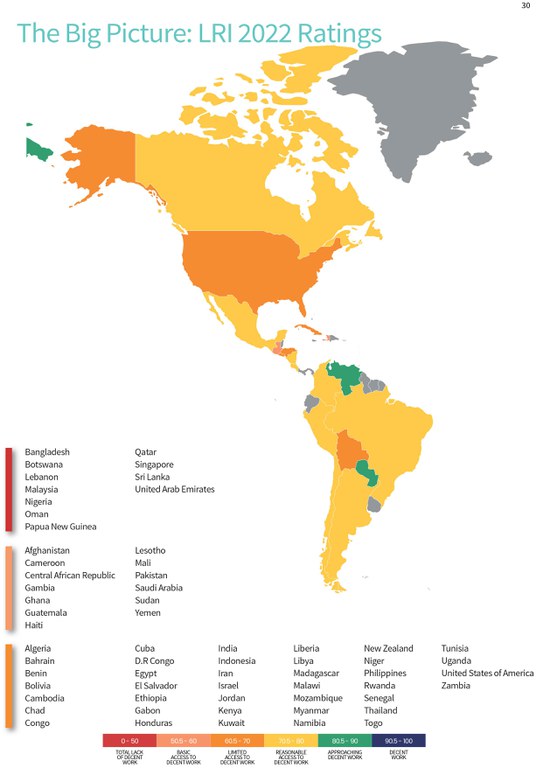
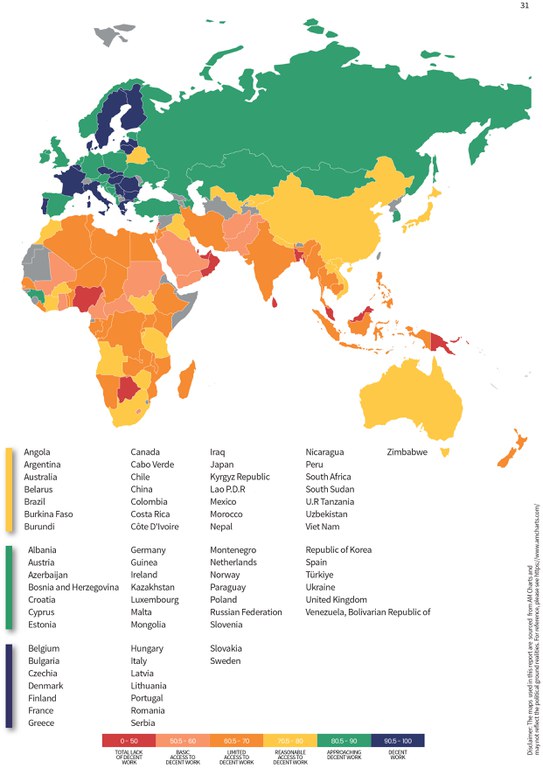
Overview of Overall Scores and Rankings
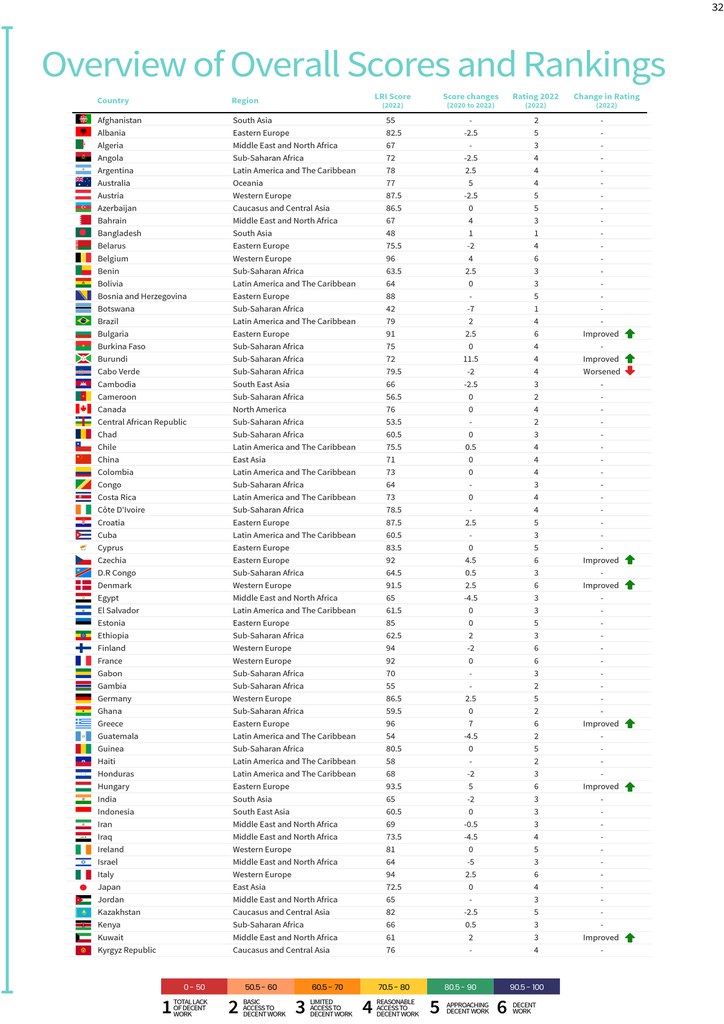
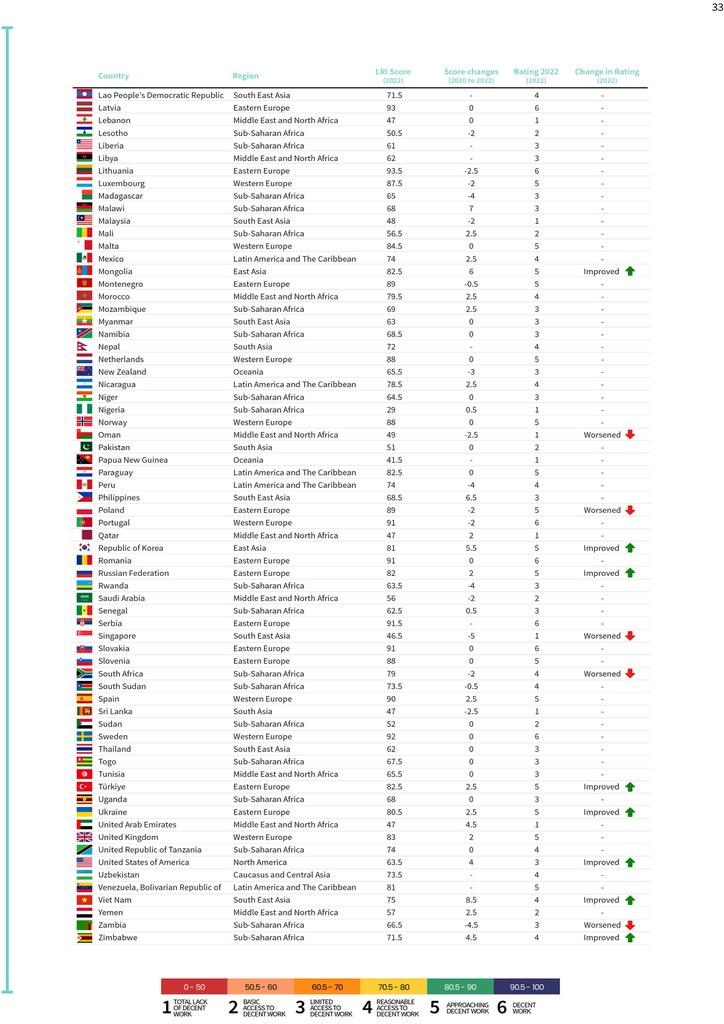
A Regional Overview
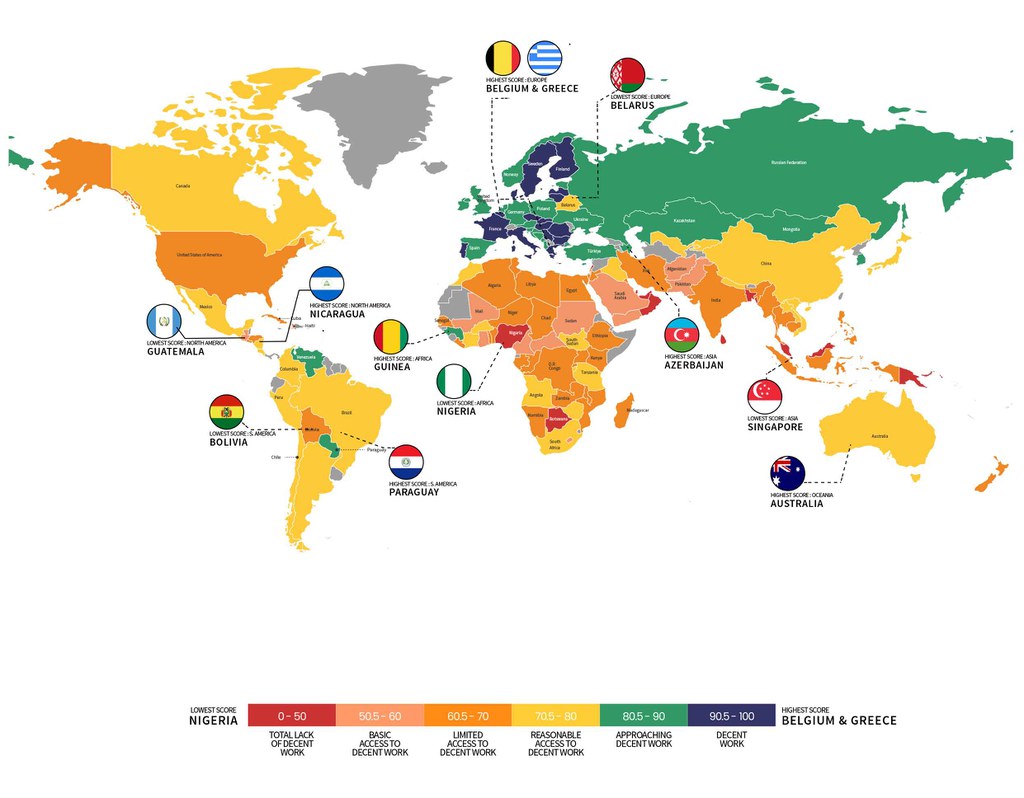
Disclaimer: The maps used in this report are sourced from AM Charts and
may not reflect the political ground realities. For reference, please see https://www.amcharts.com/
GEOGRAPHICAL COVERAGE AND REGIONAL COMPARISON
| Region | Number of Countries |
| Caucasus and Central Asia | 4 |
| East Asia | 4 |
| Eastern Europe | 21 |
| Latin America and The Caribbean | 16 |
| Middle East and North Africa | 17 |
| North America | 2 |
| Oceania | 3 |
| South Asia | 6 |
| South East Asia | 9 |
| Sub-Saharan Africa | 37 |
| Western Europe | 16 |
CAUCASUS AND CENTRAL ASIA
| Country | Score 2020 | Score 2022 | Rating 2022 | Lowest Indicator Score |
| Azerbaijan | 86.5 | 86.5 | Approaching Decent Work | Family Responsibilities (75); Fair Wages (80); Social Security (80) |
| Kazakhstan | 84.5 | 82 | Approaching Decent Work | Trade Union (50); Fair Treatment (60); Family Responsibilities (75) |
| Kyrgyz Republic | - | 76 | Reasonable Access to Decent Work | Trade Union (25); Employment Security (60) ; Fair Treatment (60) |
| Uzbekistan | - | 73.5 | Reasonable Access to Decent Work | Trade Union (0); Fair Treatment (40); Fair Wages (60) |
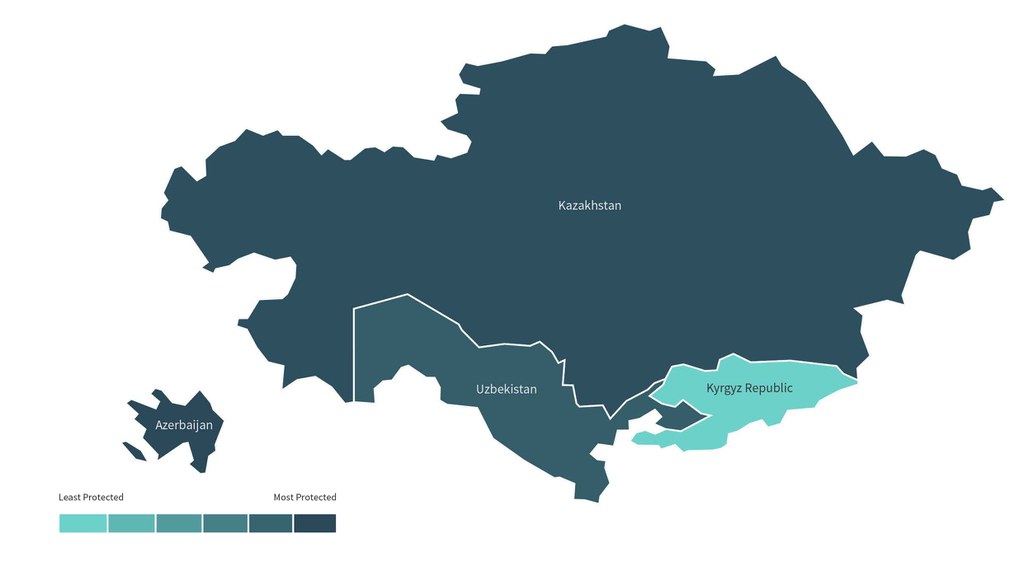
*The column on Lowest Indicator Score shows three indicators on which the country has scored the lowest. These are relatively less protected rights in the country. The number in the bracket indicates the country's score (out of 100) on that specific indicator.
EAST ASIA
| Country | Score 2020 | Score 2022 | Rating 2022 | Lowest Indicator Score |
| China | 71 | 71 | Reasonable Access to Decent Work | Trade Union (0); Fair Treatment (40); Family Responsibilities (50) |
| Japan | 72.5 | 72.5 | Reasonable Access to Decent Work | Employment Security (40) ; Fair Treatment (40); Trade Union (50) |
| Mongolia | 76.5 | 82.5 | Approaching Decent Work | Trade Union (50); Employment Security (60); Fair Wages (60) |
| Republic of Korea | 75.5 | 81 | Approaching Decent Work | Trade Union (50); Fair Treatment (60); Social Security (60) |
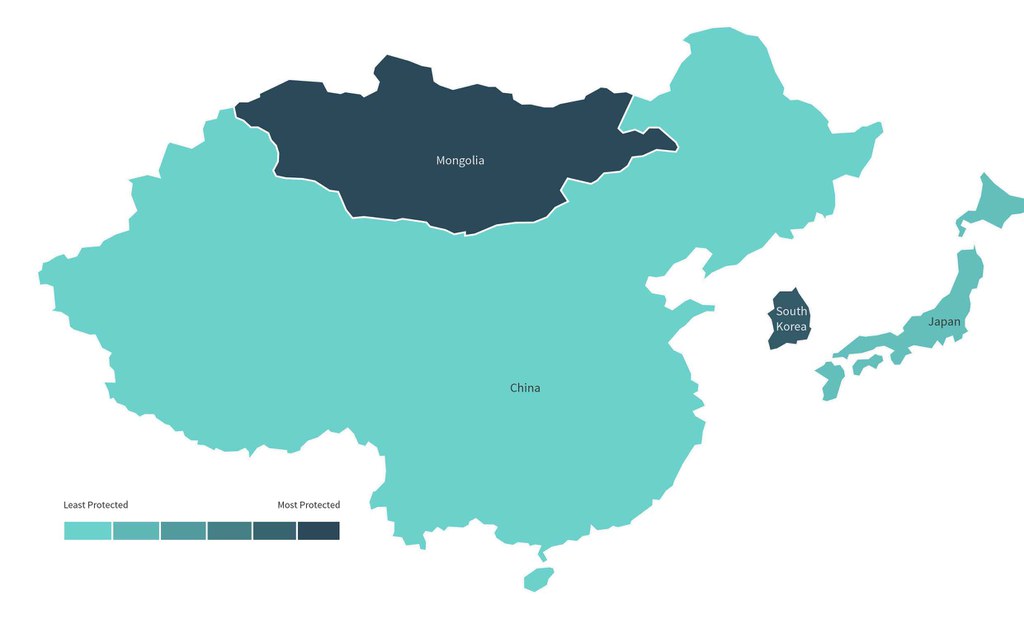
*The column on Lowest Indicator Score shows three indicators on which the country has scored the lowest. These are relatively less protected rights in the country. The number in the bracket indicates the country's score (out of 100) on that specific indicator.
EASTERN EUROPE
| Country | Score 2020 | Score 2022 | Rating 2022 | Lowest Indicator Score |
| Albania | 85 | 82.5 | Approaching Decent Work | Trade Union (50); Employment Security (60) ; Family Responsibilities (75) |
| Belarus | 77.5 | 75.5 | Reasonable Access to Decent Work | Trade Union (50); Family Responsibilities (50); Employment Security (60) |
| Bosnia and Herzegovina | NA | 88 | Approaching Decent Work | Employment Security (40); Fair Treatment (80); Fair Wages (80) |
| Bulgaria | 88.5 | 91 | Decent Work | Trade Union (50); Employment Security (60) |
| Croatia | 85 | 87.5 | Approaching Decent Work | Employment Security (60); Fair Wages (60); Trade Union (75) |
| Cyprus | 83.5 | 83.5 | Approaching Decent Work | Employment Security (40); Fair Wages (40); Family Responsibilities (75) |
| Czechia | 87.5 | 92 | Decent Work | Employment Security (60); Fair Wages (80); Social Security (80) |
| Estonia | 85 | 85 | Approaching Decent Work | Employment Security (40); Family Responsibilities (75); Trade Union (75) |
| Greece | 89 | 96 | Decent Work | Employment Security (80); Fair Wages (80) |
| Hungary | 88.5 | 93.5 | Decent Work | Trade Union (75); Employment Security (80); Fair Wages (80) |
| Latvia | 93 | 93 | Decent Work | Trade Union (75); Child and Forced Labour (75); Employment Security (80) |
| Lithuania | 96 | 93.5 | Decent Work | Trade Union (75); Employment Security (80); Social Security (80) |
| Montenegro | 89.5 | 89 | Approaching Decent Work | Employment Security (60); Trade Union (75); Family Responsibilities (75) |
| Poland | 91 | 89 | Approaching Decent Work | Employment Security (60); Trade Union (75); Child and Forced Labour (75) |
| Romania | 91 | 91 | Decent Work | Trade Union (75); Child and Forced Labour (75) ; Employment Security (80) |
| Russian Federation | 80 | 82 | Approaching Decent Work | Trade Union (50); Fair Treatment (60); Child and Forced Labour (75) |
| Serbia | NA | 91.5 | Decent Work | Employment Security (60); Trade Union (75); Social Security (80) |
| Slovakia | 91 | 91 | Decent Work | Family Responsibilities (50); Employment Security (60) |
| Slovenia | 88 | 88 | Approaching Decent Work | Employment Security (60); Fair Wages (60); Social Security (80) |
| Türkiye | 80 | 82.5 | Approaching Decent Work | Trade Union (50); Fair Wages (60); Child and Forced Labour (75) |
| Ukraine | 78 | 80.5 | Approaching Decent Work | Employment Security (40); Trade Union (50); Fair Treatment (60) |

*The column on Lowest Indicator Score shows three indicators on which the country has scored the lowest. These are relatively less protected rights in the country. The number in the bracket indicates the country's score (out of 100) on that specific indicator.
LATIN AMERICA AND THE CARIBBEAN
| Country | Score 2020 | Score 2022 | Rating 2022 | Lowest Indicator Score |
| Brazil | 77 | 79 | Reasonable Access to Decent Work | Trade Union (25); Family Responsibilities (50); Social Security (60) |
| Chile | 75 | 75.5 | Reasonable Access to Decent Work | Trade Union (25); Fair Treatment (60); Decent Working Hours (60) |
| Colombia | 73 | 73 | Reasonable Access to Decent Work | Trade Union (50); Family Responsibilities (50); Fair Treatment (60) |
| Costa Rica | 73 | 73 | Reasonable Access to Decent Work | Family Responsibilities (25); Trade Union (50); Decent Working Hours (60) |
| Cuba | - | 60.5 | Limited Access to Decent Work | Trade Union (0); Family Responsibilities (25); Employment Security (40) |
| El Salvador | 61.5 | 61.5 | Limited Access to Decent Work | Trade Union (25); Family Responsibilities (25); Social Security (40) |
| Guatemala | 58.5 | 54 | Basic Access to Decent Work | Trade Union (0); Fair Treatment (20); Family Responsibilities (25) |
| Haiti | NA | 58 | Basic Access to Decent Work | Trade Union (0); Family Responsibilities (25); Fair Wages (40) |
| Honduras | 70 | 68 | Limited Access to Decent Work | Trade Union (25); Family Responsibilities (25); Decent Working Hours (60) |
| Mexico | 71.5 | 74 | Reasonable Access to Decent Work | Trade Union (50); Family Responsibilities (50); Decent Working Hours (60) |
| Nicaragua | 76 | 78.5 | Reasonable Access to Decent Work | Family Responsibilities (50); Employment Security (60); Trade Union (75) |
| Paraguay | 82.5 | 82.5 | Approaching Decent Work | Family Responsibilities (50); Employment Security (60); Decent Working Hours (80) |
| Peru | 78 | 74 | Reasonable Access to Decent Work | Fair Wages (40); Family Responsibilities (50); Employment Security (60) |
| Venezuela, Bolivarian Republic of | - | 81 | Approaching Decent Work | Family Responsibilities (50); Trade Union (50); Child and Forced Labour (75) |

*The column on the violated rights shows three indicators on which the country has scored the lowest. These are relatively less protected rights in the country. Number in the bracket shows the score (out of 100) of the country on that specific indicator.
MIDDLE EAST & NORTH AFRICA
| Country | Score 2020 | Score 2022 | Rating 2022 | Lowest Indicator Score |
| Algeria | - | 67 | Limited Access to Decent Work | Family Responsibilities (25); Trade Union (50); Fair Wages (60) |
| Bahrain | 63 | 67 | Limited Access to Decent Work | Trade Union (25); Fair Wages (40); Maternity at Work (40) |
| Egypt | 69.5 | 65 | Limited Access to Decent Work | Trade Union (0); Fair Treatment (40); Family Responsibilities (50) |
| Iran | 69.5 | 69 | Limited Access to Decent Work | Trade Union (0); Maternity at Work (40); Family Responsibilities (50) |
| Iraq | 78 | 73.5 | Reasonable Access to Decent Work | Trade Union (50); Family Responsibilities (50); Maternity at Work (60) |
| Israel | 69 | 64 | Limited Access to Decent Work | Family Responsibilities (0); Safe Work (50); Employment Security (60) |
| Jordan | - | 65 | Limited Access to Decent Work | Trade Union (0); Fair Wages (40); Fair Treatment (60) |
| Kuwait | 59 | 61 | Limited Access to Decent Work | Trade Union (0); Fair Treatment (20); Employment Security (40) |
| Lebanon | 47 | 47 | Total Lack of Decent Work | Trade Union (0); Family Responsibilities (0); Fair Treatment (20) |
| Libya | - | 62 | Limited Access to Decent Work | Trade Union (0); Family Responsibilities (25); Fair Treatment (40) |
| Morocco | 77 | 79.5 | Reasonable Access to Decent Work | Family Responsibilities (25); Fair Treatment (60); Trade Union (70) |
| Oman | 51.5 | 49 | Total Lack of Decent Work | Family Responsibilities (0); Trade Union (0); Fair Treatment (40) |
| Qatar | 45 | 47 | Total Lack of Decent Work | Trade Union (0); Fair Treatment (0); Maternity at Work (20) |
| Saudi Arabia | 58 | 56 | Basic Access to Decent Work | Trade Union (0); Maternity at Work (20); Family Responsibilities (25) |
| Tunisia | 65.5 | 65.5 | Limited Access to Decent Work | Trade Union (25); Employment Security (40); Family Responsibilities |
| United Arab Emirates | 42.5 | 47 | Total Lack of Decent Work | Trade Union (0); Fair Wages (40); Maternity at Work (40); |
| Yemen | 54.5 | 57 | Basic Access to Decent Work | Maternity at Work (20); Fair Treatment (20); Family Responsibilities |
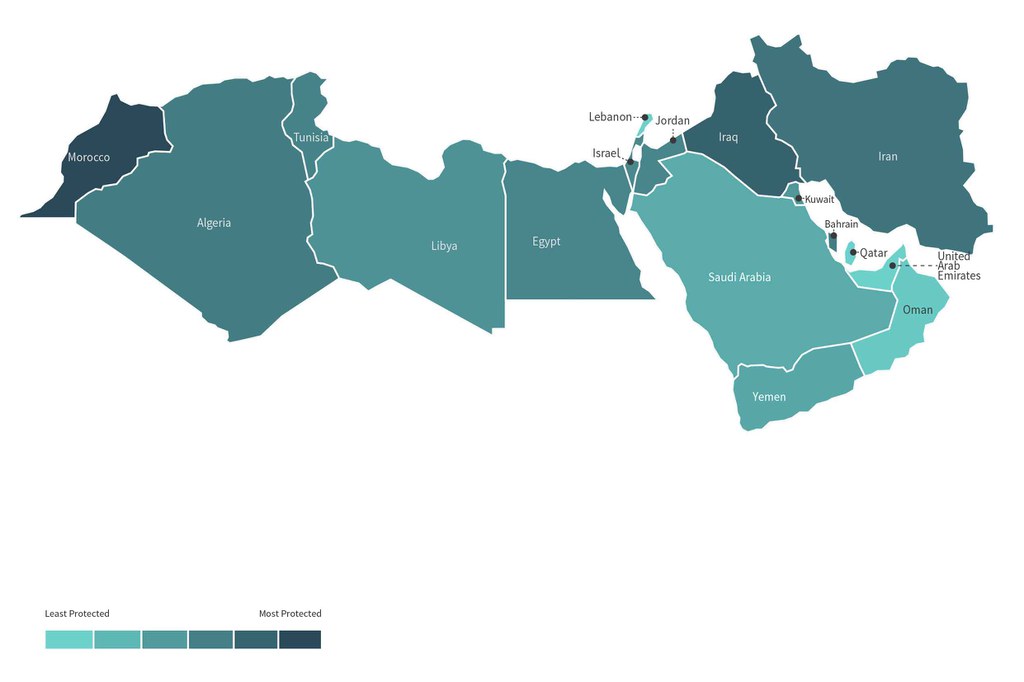
*The column on Lowest Indicator Score shows three indicators on which the country has scored the lowest. These are relatively less protected rights in the country. The number in the bracket indicates the country's score (out of 100) on that specific indicator.
NORTH AMERICA
| Country | Score 2020 | Score 2022 | Rating 2022 | Lowest Indicator Score |
| Canada | 76 | 76 | Reasonable Access to Decent Work | Family Responsibilities (25); Employment Security (40); Social Security (60) |
| United States of America | 59.5 | 63.5 | Limited Access to Decent Work | Employment Security (20); Trade Union (25); Decent Working Hours (40) |
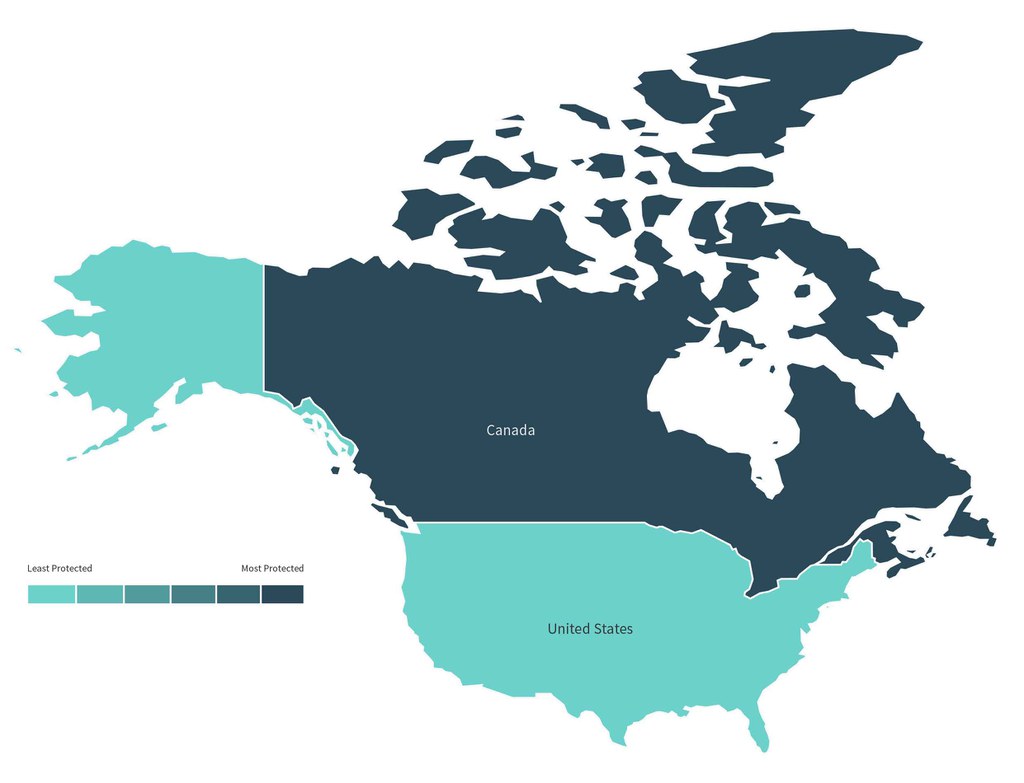
*The column on Lowest Indicator Score shows three indicators on which the country has scored the lowest. These are relatively less protected rights in the country. The number in the bracket indicates the country's score (out of 100) on that specific indicator.
OCEANIA
| Country | Score 2020 | Score 2022 | Rating 2022 | Lowest Indicator Score |
| Australia | 72 | 77 | Reasonable Access to Decent Work | Employment Security (20); Social Security (40); Family Responsibilities (75) |
| New Zealand | 68.5 | 65.5 | Limited Access to Decent Work | Fair Wages (20); Family Responsibilities (25); Employment Security (40) |
| Papua New Guinea | - | 41.5 | Total Lack of Decent Work | Fair Wages (20); Maternity at Work (20); Family Responsibilities (25) |
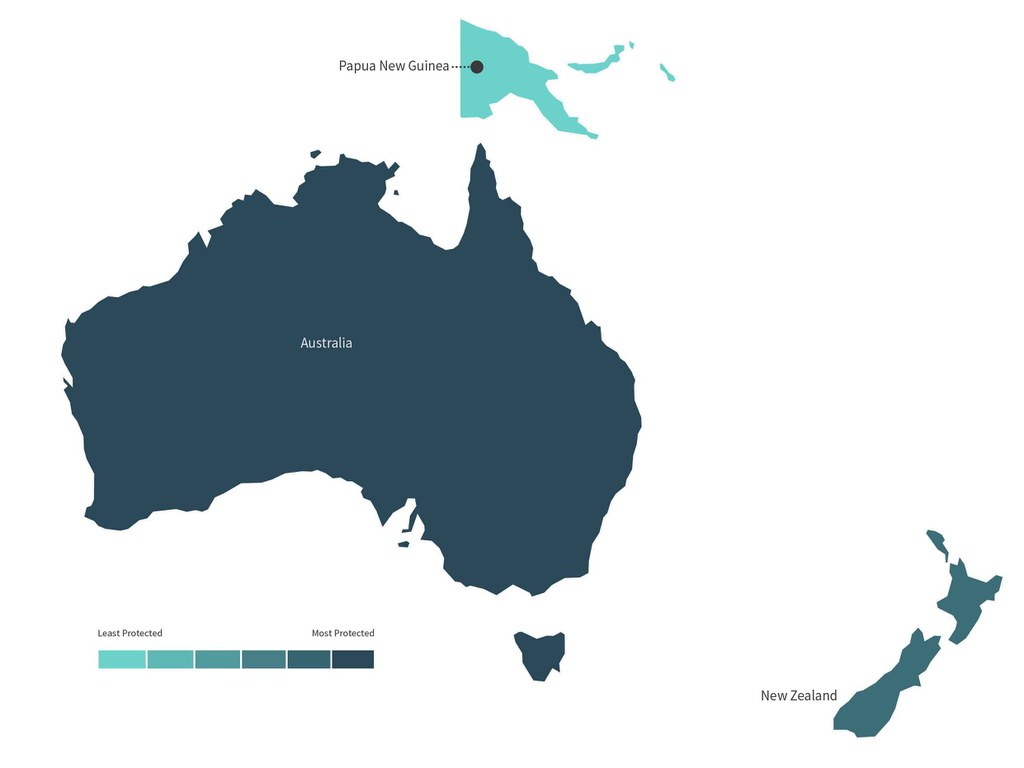
*The column on Lowest Indicator Score shows three indicators on which the country has scored the lowest. These are relatively less protected rights in the country. The number in the bracket indicates the country's score (out of 100) on that specific indicator.
SOUTH ASIA
| Country | Score 2020 | Score 2022 | Rating 2022 | Lowest Indicator Score |
| Afghanistan | - | 55 | Basic Access to Decent Work | Trade Union (0); Fair Treatment (20); Fair Wages (40) |
| Bangladesh | 47 | 48 | Total Lack of Decent Work | Social Security (0); Family Responsibilities (0); Fair Treatment (20) |
| India | 67 | 65 | Limited Access to Decent Work | Fair Treatment (20); Trade Union (25); Employment Security (40) |
| Nepal | - | 72 | Reasonable Access to Decent Work | Maternity at Work (40); Family Responsibilities (50); Trade Union (50) |
| Pakistan | 51 | 51 | Basic Access to Decent Work | Family Responsibilities (0); Trade Union (0); Fair Treatment (20) |
| Sri Lanka | 49.5 | 47 | Total Lack of Decent Work | Trade Union (0); Family Responsibilities (25); Maternity at Work (40) |
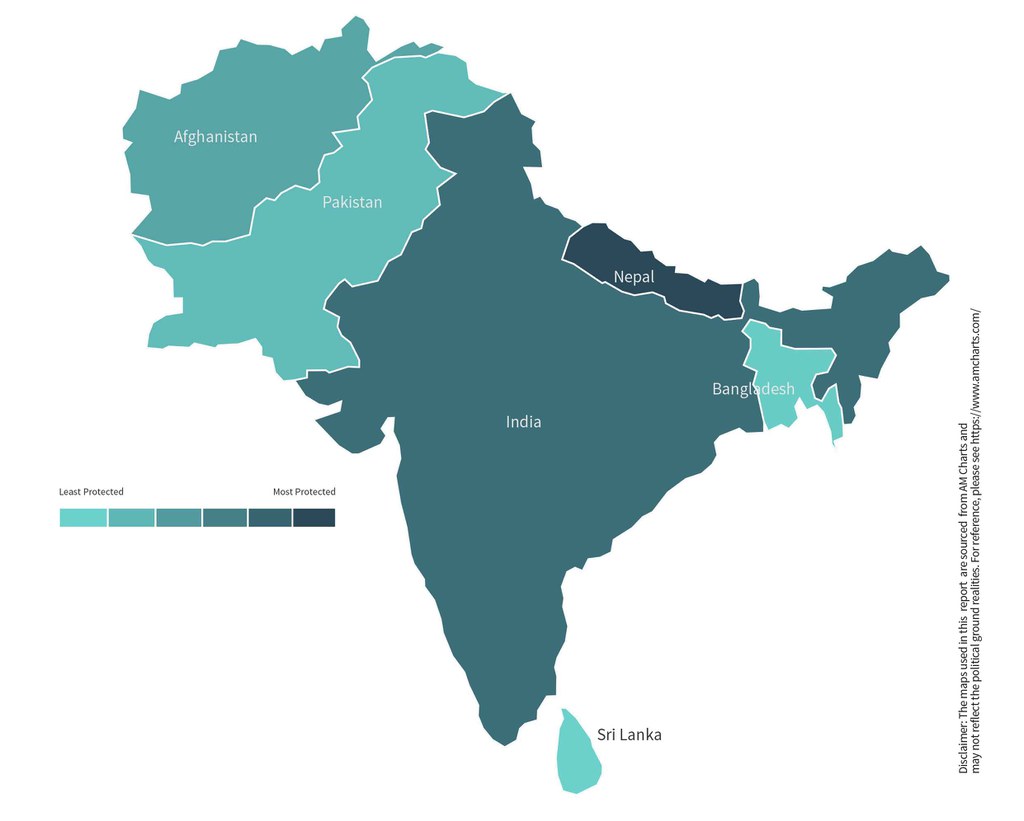
*The column on Lowest Indicator Score shows three indicators on which the country has scored the lowest. These are relatively less protected rights in the country. The number in the bracket indicates the country's score (out of 100) on that specific indicator.
SOUTH EAST ASIA
| Country | Score 2020 | Score 2022 | Rating 2022 | Lowest Indicator Score |
| Cambodia | 68.5 | 66 | Limited Access to Decent Work | Trade Union (25); Family Responsibilities (25); Fair Treatment (60); |
| Indonesia | 60.5 | 60.5 | Limited Access to Decent Work | Trade Union (0); Family Responsibilities (25); Maternity at Work (40) |
| Lao PDR | - | 71.5 | Reasonable Access to Decent Work | Fair Wages (40); Trade Union (50); Family Responsibilities (50) |
| Malaysia | 50 | 48 | Total Lack of Decent Work | Trade Union (0); Family Responsibilities (0); Fair Treatment (20) |
| Myanmar | 63 | 63 | Limited Access to Decent Work | Fair Treatment (20) ; Family Responsibilities (25) ; Trade Union (50) |
| Philippines | 62 | 68.5 | Limited Access to Decent Work | Trade Union (25); Family Responsibilities (50); Fair Treatment (60); |
| Singapore | 51.5 | 46.5 | Total Lack of Decent Work | Employment Security (20); Trade Union (25); Family Responsibilities (25); |
| Thailand | 62 | 62 | Limited Access to Decent Work | Trade Union (25); Maternity at Work (60); Employment Security (60); |
| Viet Nam | 66.5 | 75 | Reasonable Access to Decent Work | Trade Union (25); Family Responsibilities (50); Employment Security (60) |

*The column on Lowest Indicator Score shows three indicators on which the country has scored the lowest. These are relatively less protected rights in the country. The number in the bracket indicates the country's score (out of 100) on that specific indicator.
SUB SAHARAN AFRICA
| Country | Score 2020 | Score 2022 | Rating 2022 | Lowest Indicator Score |
| Angola | 74.5 | 72 | Reasonable Access to Decent Work | Social Security (40); Family Responsibilities (50); Trade Union (50) |
| Benin | 61 | 63.5 | 63.5 Limited Access to Decent Work | Fair Wages (20); Family Responsibilities (25) ; Employment Security (40) |
| Botswana | 49 | 42 | Total Lack of Decent Work | Maternity at Work (0); Employment Security (0); Trade Union (25) |
| Burkina Faso | 75 | 75 | Reasonable Access to Decent Work | Employment Security (40); Family Responsibilities (50); Social Security (60) |
| Burundi | 60.5 | 72 | Reasonable Access to Decent Work | Family Responsibilities (25); Maternity at Work (40); Employment Security (60) |
| Cabo Verde | 81.5 | 79.5 | Reasonable Access to Decent Work | Family Responsibilities (25); Maternity at Work (60); Trade Union (75) |
| Cameroon | 56.5 | 56.5 | Basic Access to Decent Work | Family Responsibilities (25); Trade Union (25); Fair Wages (40) |
| Central African Republic | NA | 53.5 | Basic Access to Decent Work | Family Responsibilities (25); Trade Union (25); Maternity at Work (40) |
| Chad | 60.5 | 60.5 | Limited Access to Decent Work | Fair Wages (20); Family Responsibilities (25); Fair Treatment (40) |
| Congo | NA | 64 | Limited Access to Decent Work | Family Responsibilities (25); Fair Wages (40); Fair Treatment (40) |
| Côte D'Ivoire | NA | 78.5 | Reasonable Access to Decent Work | Family Responsibilities (25); Fair Wages (60); Fair Treatment (60) |
| Democratic Republic of the Congo | 64 | 64.5 | Limited Access to Decent Work | Family Responsibilities (25); Trade Union (25); Employment Security (40) |
| Ethiopia | 60.5 | 62.5 | Limited Access to Decent Work | Family Responsibilities (0); Trade Union (25); Decent Working Hours (60) |
| Gabon | NA | 70 | Limited Access to Decent Work | Fair Wages (20); Family Responsibilities (25); Fair Treatment (60) |
| Gambia | NA | 55 | Basic Access to Decent Work | Fair Wages (20); Family Responsibilities (25); Employment Security (40) |
| Ghana | 59.5 | 59.5 | Basic Access to Decent Work | Employment Security (20); Family Responsibilities (25); Fair Wages (40) |
| Guinea | 80.5 | 80.5 | Approaching Decent Work | Family Responsibilities (50); Fair Treatment (60); Trade Union (70) |
| Kenya | 65.5 | 66 | Limited Access to Decent Work | Fair Wages (40); Family Responsibilities (50); Decent Working Hours (60) |
| Lesotho | 52.5 | 50.5 | Basic Access to Decent Work | Family Responsibilities (25); Trade Union (25); Fair Wages (40) |
| Liberia | NA | 61 | Limited Access to Decent Work | Fair Wages (20); Trade Union (25); Family Responsibilities (50) |
| Madagascar | 69 | 65 | Limited Access to Decent Work | Family Responsibilities (25); Trade Union (25); Social Security (60) |
| Malawi | 61 | 68 | Limited Access to Decent Work | Social Security (0); Family Responsibilities (50); Maternity at Work (60) |
| Mali | 54 | 56.5 | Basic Access to Decent Work | Family Responsibilities (25); Fair Treatment (40); Fair Wages (40) |
| Mozambique | 66.5 | 69 | Limited Access to Decent Work | Family Responsibilities (25); Trade Union (25); Maternity at Work (60) |
| Namibia | 68.5 | 68.5 | Limited Access to Decent Work | Family Responsibilities (0); Employment Security (20); Trade Union (50) |
| Niger | 64.5 | 64.5 | Limited Access to Decent Work | Family Responsibilities (25); Trade Union (25); Social Security (60) |
| Nigeria | 28.5 | 29 | Total Lack of Decent Work | Social Security (0); Trade Union (20); Maternity at Work (20) |
| Rwanda | 67.5 | 63.5 | Limited Access to Decent Work | Family Responsibilities (25); Fair Wages (40); Maternity at Work (40) |
| Senegal | 62 | 62.5 | Limited Access to Decent Work | Family Responsibilities (25); Trade Union (25); Fair Wages (40) |
| South Africa | 81 | 79 | Reasonable Access to Decent Work | Employment Security (40); Family Responsibilities (50); Social Security (60) |
| South Sudan | 74 | 73.5 | Reasonable Access to Decent Work | Trade Union (25); Fair Wages (40); Family Responsibilities (50) |
| Sudan | 52 | 52 | Basic Access to Decent Work | Trade Union (0); Fair Treatment (20); Family Responsibilities (25) |
| Togo | 67.5 | 67.5 | Limited Access to Decent Work | Fair Wages (20); Family Responsibilities (25); Trade Union (50) |
| Uganda | 68 | 68 | Limited Access to Decent Work | Family Responsibilities (0); Maternity at Work (40); Employment Security (40) |
| United Republic of Tanzania | 74 | 74 | Reasonable Access to Decent Work | Family Responsibilities (25); Employment Security (40); Fair Wages (60) |
| Zambia | 71 | 66.5 | Limited Access to Decent Work | Family Responsibilities (25); Trade Union (25); Fair Wages (60) |
| Zimbabwe | 67 | 71.5 | Reasonable Access to Decent Work | Family Responsibilities (50); Trade Union (50); Social Security (60) |
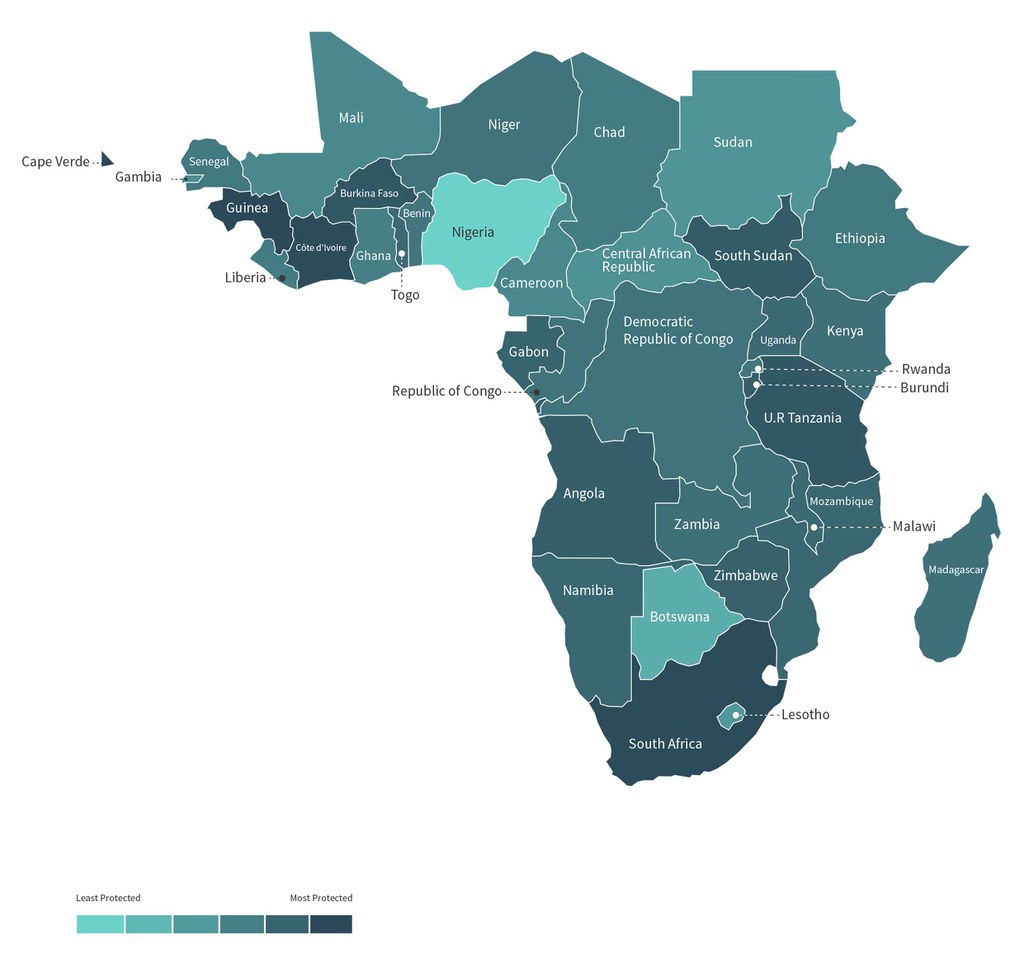
*The column on Lowest Indicator Score shows three indicators on which the country has scored the lowest. These are relatively less protected rights in the country. The number in the bracket indicates the country's score (out of 100) on that specific indicator.
WESTERN EUROPE
| Country | Score 2020 | Score 2022 | Rating 2022 | Lowest Indicator Score |
| Austria | 90 | 87.5 | Approaching Decent Work | Employment Security (40); Trade Union (75); Fair Treatment (80) |
| Belgium | 92 | 96 | Decent Work | Employment Security (80); Social Security (80) |
| Denmark | 89 | 91.5 | Decent Work | Employment Security (60); Family Responsibilities (75); Social Security (80) |
| Finland | 96 | 94 | Decent Work | Employment Security (40) |
| France | 92 | 92 | Decent Work | Employment Security (60); Social Security (80); Fair Wages (80) |
| Germany | 84 | 86.5 | Approaching Decent Work | Trade Union (50); Family Responsibilities (75); Employment Security (80) |
| Ireland | 81 | 81 | Approaching Decent Work | Employment Security (40); Fair Wages (40); Family Responsibilities (75) |
| Italy | 91.5 | 94 | Decent Work | Employment Security (60); Fair Wages (80) |
| Luxembourg | 89.5 | 87.5 | Approaching Decent Work | Employment Security (60); Social Security (60); Family Responsibilities (75) |
| Malta | 84.5 | 84.5 | Approaching Decent Work | Family Responsibilities (25); Employment Security (40); Fair Wages (80) |
| Netherlands | 88 | 88 | Approaching Decent Work | Fair Wages (40); Employment Security (80); Decent Working Hours (80) |
| Norway | 88 | 88 | Approaching Decent Work | Social Security (40); Employment Security (60) ; Fair Wages (80) |
| Portugal | 93 | 91 | Decent Work | Employment Security (60); Trade Union (75); Child and Forced Labour (75) |
| Spain | 87.5 | 90 | Approaching Decent Work | Fair Wages (40); Employment Security (80); Social Security (80) |
| Sweden | 92 | 92 | Decent Work | Employment Security (60); Social Security (80); Maternity at Work (80) |
| United Kingdom | 81 | 83 | Approaching Decent Work | Employment Security (40); Trade Union (50); Fair Wages (60) |
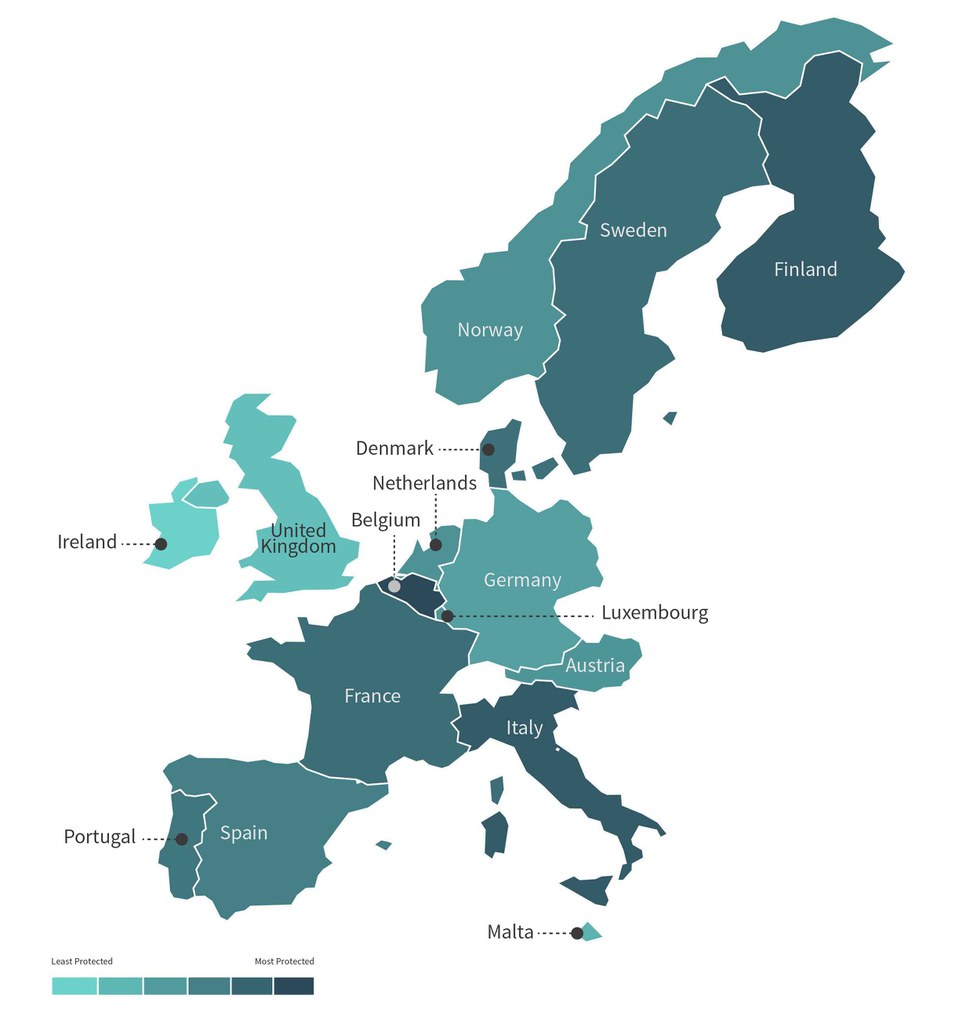
*The column on Lowest Indicator Score shows three indicators on which the country has scored the lowest. These are relatively less protected rights in the country. The number in the bracket indicates the country's score (out of 100) on that specific indicator.
Section 4 INDICATORS FOR DECENT WORK
Fair Wages
The Fair Wages indicator measures whether the law stipulates minimum wages or whether the wages are determined through collective bargaining. It also measures whether wages are paid in a regular and timely manner. Additionally, it evaluates 135 jurisdictions on their compliance to International Regulatory Standards on overtime and night work premium alongside the provision of a compensatory rest day for those working on a weekly rest day.
1.1 Minimum Wage
Does the law prescribe a minimum wage rate in the country?
International Regulatory Standard
Article 23 (3) of the Universal Declaration of Human Rights and Article 3 of the Minimum Wage Fixing Convention 1970 (No. 131), and Article 7 of the International Covenant on Economic, Social and Cultural Rights (Fair Wage clauses) require that all workers have the right to just and favourable remuneration so that workers are ensured fair wages and decent living. While determining the minimum wages, the needs of workers and their families alongside economic factors must be considered.
Methodology
Whether labour legislation sets the minimum wage:
1: Labour legislation, negotiation between parties or bargaining at the sectoral or national level sets the minimum wage. The minimum wage must have been updated at least once during the past two years (with reference to January 2020).
0: No provision in legislation on minimum wage or in the absence of statutory minimum wage, there is no sectoral bargaining. The minimum wage has not been updated in the past two years.
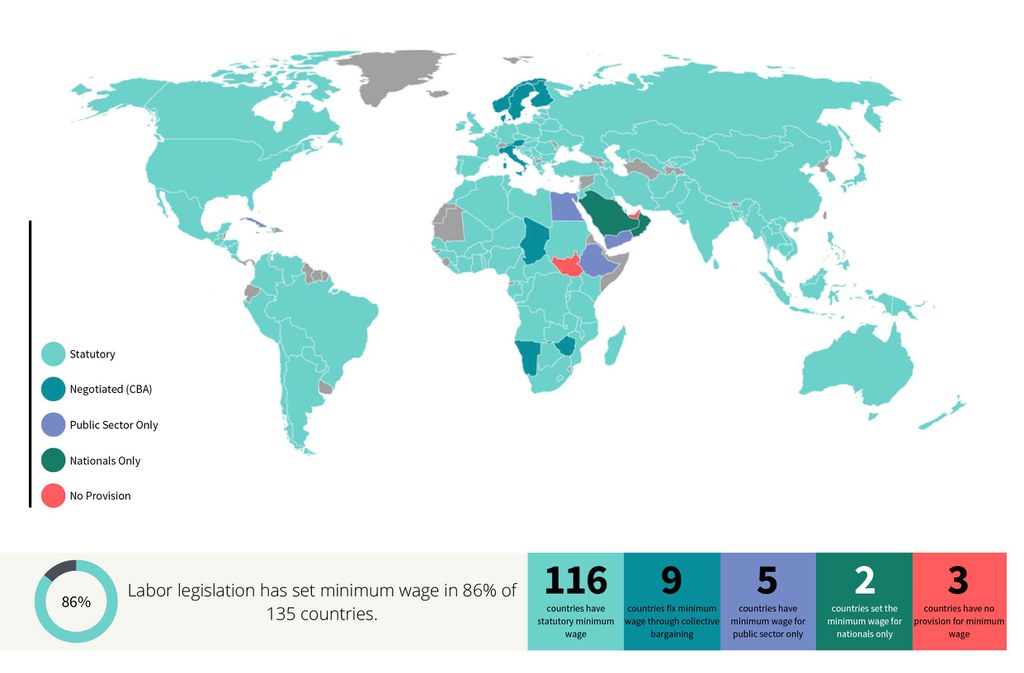
1.2 Regular Wage
Does the law require regular and timely payment of wages?
International Regulatory Standard
Article 12 (1) in Protection of Wages Convention 1949 (No. 95) and Article 11 (6) of Social Policy (Basic Aims and Standards) Convention 1962 (No. 117) state that wages should be paid regularly or at regular intervals (to reduce the likelihood of a worker becoming indebted) which need to be fixed in national laws or regulations or by collective agreements, except where other suitable arrangements are provided which ensure wages payment at regular intervals. The legislation must set a time limit within which wages must be paid after the completion of a wage period.
Methodology
Whether labour legislation requires regular and timely payment of wages:
1: Labour legislation requires employers to ensure regular and timely payment of wages. Wage payment periods can be set at the hourly, daily, weekly, fortnightly or monthly levels.
0: The labour legislation does not require employers to ensure regular and timely payment of wages on completion of a wage period.
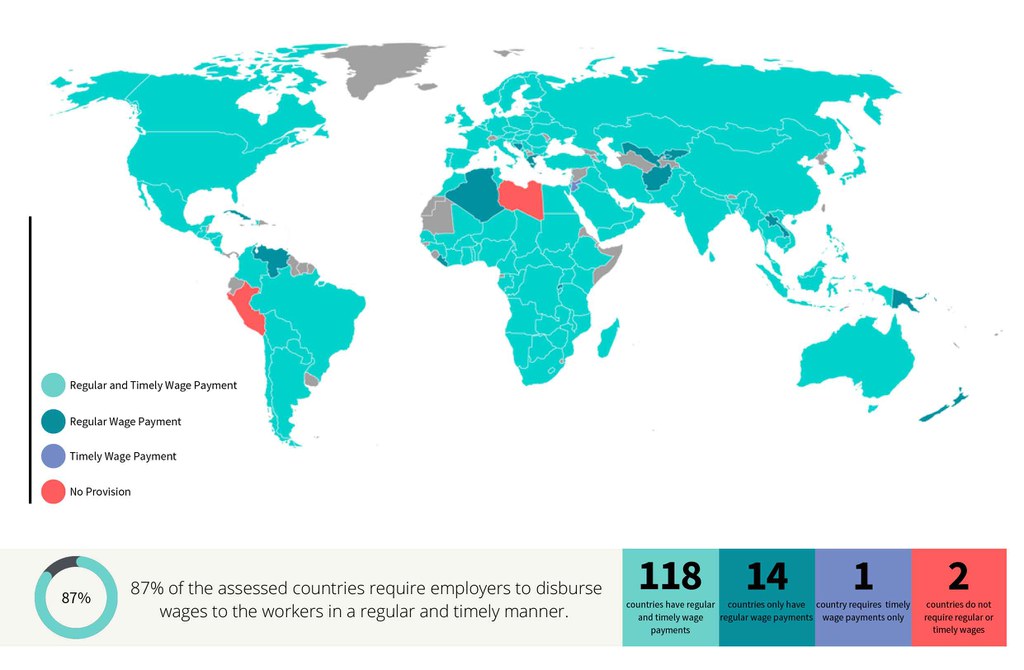
1.3 Overtime Premium
Does the law require overtime compensation to be at least 125% of the regular hourly rate?
International Regulatory Standard
Article 6 of Hours of Work (Industry) Convention 1919 (No. 1) and Article 7 of the Hours of Work (Commerce and Offices) Convention 1930 (No. 30) establishes that workplaces which necessarily have to carry out work after general working hours due to certain reasons such as force majeure, should develop regulations (by public authority and after consultation with employers’ and workers’ organisations where present) which fix the limit of additional hours in each instance and the rate of pay for overtime not less than one and one-quarter times the regular rate.
Methodology
Whether overtime compensation is at least 125% of the regular rate:
1: Monetary compensation for overtime is 125% or more of the regular hourly rate.
0: Overtime compensation is less than 125% of the regular hourly rate.
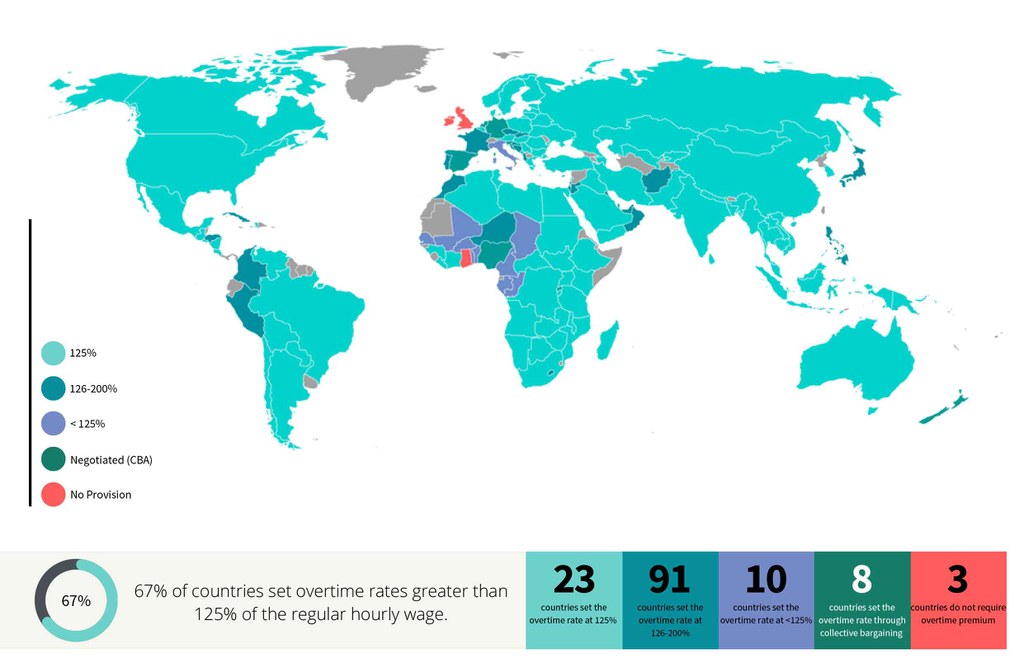
1.4 Weekly Rest Work Compensation
Does the law require additional compensation for working on a weekly rest day?
International Regulatory Standard
Both Article 5 of the Weekly Rest (Industry) Convention, 1921 (No. 14) and Article 8(3) of Weekly Rest (Commerce and Offices) Convention, 1957 (No. 106) state that provision for compensatory rest periods should be granted, with certain temporary exceptions, except in cases where agreements or customs already provide for such periods. Article 8(3) also refers to the provision of a compensatory period of rest of a total duration at least equivalent to a period of twenty-four hours.
Methodology
Whether there is additional compensation for working on a weekly rest day:
1: The legislation requires the provision of a compensatory rest day, or workers are given both the substitute day-off and premium payment.
0: Working on a weekly rest day is compensated with only a premium payment, or employers have the option to provide either a premium payment or a substitute day-off.
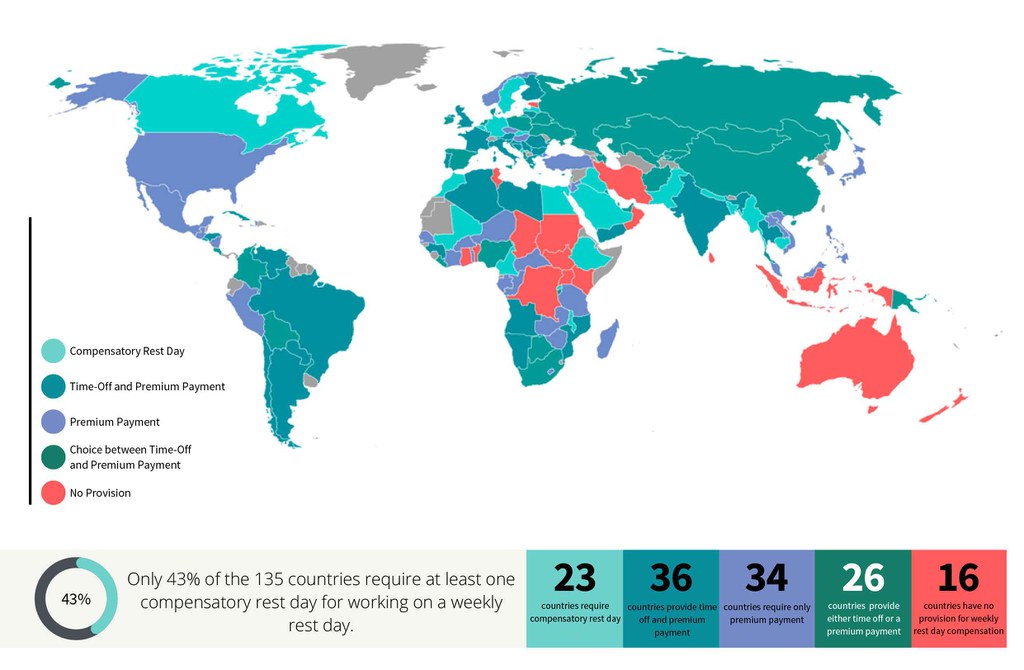
1.5 Night Work Premium
Does the law require additional compensation for night work?
International Regulatory Standard
Night Work Convention, 1990 (No. 171) states in Article 8 that compensation for night workers in the form of working time, pay, or similar benefits shall recognise the nature of night work.
Methodology
Whether there is additional compensation for work during night hours:
1: Monetary compensation is awarded for working night hours or if general working hours for night workers are reduced through shorter shifts or an additional day off.
0: Night work does not lead to a premium payment or a reduction in working hours.
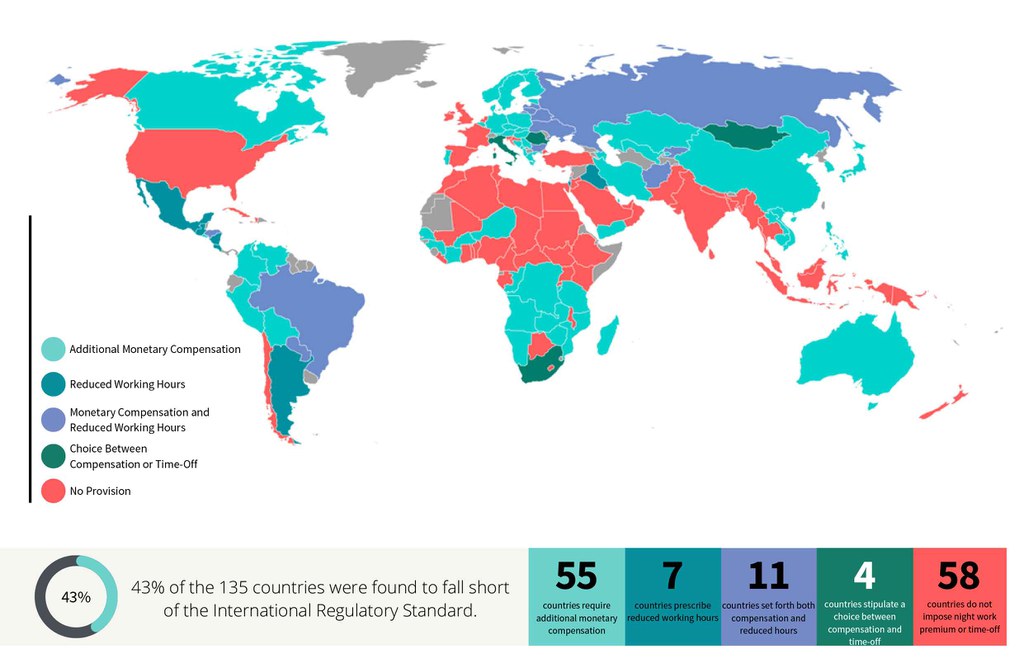
Fair Wages - Snapshot

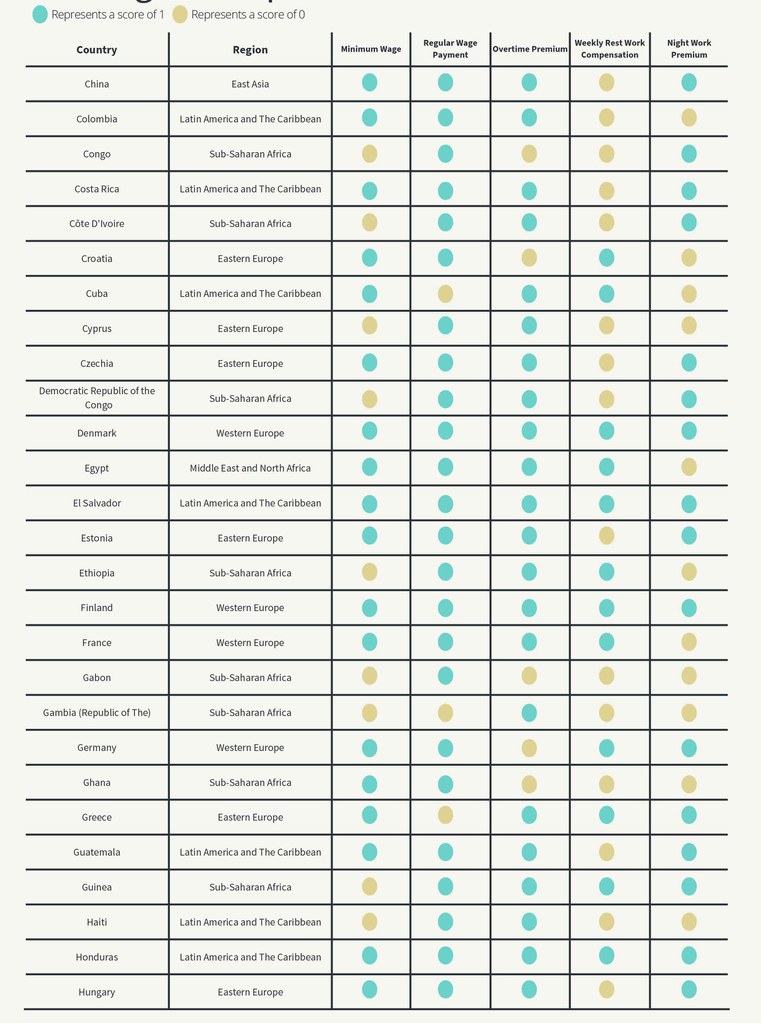
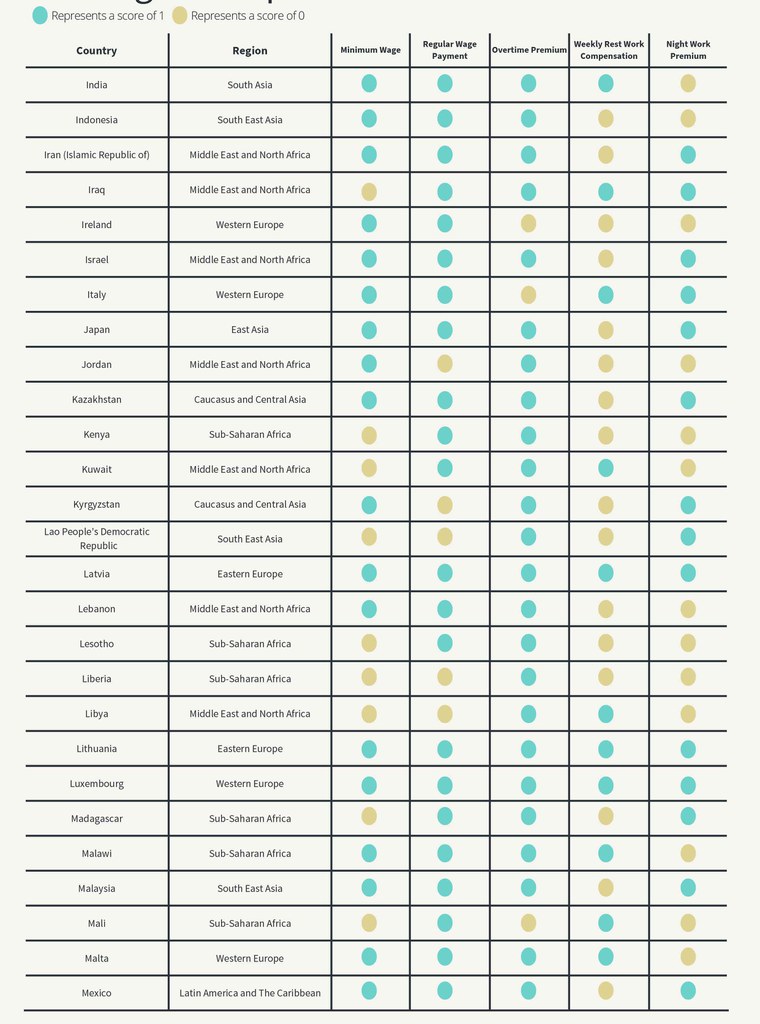
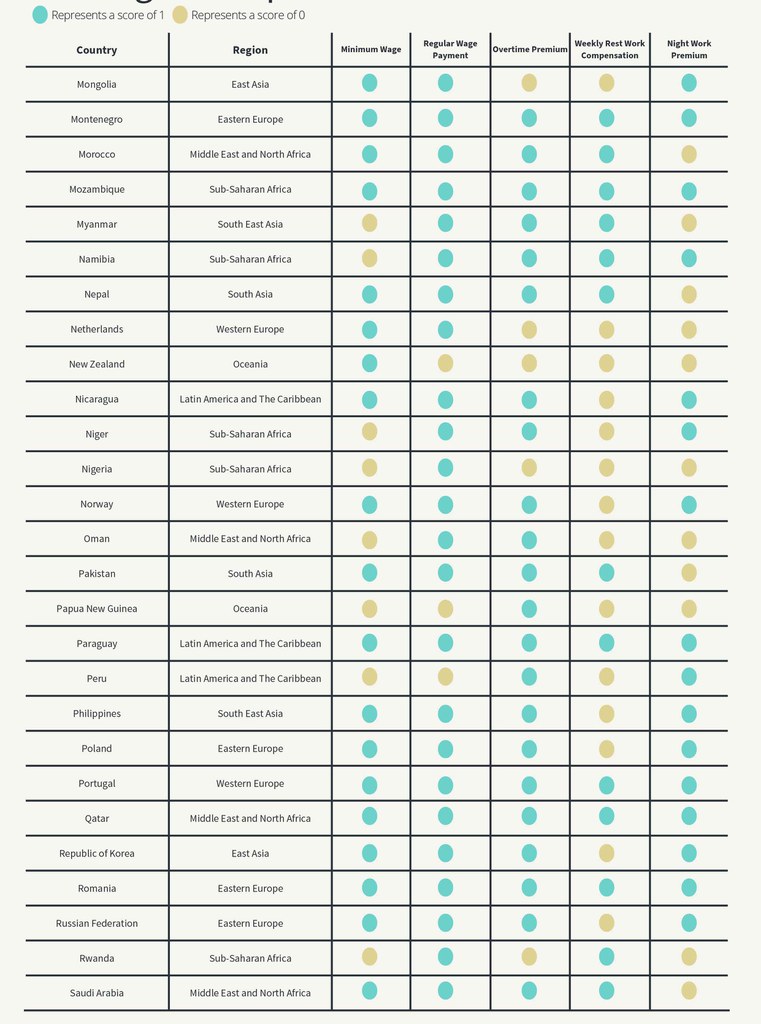
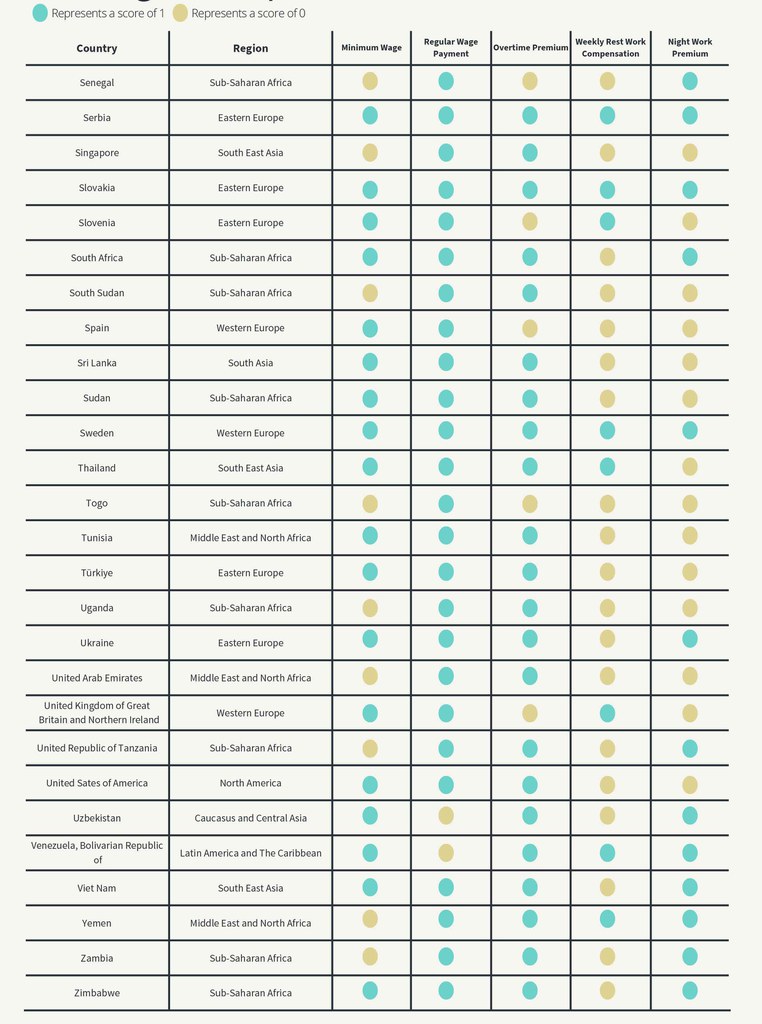
Decent Working Hours
The Decent Working Hours indicator measures whether workers' health and well-being are preserved while ensuring their productivity and motivation.
It assesses the law on working hours, overtime and the paid rest days - weekly rest, public holidays and annual leaves.
2.1 General Weekly Working Hours
Does the law stipulate general working hours as 48 hours or lower?
International Regulatory Standard
- Hours of Work (Industry) Convention 1919 (No. 1)
- Hours of Work (Commerce and Offices) Convention 1930 (No. 30)
- Forty-Hour Week Convention, 1935 (No. 47)
Articles 2 and 3 of C001 and C030 state that the working hours of employed persons should not exceed eight in the day and forty-eight in the week. Article 1 (C047) approves of a forty- hour week which is applied in a way so as not to reduce the living standard. C001 stated the exception; the provision on the forty-eight hours' threshold does not apply to supervisory, management, confidential positions, or whereby law, custom or agreement between employers’ and workers’ organisations or employers’ and workers’ representatives vary the daily hours limit (but not more than nine hours), or where shift workers are employed in excess of eight hours in a day and forty-eight hours in a week if the average hours over three weeks do not exceed eight per day and forty-eight per week.
Methodology
Whether labour legislation limits general working hours to 48 hours per week:
1: General working hours do not exceed 48 hours per week.
0: No restriction on weekly working hours or if general working hours are more than 48 hours per week.
34% of the 135 countries allow 48 hours as the general working hours. Kenya is the only country which sets working hours above 49 hours.
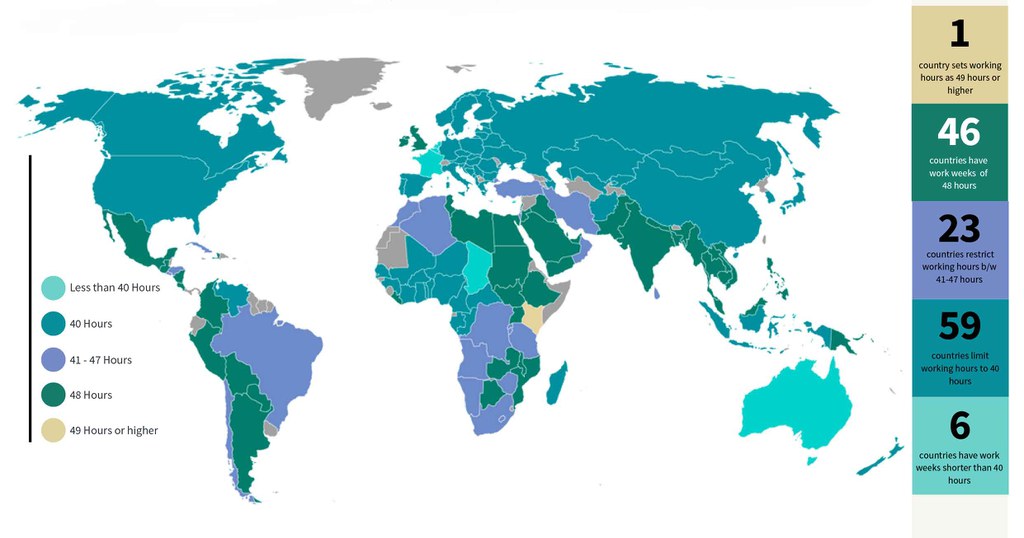
2.2 Maximum Weekly Working Hours
Does the law restrict maximum working hours, including overtime, to 56 hours per week?
International Regulatory Standard
The component, maximum weekly working hours, is grounded in Para 17 of the Reduction of Hours of Work Recommendation, 1962 (No. 116), Article 6(2) of Hours of Work (Industry) Convention 1919 (No. 1) and Article 7(3) of the Hours of Work (Commerce and Offices) Convention 1930 (No. 30).
Recommendation 116 mentions that the competent authority of every country should determine limits to the total number of overtime hours, except for cases of force majeure, worked during a specified period. C001 and C030 make it necessary for regulations (only after consultation with the organisations of employers and workers concerned) to fix the maximum of additional hours in each instance, aside from temporary exceptions, and the overtime pay rate to be not less than one and one-quarter times the regular rate.
Methodology
Whether labour legislation limits maximum working hours to 56 hours per week:
1: Total working hours inclusive of overtime do not exceed 56 hours per week.
0: Total working hours are more than 56 hours per week, or no relevant provision is found in the legislation.
10% of the 135 countries do not set maximum weekly hour limits.
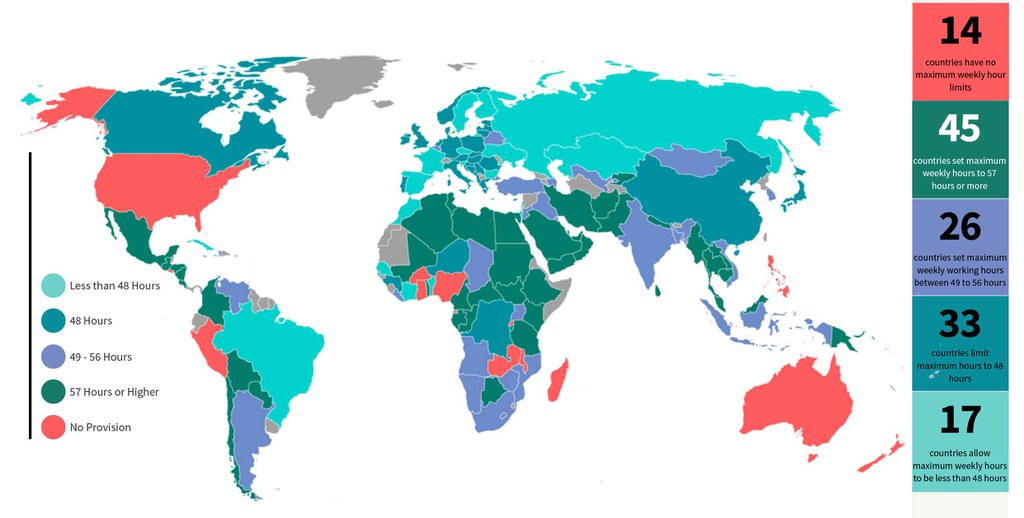
2.3 Weekly Rest Hours
Does the law require a weekly rest of at last 24 consecutive hours?
International Regulatory Standard
Article 2 of Weekly Rest (Industry) Convention 1921 and Article 6 of Weekly Rest (Commerce and Offices) Convention 1957 stipulates that every seven days, a weekly rest (comprising at least 24 consecutive hours) be granted simultaneously to all workers in every establishment. It should be fixed to coincide with the days already established by the traditions or customs of the country or district.
Methodology
Whether the labour legislation requires a weekly rest of at least 24 hours:
1: Workers have the right to a weekly rest of a minimum of 24 consecutive hours.
0: Labour legislation does not require a weekly rest day.
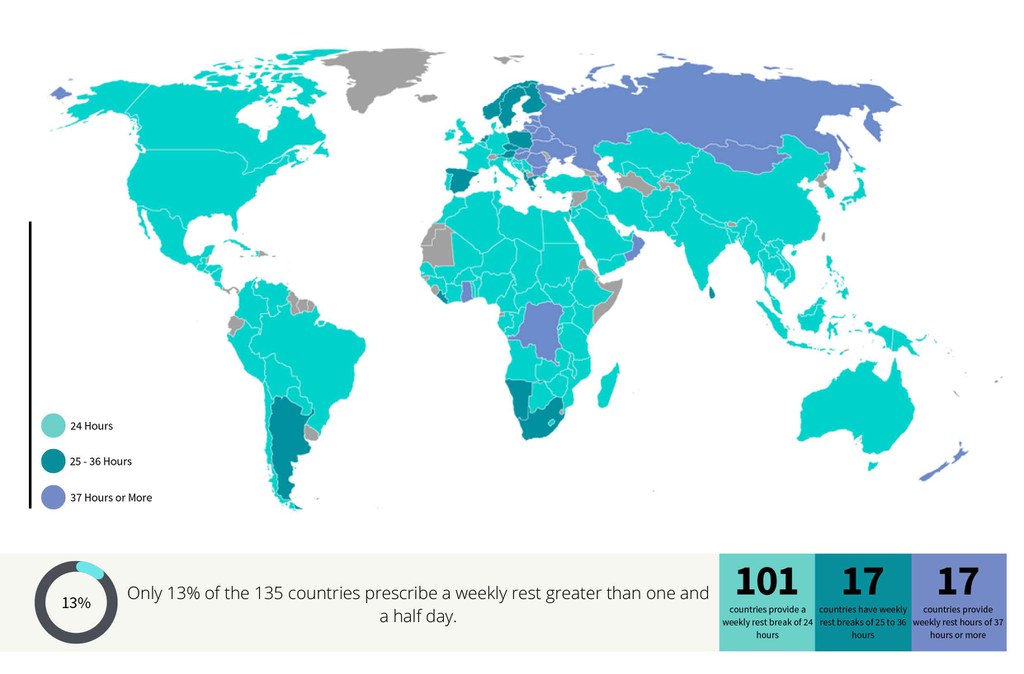
2.4 Paid Public Holidays
Does the law require paid public holidays?
International Regulatory Standard
It is stated in Article 7 (d) of the International Covenant on Economic, Social and Cultural Rights, 1966 that it is the right of everyone to enjoy just and favourable conditions of work that entail rest, leisure and remuneration for public holidays.
Methodology
Whether there are paid public holidays:
1: Legislation regulates paid public holidays, and there is a list of public and official holidays to follow.
0: Labour legislation does not require employers to grant a fully paid day off on public holidays.
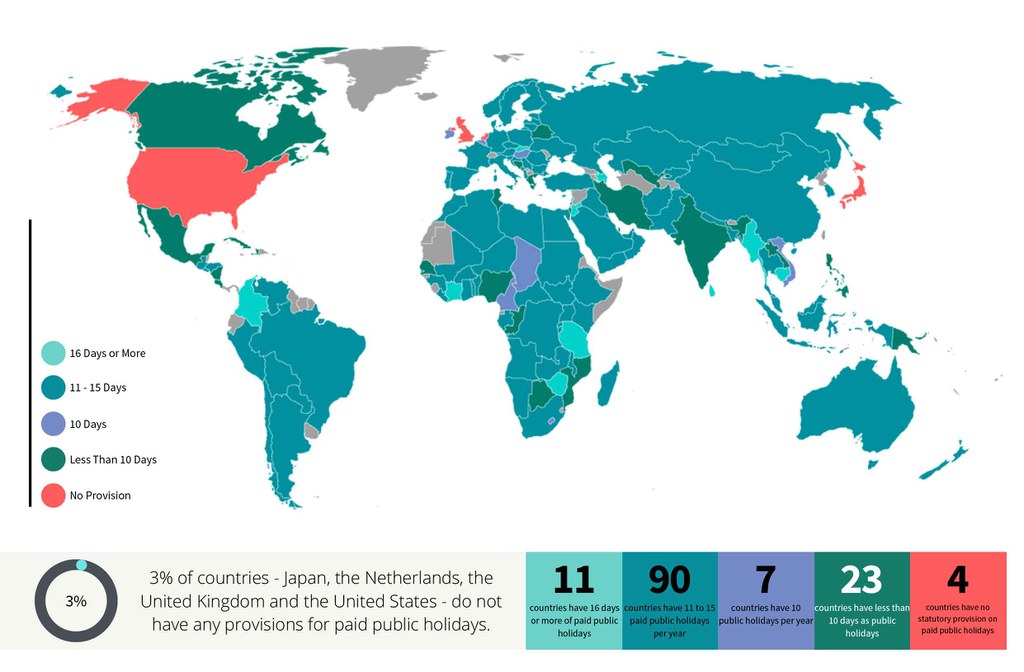
2.5 Annual Leave
Does the law require at least three working weeks of paid annual leaves?
International Regulatory Standard
Article 3 of Holidays with Pay Convention (Revised) 1970 (No. 132) requires that every person to whom this Convention applies shall be entitled to an annual paid holiday of a specified minimum length, where every Member who ratifies this Convention shall specify the length of the holiday, with the annual holiday not being less than three working weeks after one year of service.
Methodology
Whether there is paid annual leave:
1: The labour legislation requires employers to grant workers at least three working weeks of paid annual leave after completing one year of service.
0: The length of paid annual leave is less than three working weeks. A score of 0 is also assigned when the qualifying period for annual leave is more than a year.
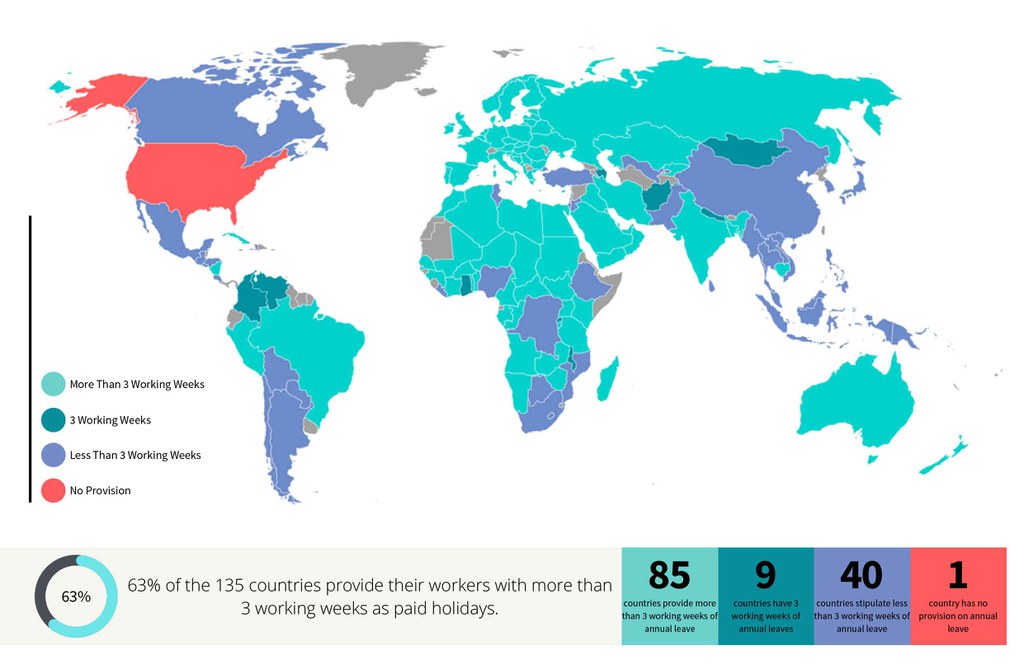
Decent Working Hours - Snapshot
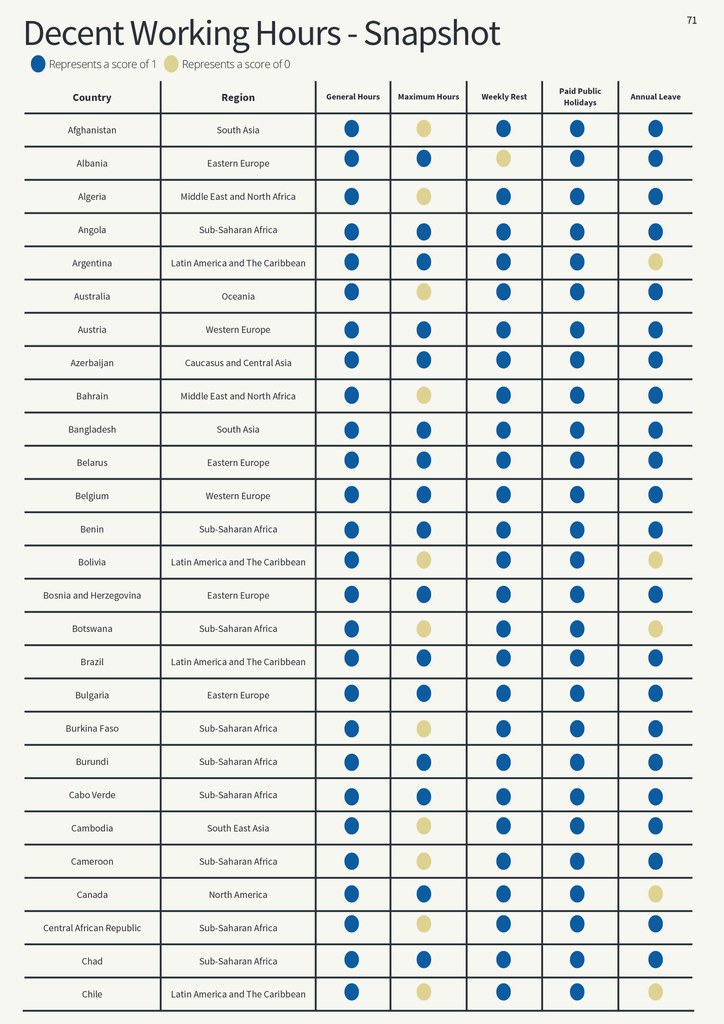
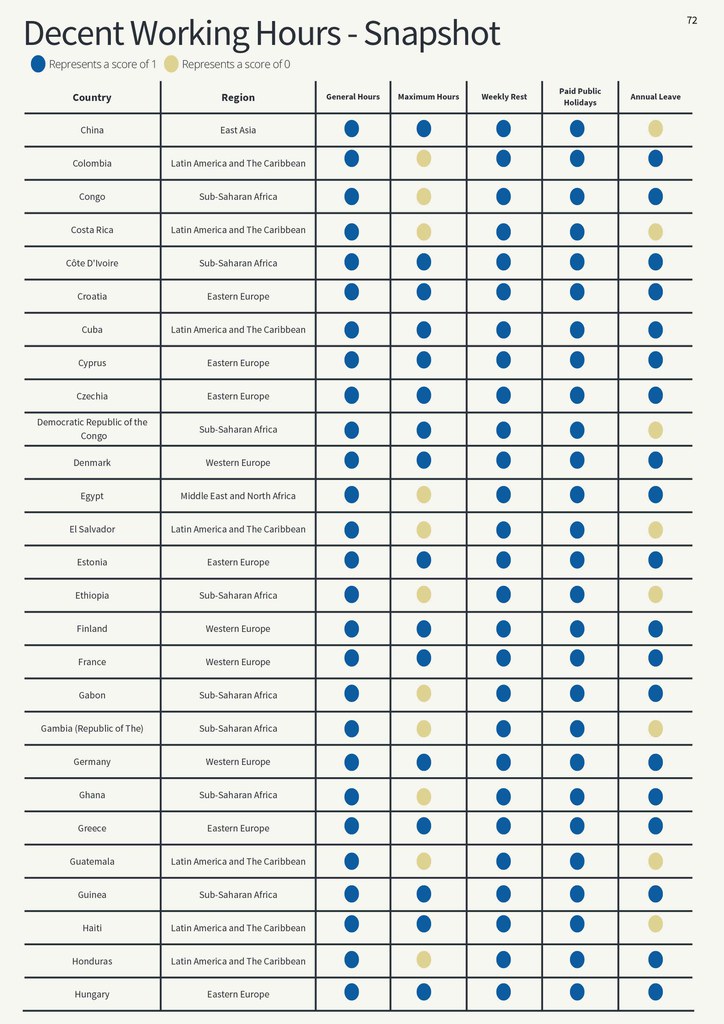
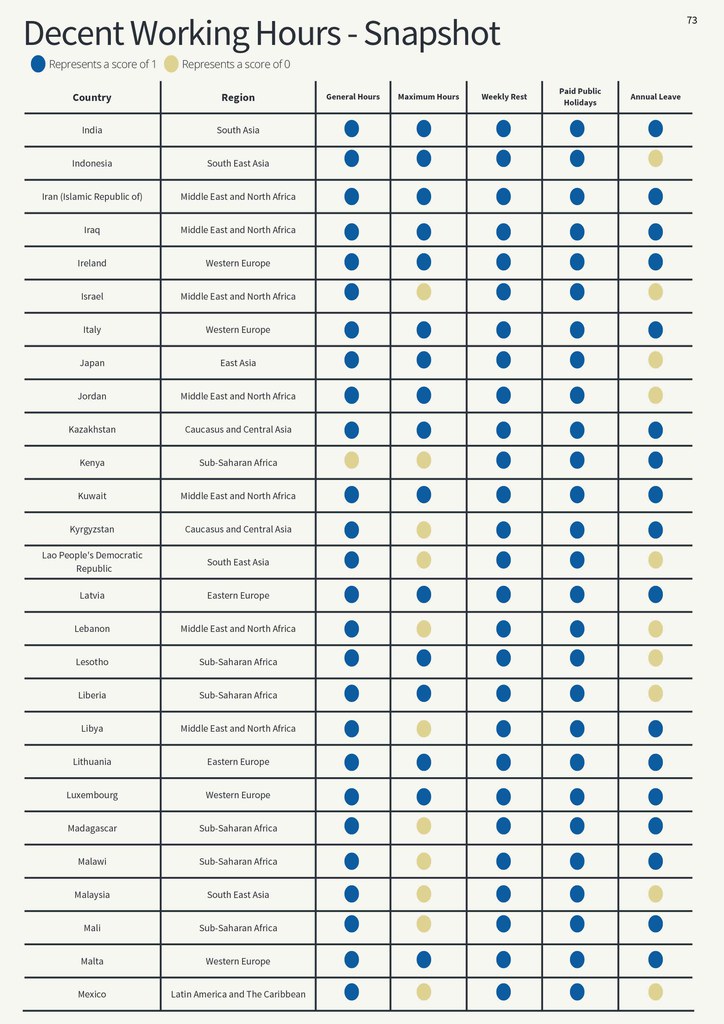
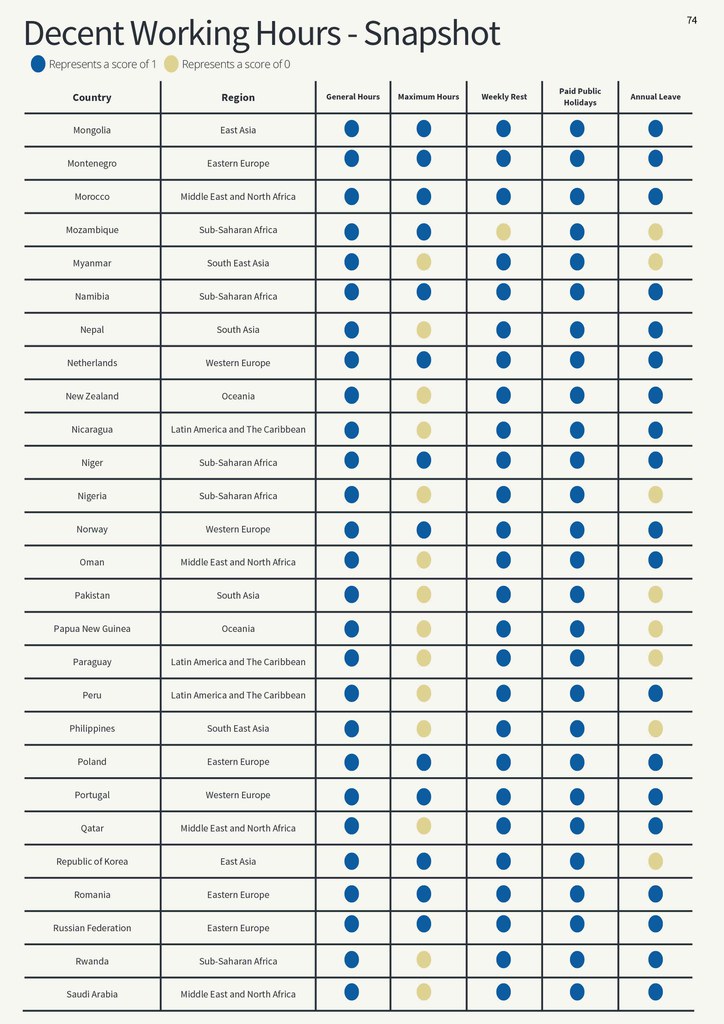
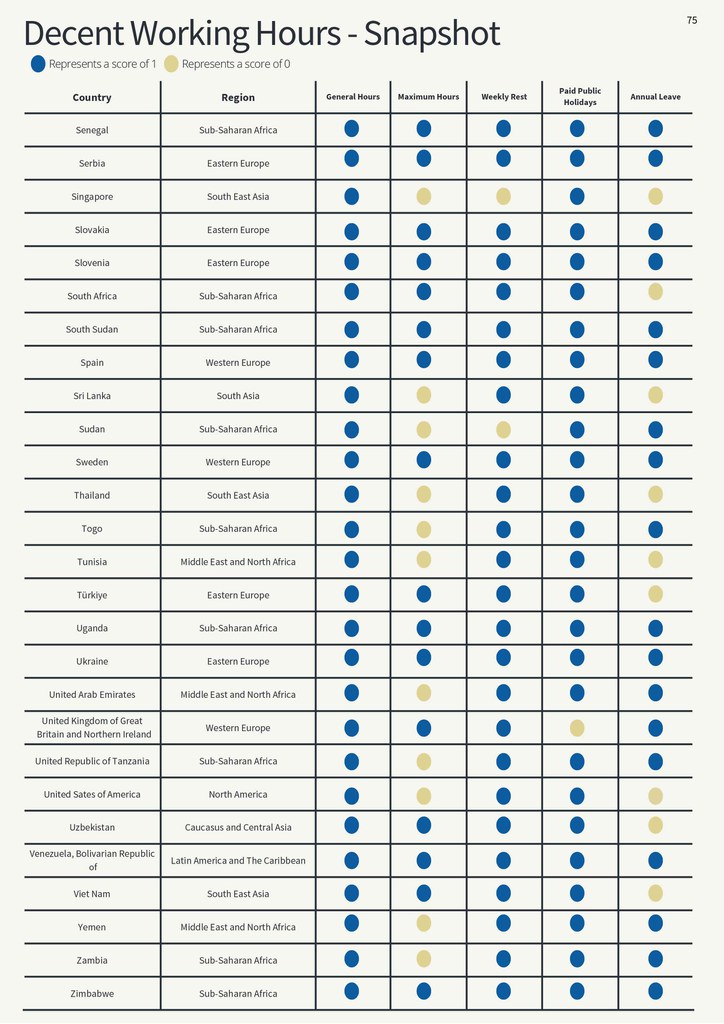
Employment Security
The Employment Security indicator measures whether labour legislation ensures that workers' jobs are characterized by a degree of permanence and reliability. The indicator considers various aspects of employment security and stability like a written employment contract, indefinite vs fixed-term contracts for tasks of a permanent nature, a probation period, a notice period before termination of contract and severance pay.
3.1 Written Employment Contract
Does the law require written employment contract or particulars?
International Regulatory Standard
Under Articles 7 and 8 of the Domestic Workers Convention, 2011 (No. 189), measures are to be taken to ensure that domestic workers are informed of their terms and conditions of employment in an appropriate, verifiable, and easily understandable manner and preferably, where possible, through written contracts (enforceable in the country where work is to be done) under national laws, regulations or collective agreements, and with written particulars. Similar provisions are found in the Maritime Labour Convention 2006.
Moreover, Part II (5) of the Private Employment Agencies Recommendation, 1997 (No. 188) suggest that workers employed by private employment agencies should, where appropriate, have a written contract of employment specifying their terms and conditions of employment. As a minimum requirement, these workers should be informed of their conditions of employment before the effective beginning of their assignment.*
Methodology
Whether employers are required to provide written employment contracts to workers:
1: The labour legislation requires employers to provide written employment contracts or at least written employment particulars to workers on commencement of employment.
0: No requirement on the employer’s part to provide any such written document.
Around 9% of the 135 countries do not require employers to provide written employment contracts or written employment particulars to workers.
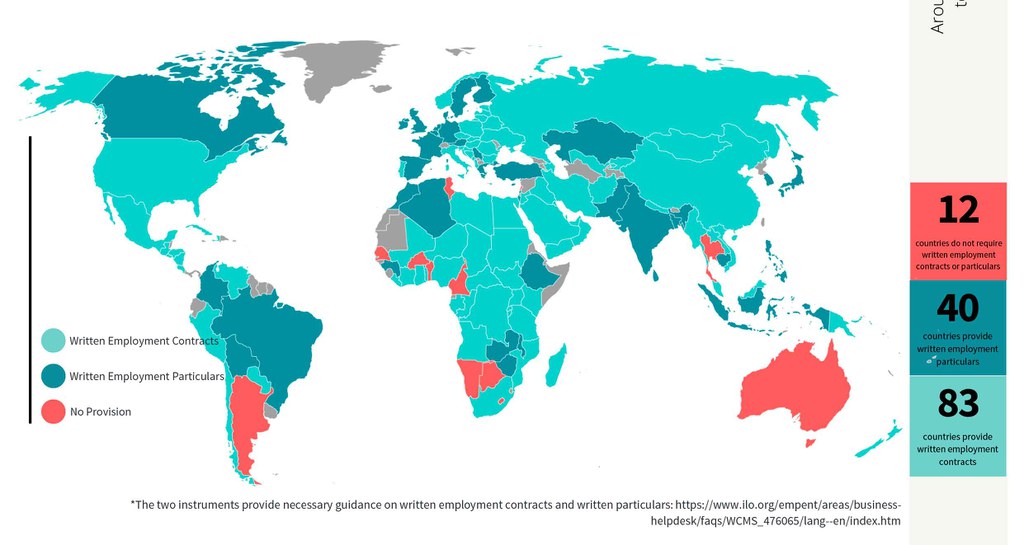
3.2 Fixed Term Contracts
Does the law restrict the hiring of fixed-term contract workers?
International Regulatory Standard
Article 2(3) of the Termination of Employment Convention 1982 (No. 158) states that adequate safeguarding measures should be provided against the use of fixed-term contracts of employment for a specified period of time with the aim of avoiding the protection resulting from this Convention.
Also, Article 3(2) of the Termination of Employment Recommendation, 1982 (No. 166) allows for a fixed or definite term contract, considering the nature of work or circumstances under which the work is carried out or the interests of the worker. The fixed-term contracts are considered indefinite term contracts if they are renewed once or more than once, except in the above cases.
Methodology
Whether labour legislation restricts the hiring of fixed-term contract workers:
1: The maximum length of fixed contracts, including renewals, does not exceed five years.
0: The labour legislation does not specify the maximum length of fixed-term contracts or allow the maximum length of Fixed-Term Contracts (FTCs), including renewals, to exceed five years.
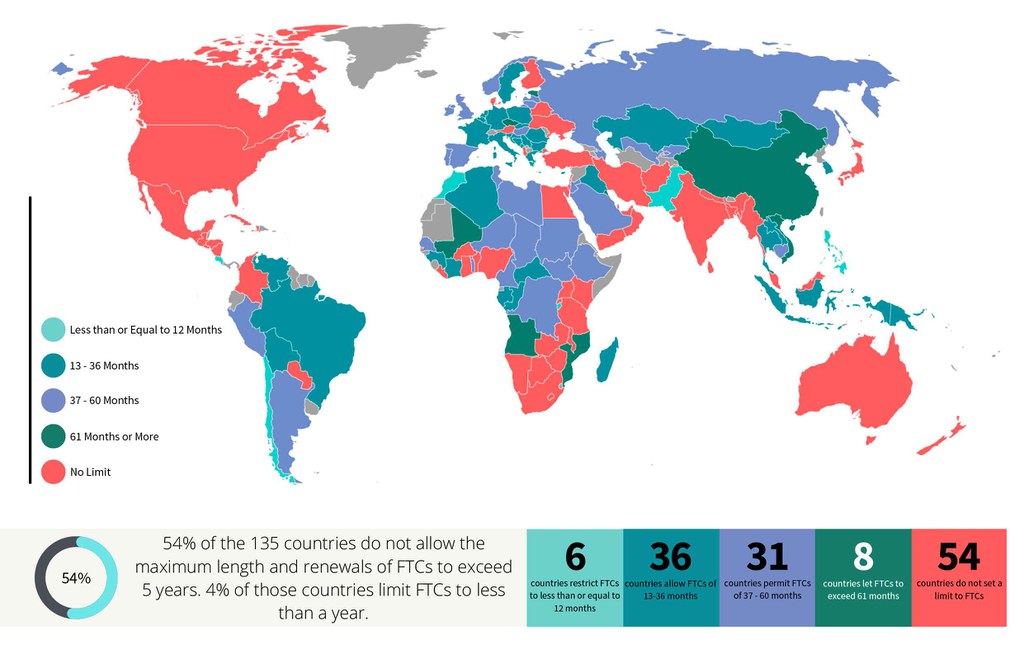
3.3 Probation Period
Does the law limit the length of probation period, including renewals, to three months?
International Regulatory Standard
This component is grounded in Article 2 (b) of the Termination of Employment Convention 1982 (No. 158). The Convention states that a Member may exclude workers serving a period of probation or a qualifying period of employment, determined in advance and of reasonable duration, from all or some of the provisions of this Convention. In view of this, a probationary period of three months was set as a standard.
Methodology
Whether labour legislation limits the length of the probation period to three months:
1: The labour legislation limits the maximum length of the probation period, including renewals, to three months.
0: The labour legislation does not refer to a probation/trial period or allow it to exceed three months.

3.4 Termination Notice Period
Does the law require a 30 day notice period before contract termination?
International Regulatory Standard
Article 11 of ILO Convention 158 states that a worker whose employment is to be terminated shall be entitled to a reasonable period of notice or compensation in lieu thereof unless the worker is guilty of serious misconduct - misconduct of such a nature that it would be unreasonable to require the employer to continue the employment during the notice period.*
Methodology
Whether there is a 30-day notice before contract termination:
1: A score of 1 is assigned if either of these scenarios is present.
a) Both the employer and employee can terminate an indefinite term contract after serving a 30-day written notice or paying in lieu of notice, except in cases of gross misconduct; or
b) where a termination notice required from employees is 30 days, but it is still less than the notice period required of employers; or
c) where the notice period required
0: Both the employer and employee are required to serve a contract termination notice of less than or more than 30 days.
13% of the 135 countries have different termination notice periods for the employer and employee. Argentina and Cuba are the only Latin American countries requiring different notice periods
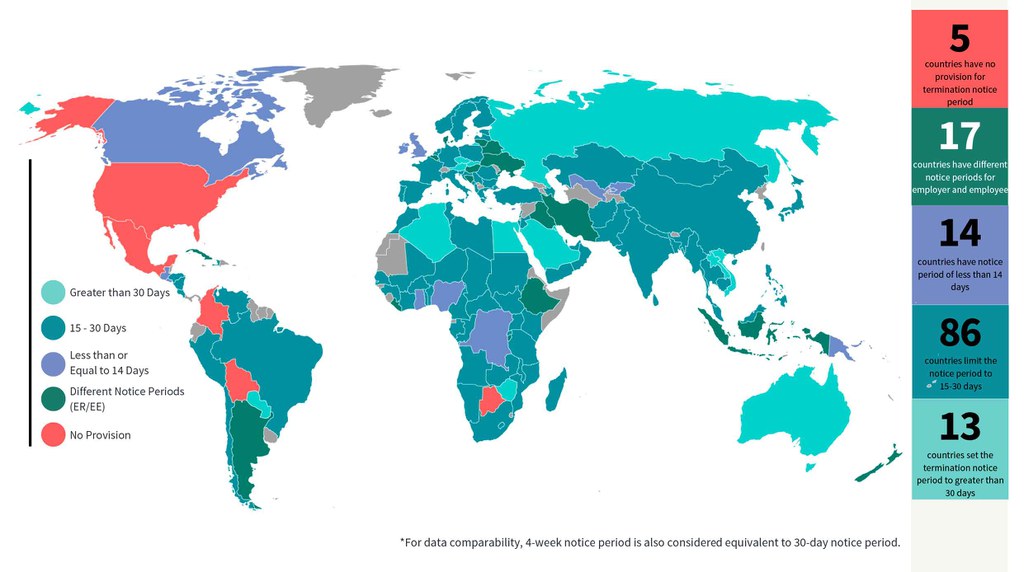
3.5 Severance Pay
Does the law require severance pay at the rate of at least two weeks of wages for every year of service?
International Regulatory Standard
Article 12 of the Termination of Employment Convention 1982 (No. 158) states that a worker whose employment has been terminated shall be entitled, in accordance with national law and practice, to a severance allowance or other separation benefits, the amount of which shall be based, among other things, on length of service and the level of wages. It is to be paid directly by the employer or by a fund constituted by employers’ contributions, unemployment insurance benefits or assistance or other forms of social security, or a combination of such allowance and benefits. Workers who do not fulfil the qualifying conditions for unemployment insurance or assistance or those workers who are terminated for serious misconduct need not be paid any severance allowance or separation benefits.
Methodology
Whether there is severance pay on contract termination:
1: Labour legislation requires employers to provide severance pay (gratuity or end of service allowance) at the rate of two weeks’ wages for each year of service* on contract termination in the event of individual dismissal or economic dismissals (redundancy) or on expiry of a fixed-term contract, except in cases of gross misconduct.
0: Severance pay is not required under the law or is provided at a rate lower than two weeks’ wages for each year of service or if the rate is not specified under the law.
24% of the 135 countries do not have any legal provision regarding severance pay.
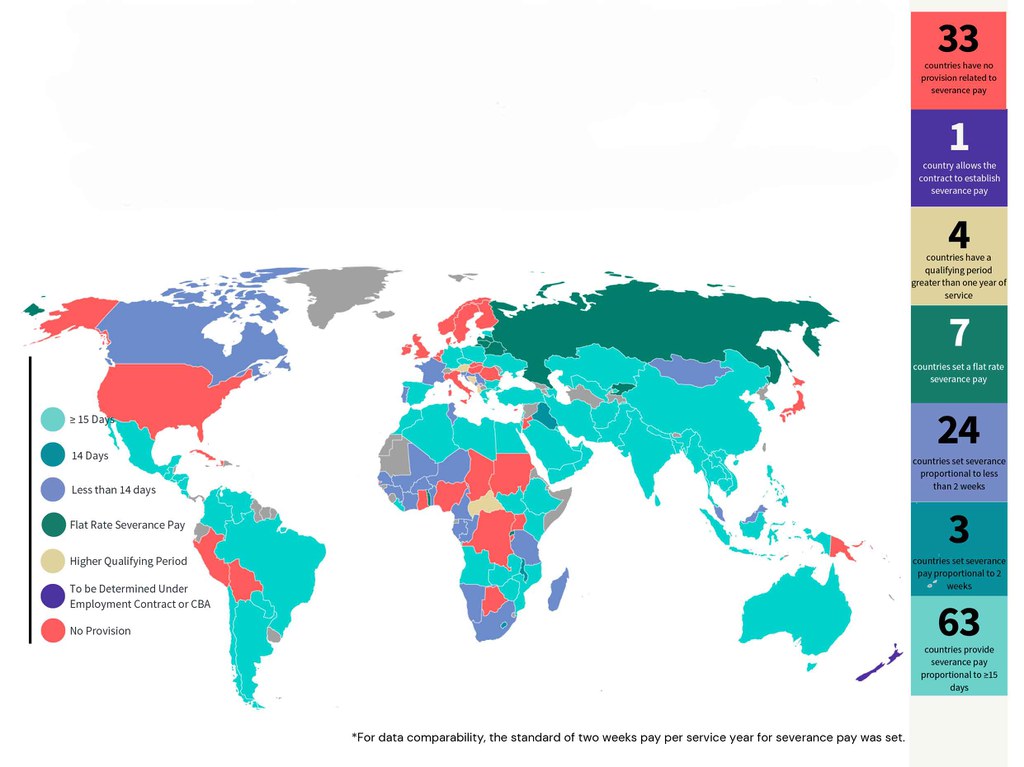
Employment Security - Snapshot

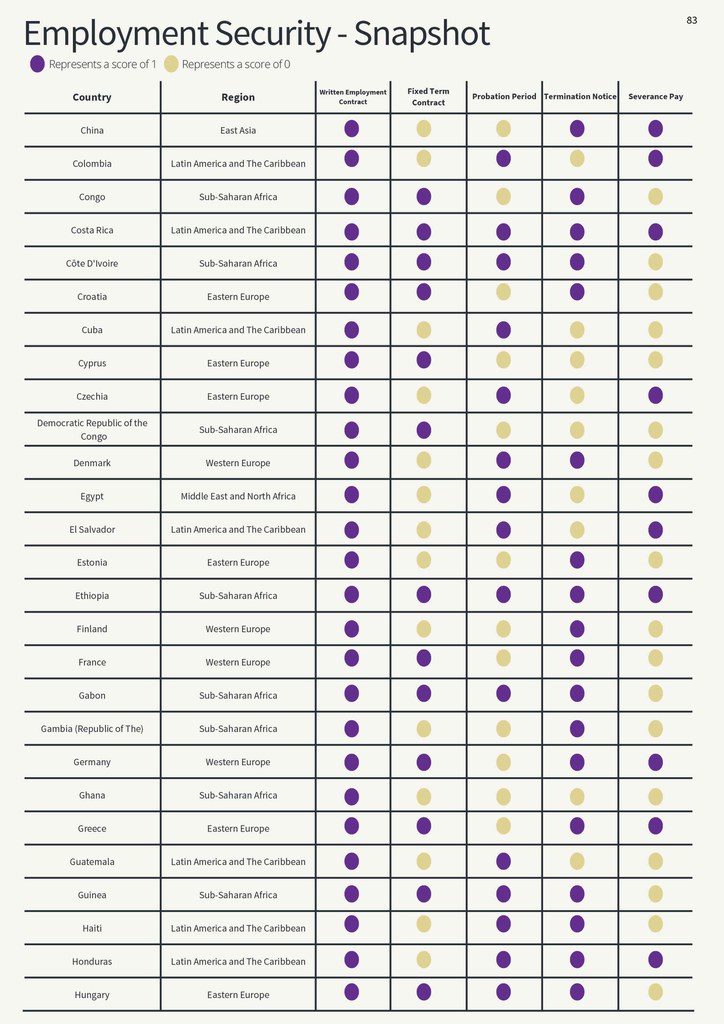
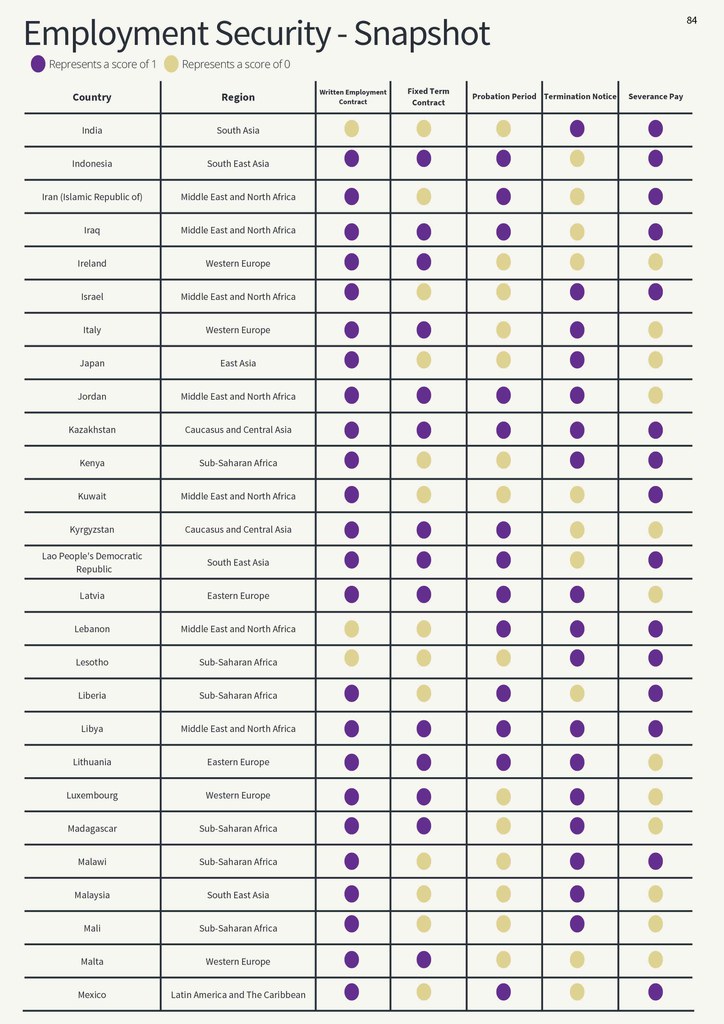
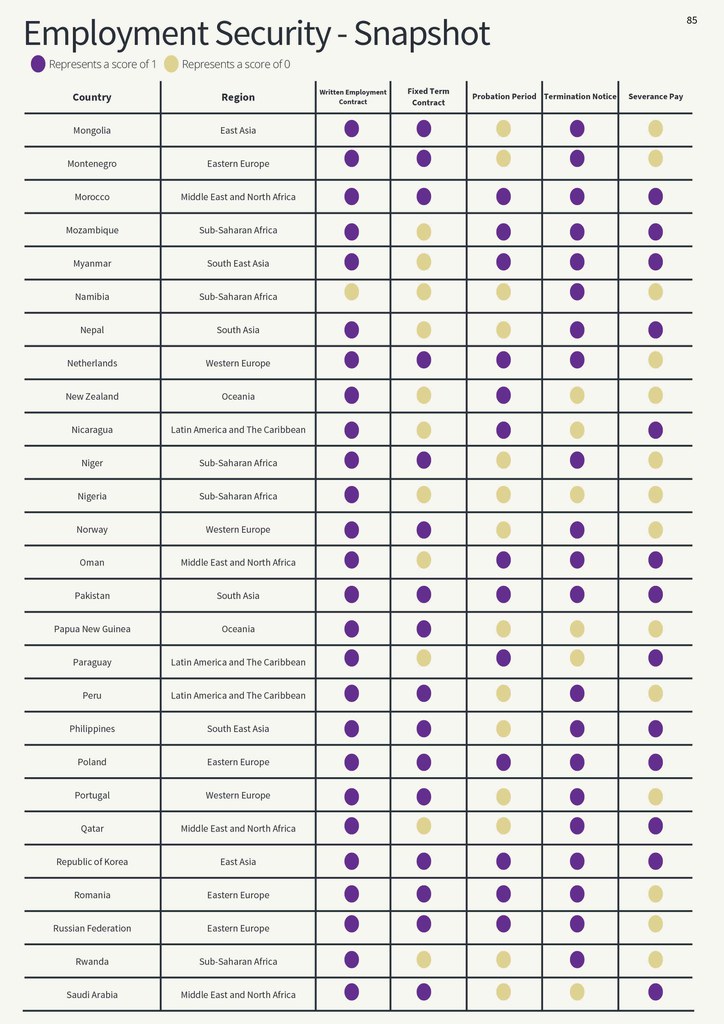
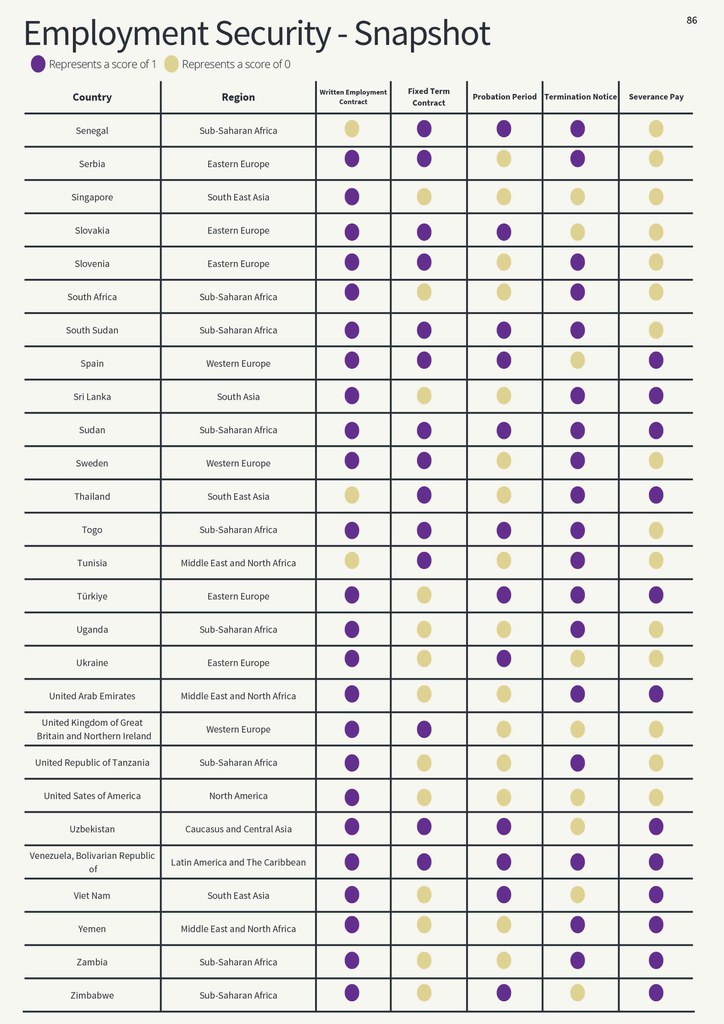
Family Responsibilities
Family responsibilities are responsibilities in relation to dependent children and other immediate family members who need care (sick, elder, infirm). The Family Responsibilities indicator measures whether labour legislation ensures that workers get paternity leave, parental leave and flexible work options while tending to their family responsibilities.
4.1 Parental Leave
Does the law require parental leave for parents?
International Regulatory Standard
Paragraph 22 of the Workers with Family Responsibilities Recommendation, 1981 (No. 165) and Paragraph 10 of the Maternity Protection Recommendation, 2000 (No. 191) insist that either parent should have the possibility, within a period immediately following maternity leave, of obtaining leave of absence (parental leave), without relinquishing employment and with rights resulting from employment being safeguarded. The parental leave period, its length, as well as payment of parental benefits and the use and distribution of parental leave between employed parents, should be determined by national laws or regulations or in any manner consistent with the national practice.
Methodology
Whether parental leave is available to parents:
1: Workers have the right to paid or unpaid parental leave of at least four months on exhaustion of paternity and maternity leave. 0: Labour legislation does not provide for the right to paid or unpaid parental leave of four months on exhaustion of paternity and maternity leave.*
56% of the 135 countries have no legal provision for parental leave. Chile, China and Singapore are the only countries to provide less than 4 months of parental leave.
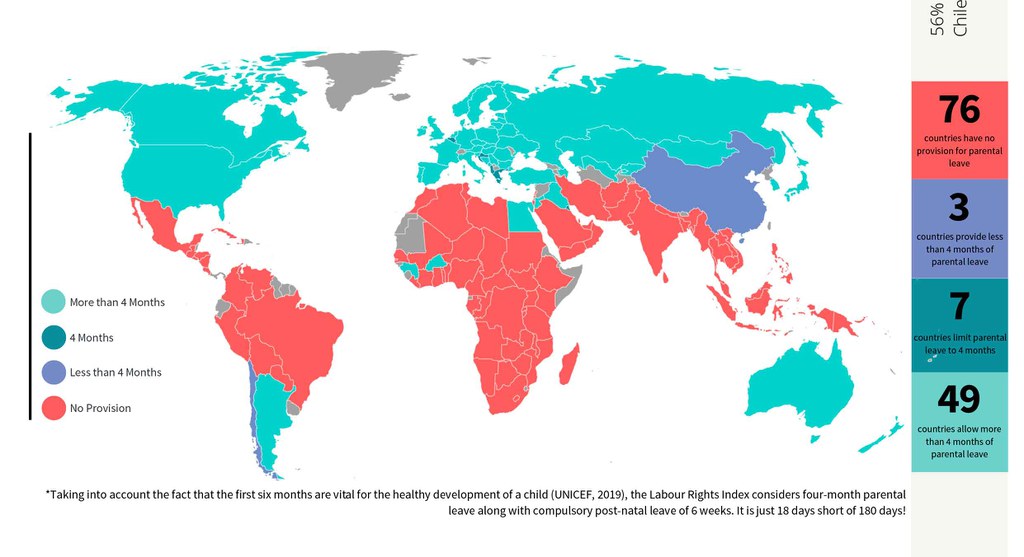
4.2 Paternity Leave
Does the law require at least one week of paid paternity leave for fathers?
International Regulatory Standard
In line with para 42 of the 2009 ILC Resolution Concerning Gender Equality at the Heart of Decent Work, Governments must develop, together with social partners, adequate policies for a better balance of work and family responsibilities for an equal sharing of these responsibilities. Other than parental leave, such policies should include paternity leave, with incentives for men to use them.
Methodology
Whether fathers have the right to take paid paternity leave:
1: Labour legislation requires employers to grant paid paternity leave of at least one week on the birth of a child. Paternity leave might be an employer liability or paid by the social security system or general tax financing.
0: There is no provision for paid paternity leave of at least one week.
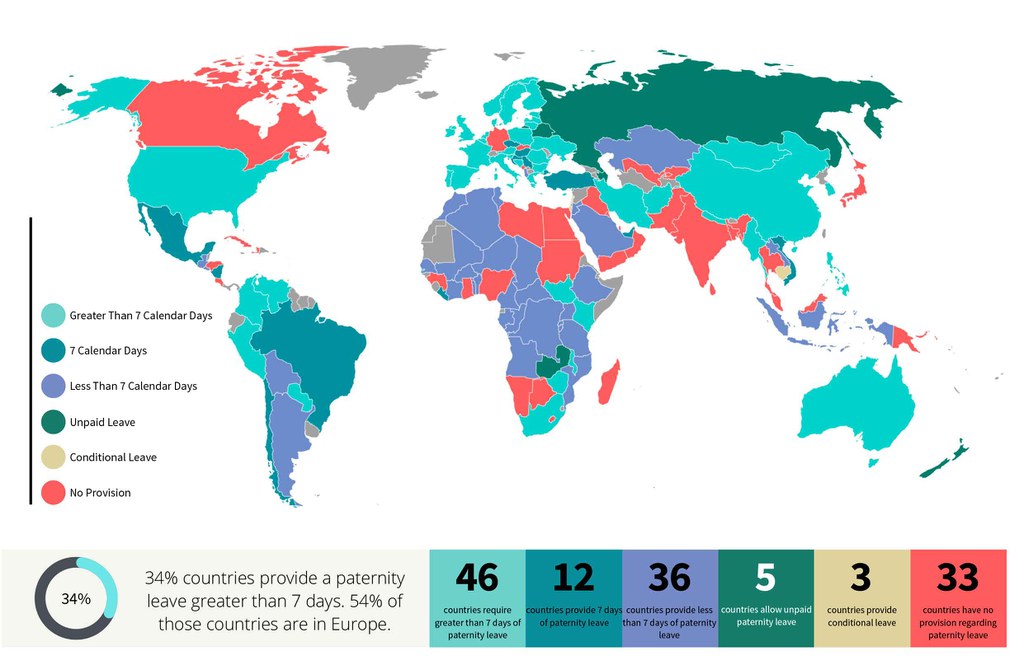
4.3 Flexible Work Arrangements
Does the law require flexible working arrangements for workers with family responsibilities?
International Regulatory Standard
Paragraph 18 of the Workers with Family Responsibilities Recommendation, 1981 (No. 165) suggests that particular attention should be given to general measures for improving working conditions and the quality of working life, including measures aiming at progressive reduction of daily hours of work and of overtime, and more flexible arrangements as regards working schedules, rest periods and holidays, account being taken of the stage of development and the particular needs of the country and of different sectors of activity.
Article 9(2) of the Part-Time Work Convention, 1994 (No. 175) states that measures should include the review of laws and regulations that may prevent or discourage recourse to or acceptance of part-time work. Special attention, in employment policies, to the needs and preferences of specific groups such as the unemployed, workers with family responsibilities, older workers, workers with disabilities and workers undergoing education or training needs to be there.
Methodology
Whether flexible working arrangements are available to workers with family responsibilities:
1: The labour legislation allows flexible work arrangements for workers with family responsibilities.
0: The labour legislation does not provide access to part-time work or flexible work for workers with family responsibilities.
67% of the 135 countries do not provide access to part-time work or flexible work for workers with family responsibilities.
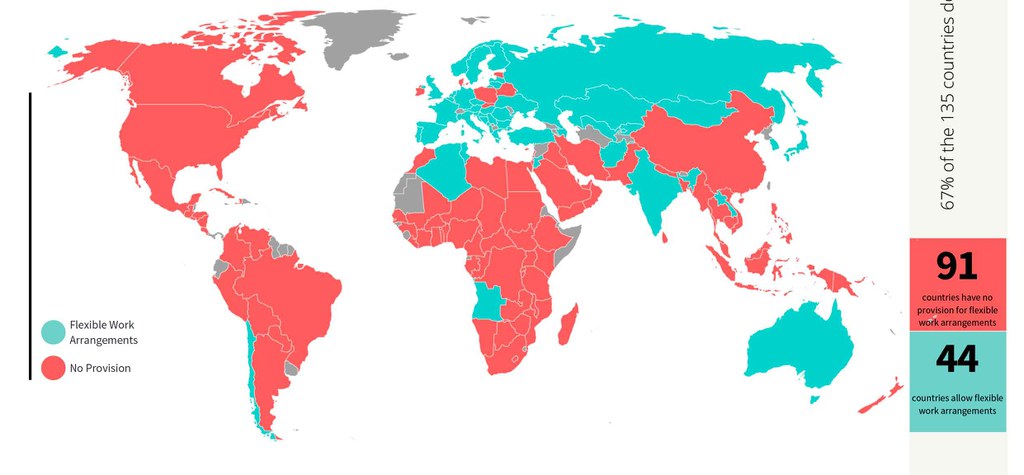
4.4 Paid Nursing Breaks
Does the law require paid nursing breaks?
International Regulatory Standard
Article 10 of the Maternity Protection Convention, 2000 (No. 183) requires that a woman worker must be provided with the right to one or more daily breaks or a daily reduction of hours of work to breastfeed her child. The period during which nursing breaks or the reduction of daily hours of work are allowed, their number, the duration of nursing breaks and the procedures for reducing daily hours of work shall be determined by national law and practice.
These breaks or the reduction of daily work hours shall be counted as working time and remunerated accordingly.
Methodology
Whether there are paid nursing breaks:
1: The labour legislation requires the provision of paid nursing breaks until the infant is six months old.
These nursing breaks can either be during the working day or can also take the form of reduced working hours.
0: Labour legislation does not require employers to grant fully paid nursing breaks to workers until the infant is six months old.
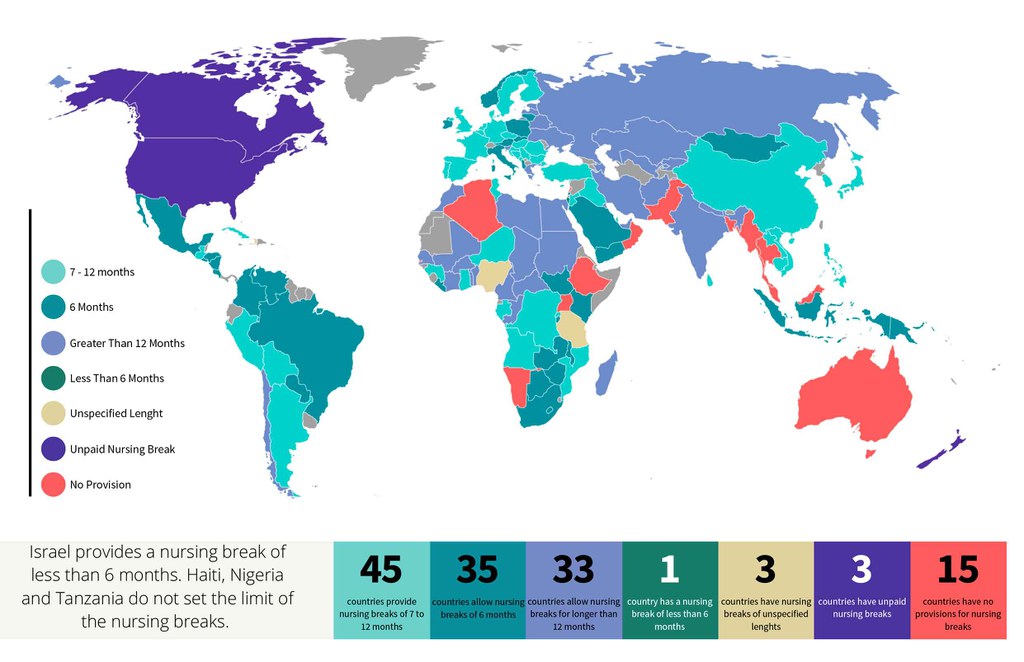
Family Responsibilities - Snapshot
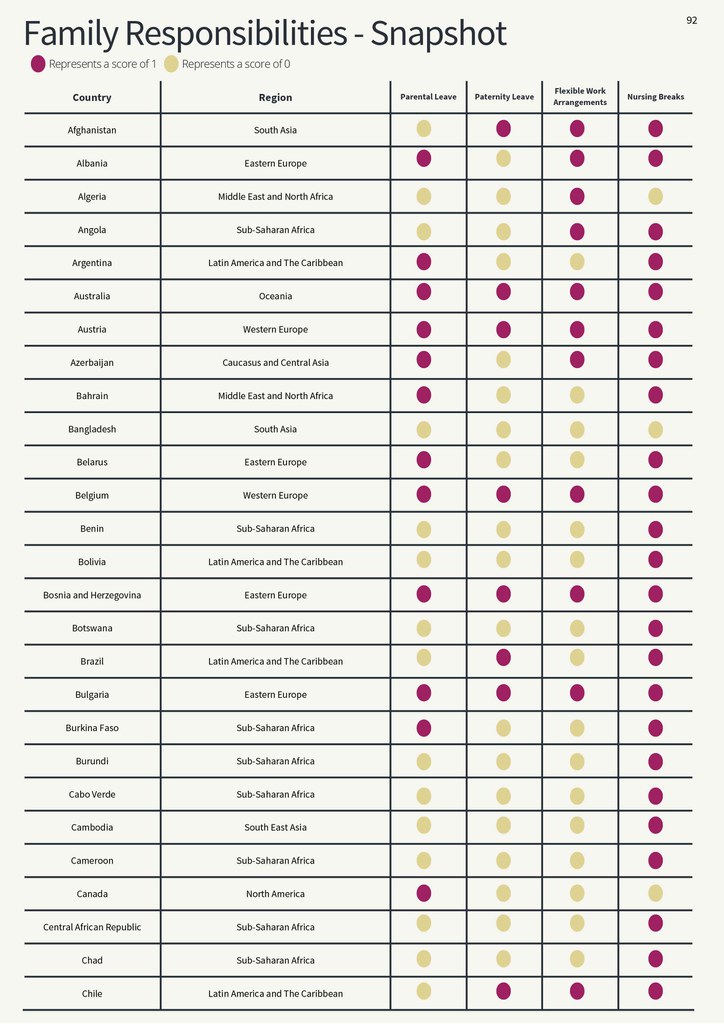
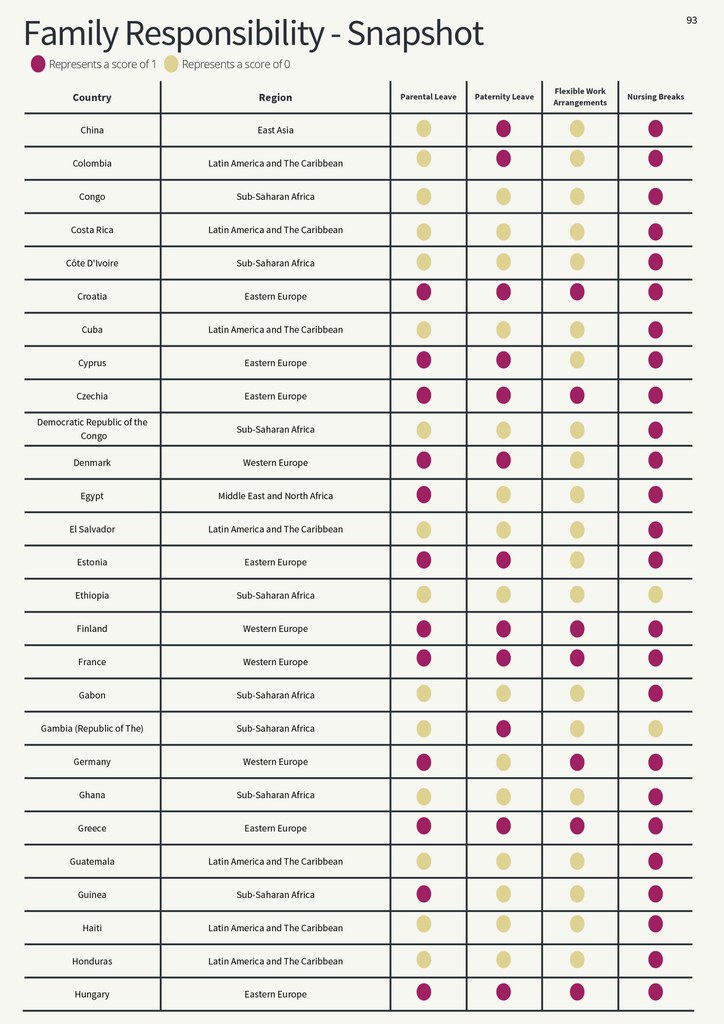
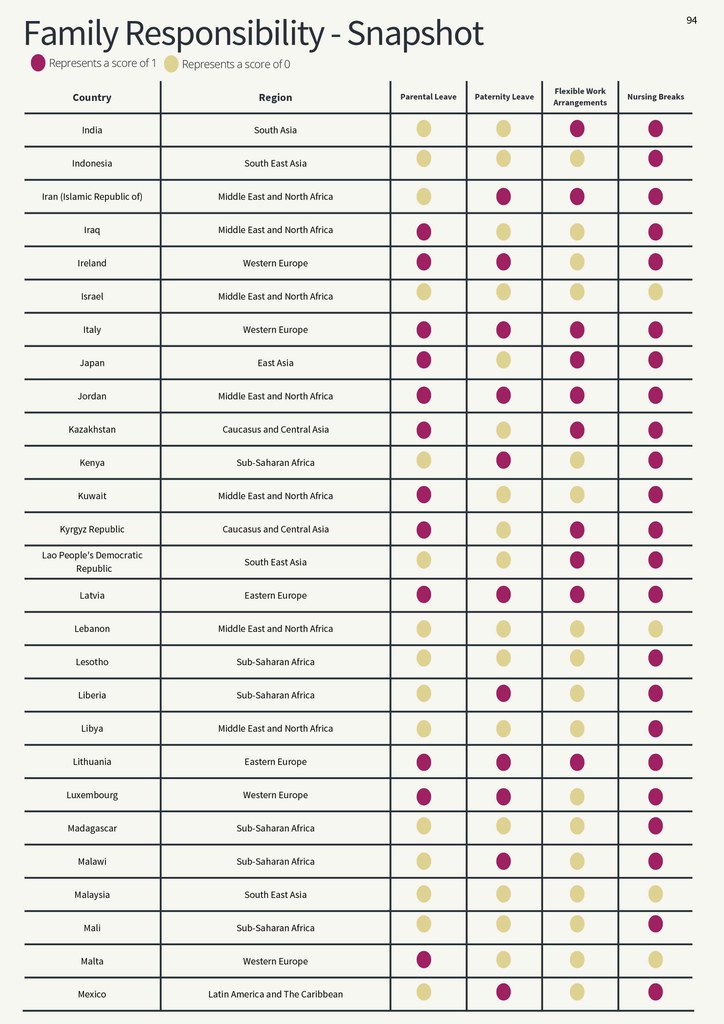
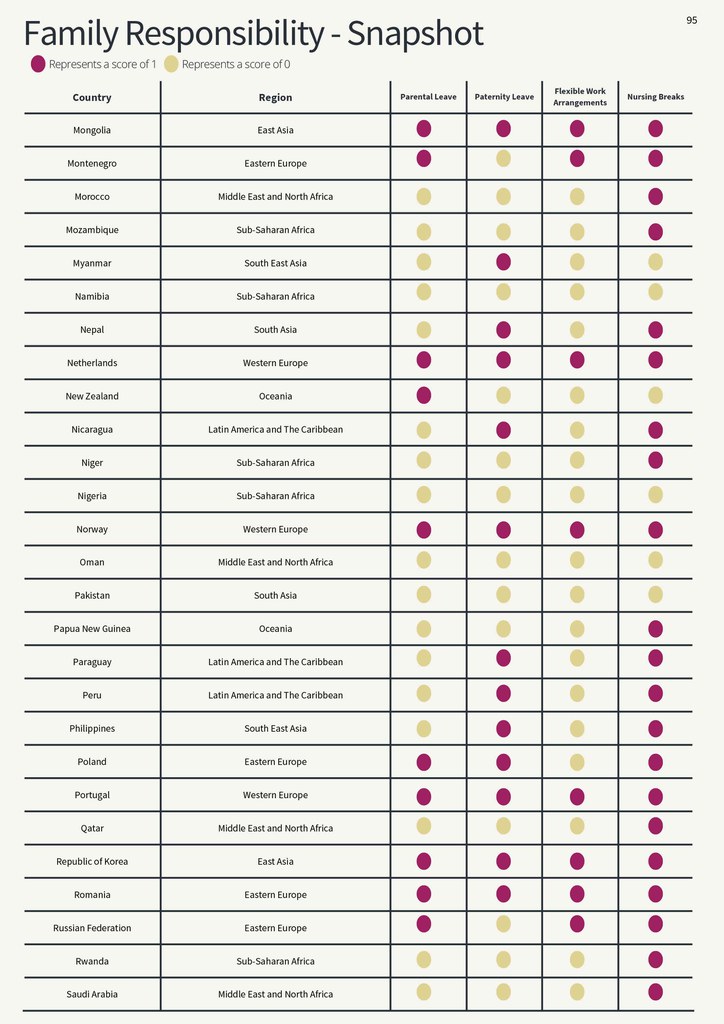
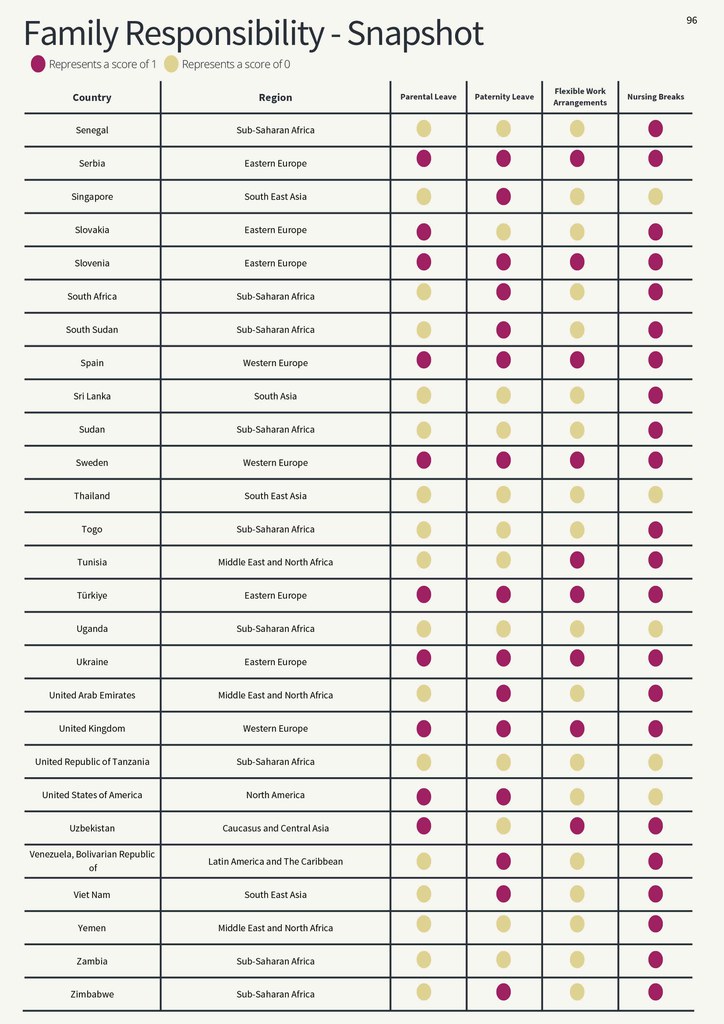
Maternity At Work
Maternity protection allows women to successfully combine their productive and reproductive roles without compromising one at the cost of another. Similarly, it protects women from discrimination in the labour market due to their reproductive roles. The Maternity at Work indicator measures whether labour legislation ensures that workers get paid maternity leave and are protected from dismissal during and on account of pregnancy.
5.1 Pregnancy Inquiry During Recruitment
Does the law prohibit inquiring about pregnancy during recruitment?
International Regulatory Standard
Article 9 of the Maternity Protection Convention, 2000 (No. 183) focuses on adopting appropriate measures to ensure that maternity does not constitute a source of discrimination in employment, including access to employment. Measures need to include a prohibition from requiring a test for pregnancy or a certificate of such a test when a woman is applying for employment, except where required by national laws or regulations in respect of work that is prohibited or restricted for pregnant or nursing women under national laws or regulations, or where there is a recognised or significant risk to the health of the woman and child.
Methodology
Whether law prohibits inquiring about pregnancy during recruitment:
1: Labour legislation prohibits employers from inquiring about pregnancy (through pregnancy testing or other means) during recruitment.
0: There is no prohibition in the law on inquiring about pregnancy/family planning during recruitment or making it a recruitment condition.
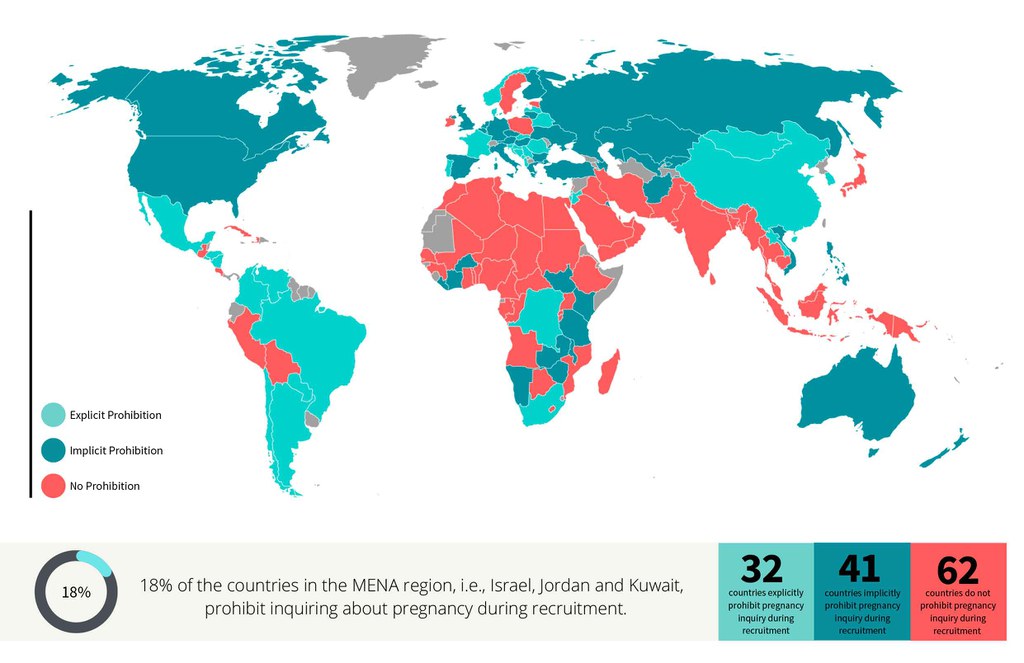
5.2 Maternity Leave
Does the law require paid maternity leave of at least 14 weeks?
International Regulatory Standard
Article 4 of the Maternity Protection Convention, 2000 (No. 183) stipulates that a woman worker shall be entitled to a maternity leave of at least 14 weeks. With due regard to the protection of the health of the mother and that of the child, maternity leave shall include a period of six weeks of compulsory leave after childbirth unless otherwise agreed at the national level by the government and the representative organisations of employers and workers.
Methodology
Whether maternity leave is available for 14 weeks:
1: Pregnant workers have the right to maternity leave of at least 14 weeks.
0: The length of maternity leave is less than 14 weeks.
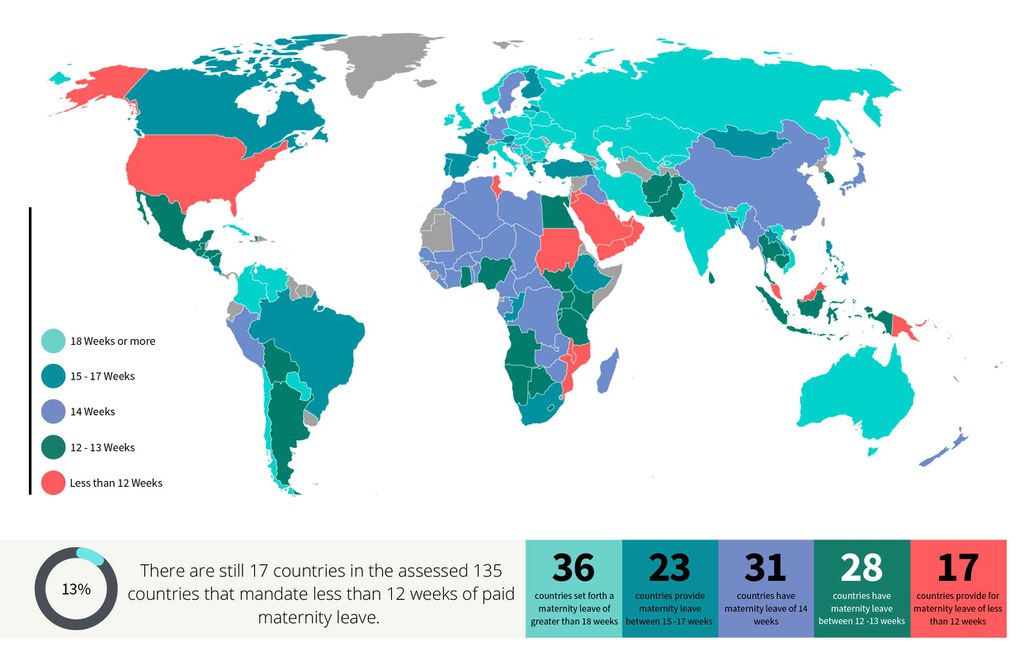
5.3 Maternity Benefits
Does the law require cash maternity benefits to be at least two-third of a worker's former wage?
International Regulatory Standard
Article 6 of the Maternity Protection Convention, 2000 (No. 183) shares that cash benefits shall be provided, in accordance with national laws and regulations, or in any other manner consistent with the national practice, to women who are absent from work on leave, and at a level which ensures that the woman can maintain herself and her child in proper conditions of health and with a suitable standard of living. The amount of such benefits shall not be less than two-thirds of the woman’s previous earnings or of such of those earnings as are taken into account for the purpose of computing benefits.
Methodology
Whether maternity leave benefit is at least two-third of the worker’s former wage:
1: Maternity leave benefit is two-third or higher than the pregnant worker’s former wage. In cases where the maternity leave is over and above 14 weeks, the score will remain 1 if the payment for maternity leave through social insurance or universal benefits is at least two-thirds of the former wage for at least the first 14 weeks. In cases where workers are paid flat rate maternity benefits, these must be at least two-thirds of the applicable minimum wage.*
0: Maternity leave benefit is less than the above threshold.
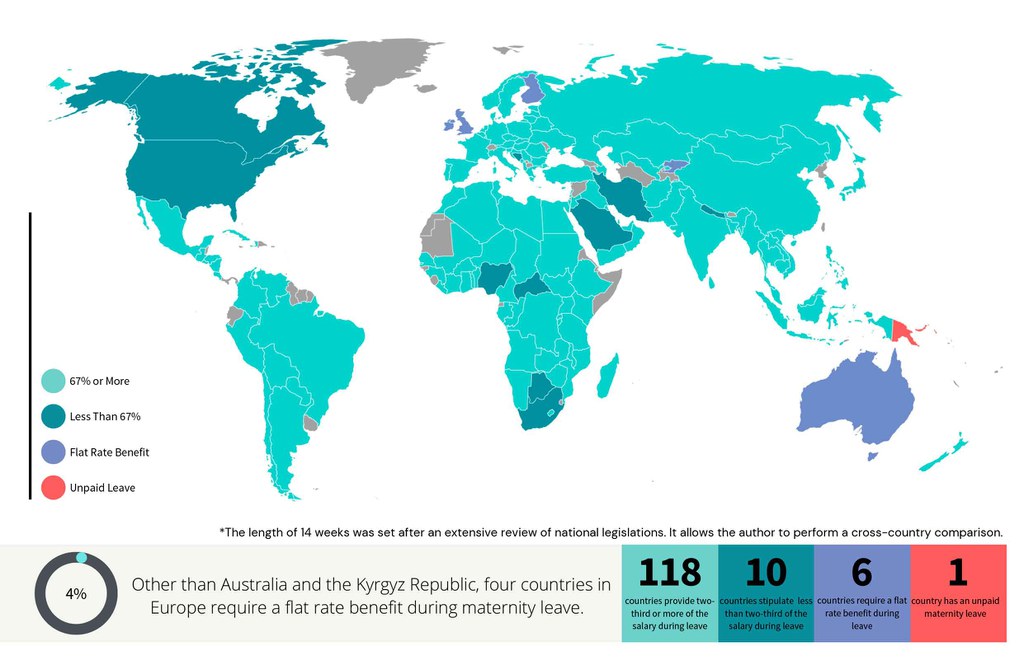
5.4 Source of Maternity Benefits
Does the law require maternity benefits be paid through contributory social insurance or universal benefits system?
International Regulatory Standard
Article 6(8) of the Maternity Protection Convention, 2000 (No. 183) states that in order to protect the situation of women in the labour market, benefits in respect of the leave shall be provided through compulsory social insurance or public funds or in a manner determined by national law and practice. An employer shall not be individually liable for the direct cost of any such monetary benefit to a woman employed by them without that employer’s specific agreement except where such is provided for in national law prior to the introduction of this Convention or it is subsequently agreed at the national level by the government and the representative organisations of employers and workers.
Methodology
Whether maternity benefit is employer liability:
1: Maternity benefit is paid through a contributory social insurance system or through a non-contributory universal benefits system financed through general taxation.
0: Maternity benefit is only employer liability, and employers are required to pay workers their wages during maternity leave.
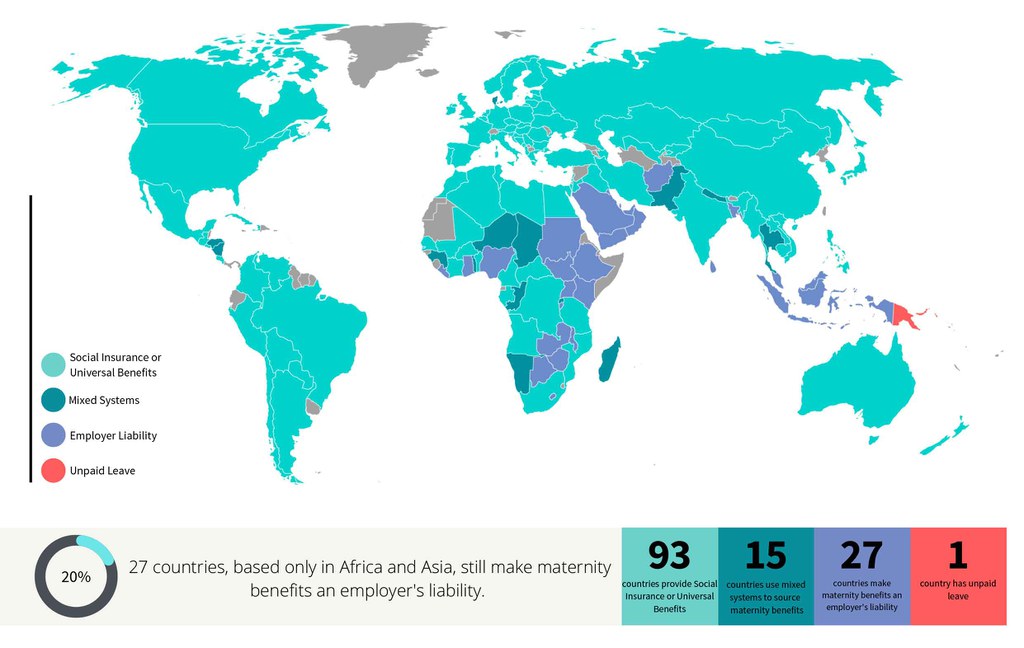
5.5 Dismissals During Pregnancy
Does the law protect workers from dismissals during or on account of pregnancy?
International Regulatory Standard
Article 8 of the Maternity Protection Convention, 2000 (No. 183) stipulates that it is unlawful for an employer to terminate the employment of a woman during her pregnancy or absence on leave or during a period following her return to work, except on grounds unrelated to the pregnancy or birth of the child and its consequences or nursing.
Moreover, a woman is guaranteed the right to return to the same position or an equivalent position paid at the same rate at the end of her maternity leave.
Article 11 (2)(a) of the UN Convention on the Elimination of All Forms of Discrimination against Women (CEDAW) states that to prevent discrimination against women on the grounds of marriage or maternity and to ensure their effective right to work, appropriate measures should be taken, including the prohibition on, subject to the imposition of sanctions, dismissal on the grounds of pregnancy or of maternity leave and discrimination in dismissals based on marital status.
Methodology
Whether law protects workers from dismissal during pregnancy:
1: The legislation prohibits employers from terminating workers during or on account of pregnancy (e.g., medically certified sickness related to pregnancy) except in cases of gross misconduct.
0: The legislation does not protect workers from dismissal during or on account of pregnancy.
87% of the countries prohibit dismissal during or on account of pregnancy.
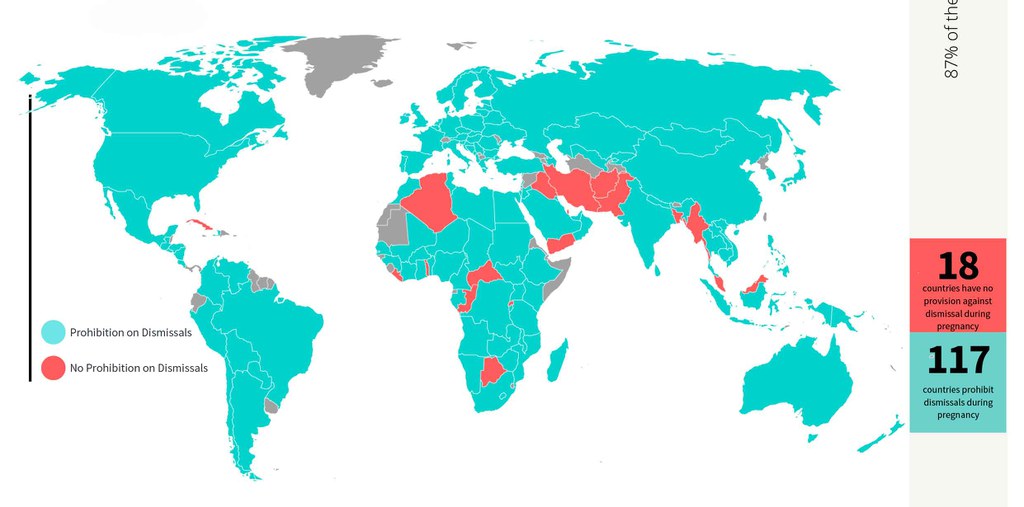
Maternity at Work - Snapshot
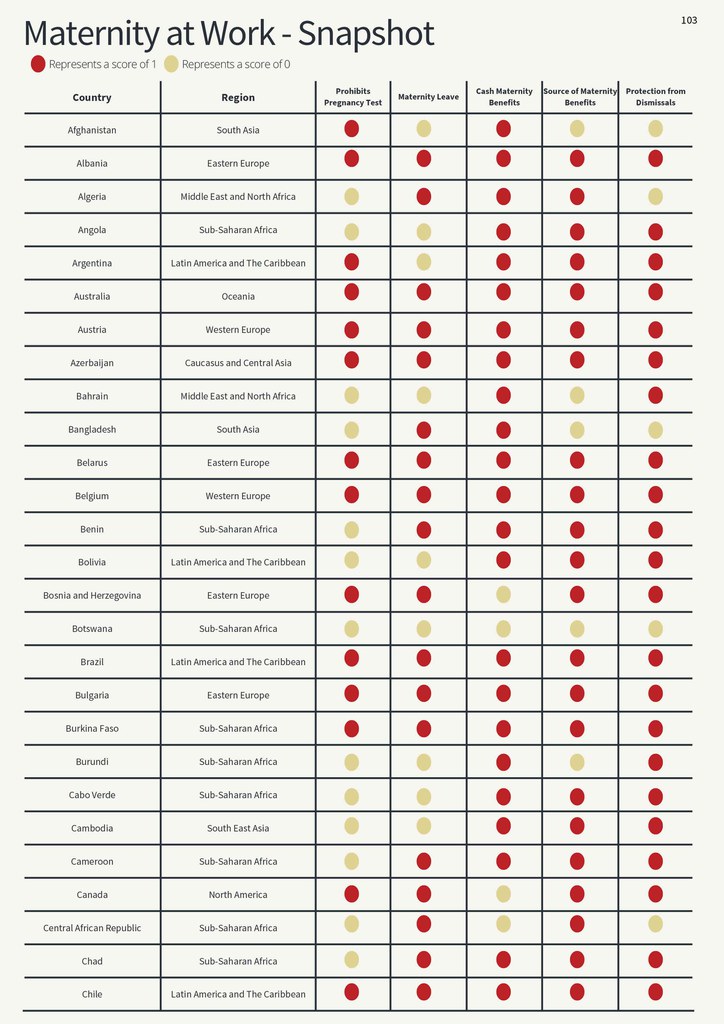
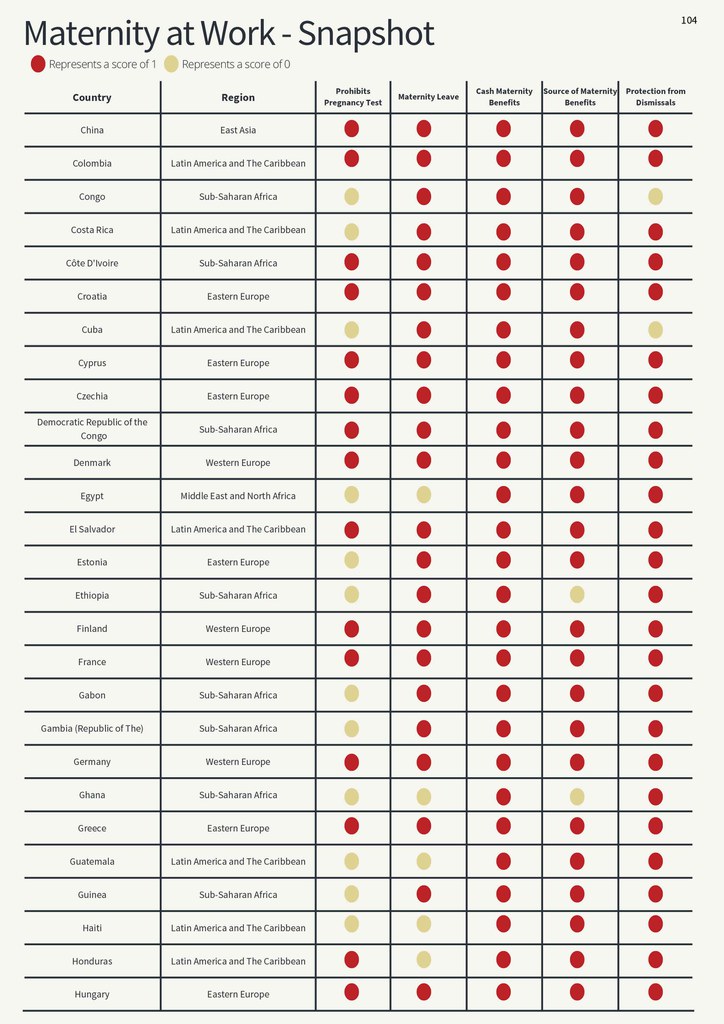
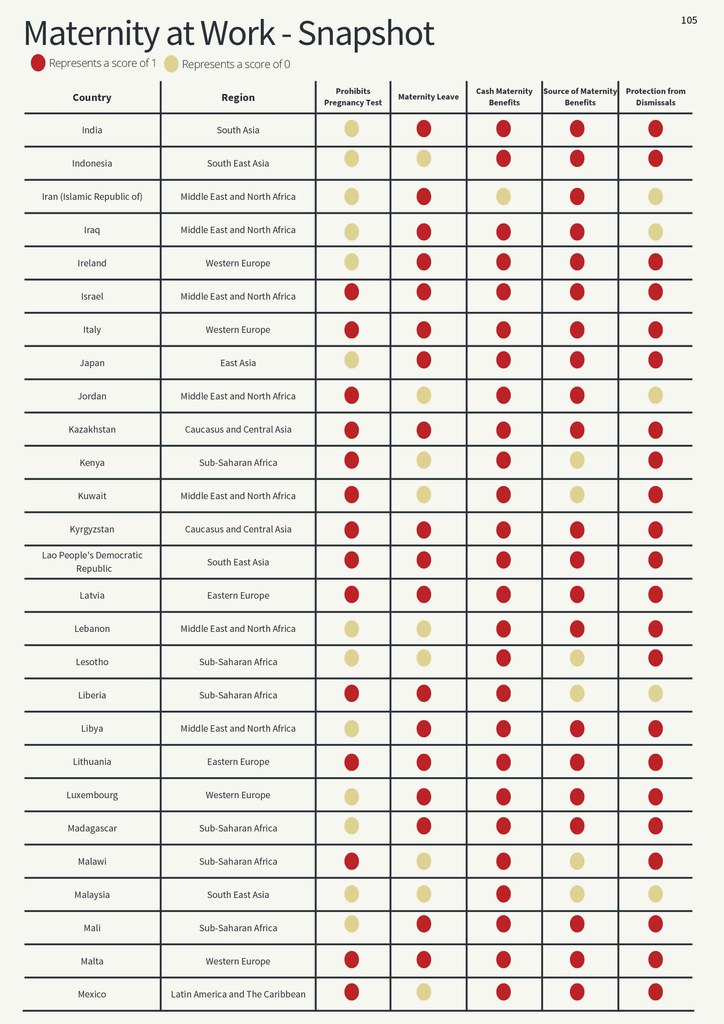
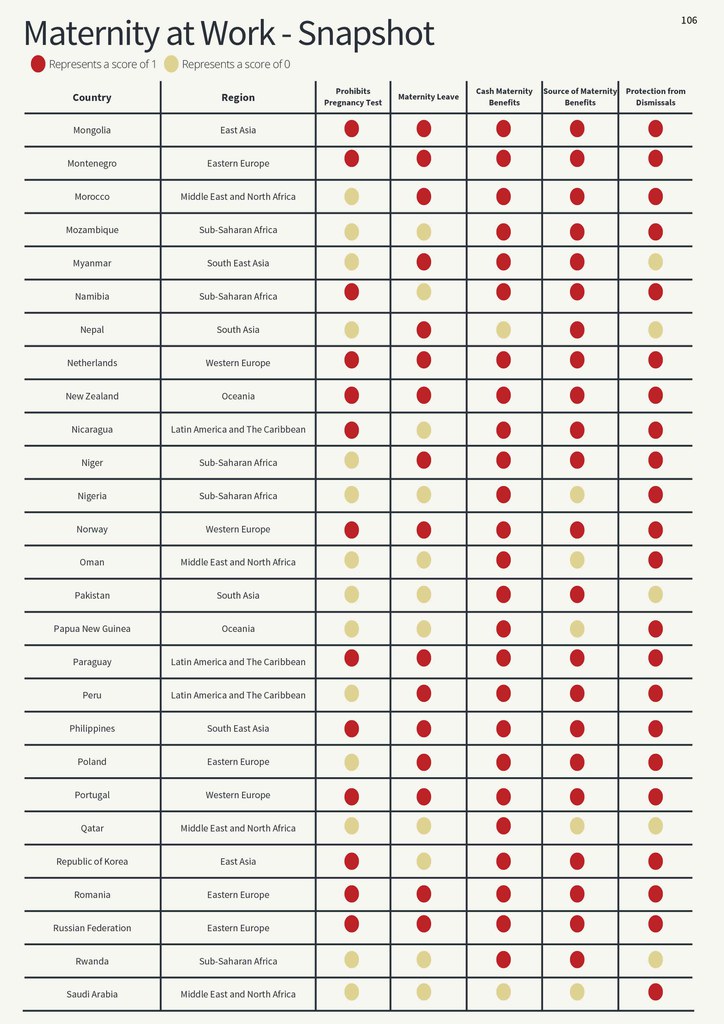

Safe Work
Decent work, in essence, is safe work. The Safe Work indicator measures whether labour legislation ensures that workers are trained about health and safety issues before the commencement of work and whether the employer provides free personal protective equipment to workers.
It also measures countries' compliance on restrictions on arduous work for pregnant workers and whether countries provide some kind of employment injury benefits.
6.1 Free Personal Protective Equipment
Does the law require employers to provide free personal protective equipment to workers?
International Regulatory Standard
Article 16 of the Occupational Safety and Health Convention, 1981 (No. 155) states that employers shall be required to ensure that, so far as is reasonably practicable, the workplaces, machinery, equipment and processes under their control are safe and without health risk; and that the chemical, physical and biological substances and agents under their control are without health risk when the appropriate measures of protection are taken. Also, the employers shall be required to provide, where necessary, adequate protective clothing and protective equipment to prevent, so far as is reasonably practicable, the risk of accidents or of adverse effects on health. Furthermore, Article 21 of this Convention states that occupational safety and health measures shall not involve any expenditure on the workers.
Methodology
Whether the law requires employers to provide free personal protective equipment to workers:
1: Labour legislation requires employers to provide free personal protective equipment to the workers.
0: There is no requirement to provide free personal protective equipment.
95% of the 135 countries require employers to provide free personal protective equipment to workers.

6.2 Training - Occupational Safety and Health
Does the law require the employers to train workers on health and safety issues?
International Regulatory Standard
Article 19(d) of the Occupational Safety and Health Convention, 1981 (No. 155) mentions that there should be arrangements at the level of the undertaking/enterprise under which workers and their representatives in the workplace are given appropriate training in occupational safety and health.
Methodology
Whether law requires training on health and safety issues:
1: The law requires employers to provide health and safety training to workers when they join work or are assigned some new work.
0: The legislation does not require training on health and safety issues.
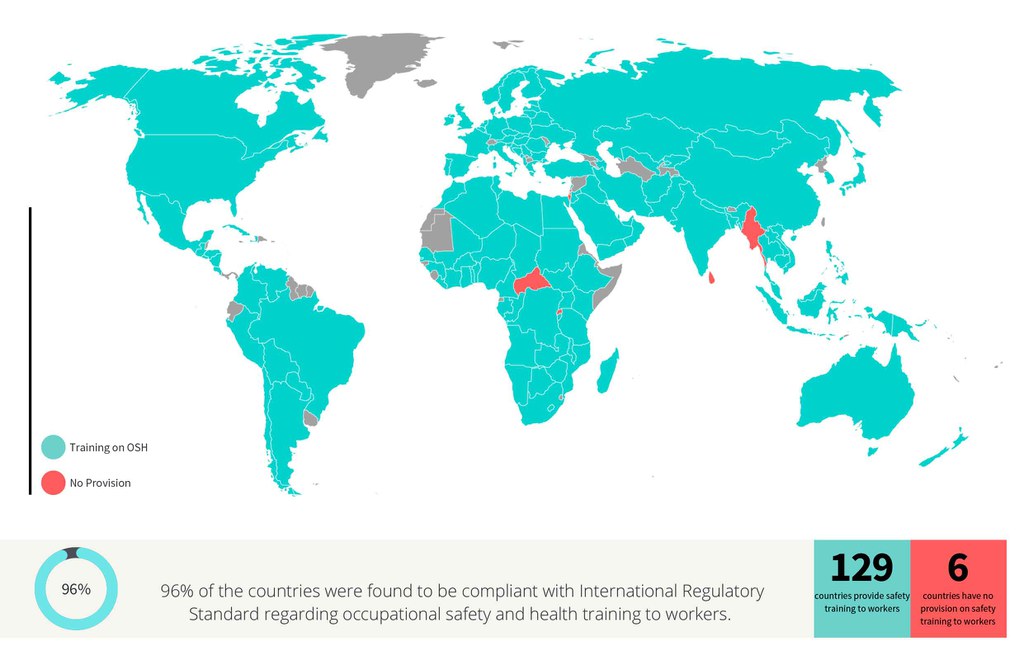
6.3 Restrictions on Work(for Pregnant or Nursing Women)
Does the law restrict work that is prejudicial to the health of the mother or the child?
International Regulatory Standard
From the Maternity Protection Convention, 2000 (No. 183), Article 3 states that after consulting the representative organisations of employers and workers, appropriate measures should be adopted to ensure that pregnant or breastfeeding women are not obliged to perform work which has been determined by the competent authority to be prejudicial to the health of the mother or the child, or where an assessment has established a significant risk to the mother’s health or that of her child.
Methodology
Whether law restricts work that is determined to be prejudicial to the health of the mother or the child:
1: The legislation restricts pregnant or nursing women from being obliged to perform arduous work and night work that is prejudicial to the health of the mother or the child. Based on the workplace assessment and medical certificate, legislation should require elimination of risk, adaptation of working conditions, transfer to another post without loss of pay, and access to paid leave when neither of the above is possible.
0: Arduous work and any of its other forms* are not restricted to pregnant or nursing workers, or there is a general prohibition only.
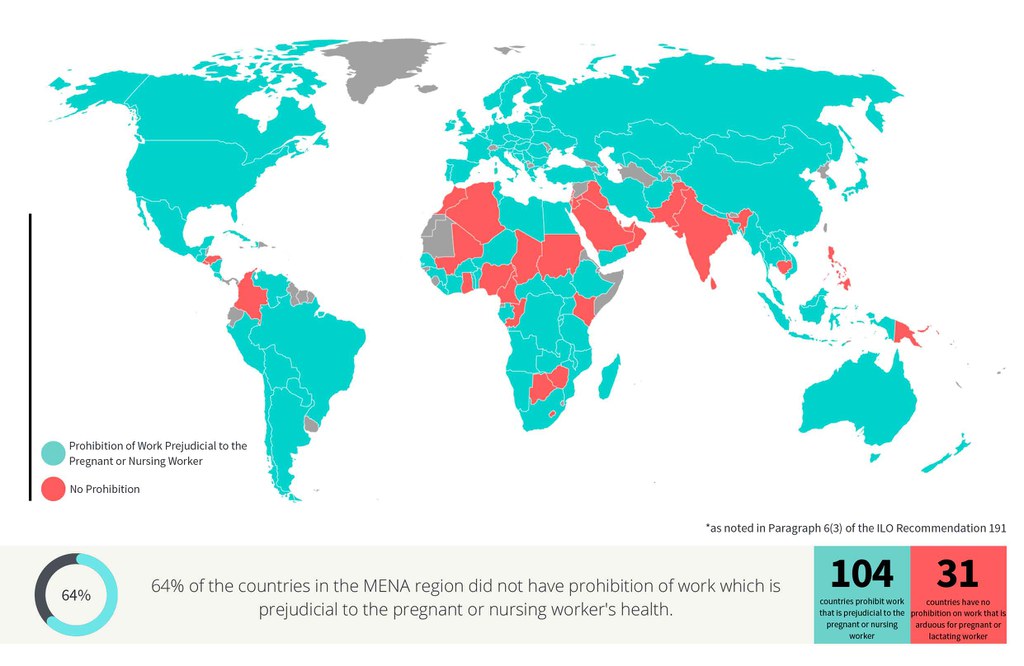
6.4 Employment Injury Benefits
Does the law provide for employment injury or disease benefits?
International Regulatory Standard
Social Security (Minimum Standards) Convention, 1952 (No. 102) stipulates the provision of employment injury benefits at the rate of at least 50 per cent (40 per cent for survivors) of a worker’s former wage. This applies to an accident or disease resulting from employment and the contingencies should cover a morbid condition; incapacity for work resulting from such a condition and involving suspension of earnings, as defined by national laws or regulations; total loss of earning capacity or partial loss thereof in excess of a prescribed degree, likely to be permanent, or corresponding loss of faculty; and the loss of support suffered by the widow or child as the result of the death of the breadwinner. In the case of a widow, the right to benefit may be made conditional on her being presumed, in accordance with national laws or regulations, to be incapable of self-support.*
Methodology
Whether legislation provides for employment injury benefits:
1: Employment injury or disease benefit is provided under the law and is paid through social insurance or where the employer pays a monthly premium to the private or public carrier (insurance provider) to provide employment injury benefits. 0: Employment injury benefit is not financed through the social insurance system (employer liability program only) or is not provided under the law.
3% of the 135 countries make employment injury benefits the employer's liability. Bangladesh, Gambia, Qatar and UAE require employers to pay benefits to workers injured on job.

Safe Work - Snapshot
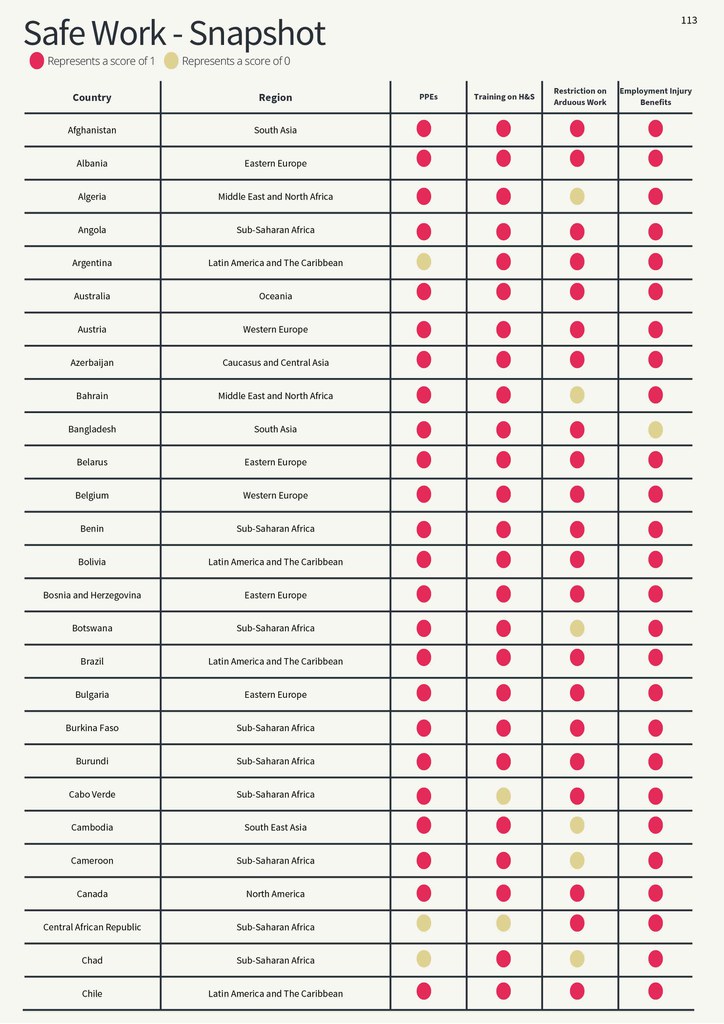
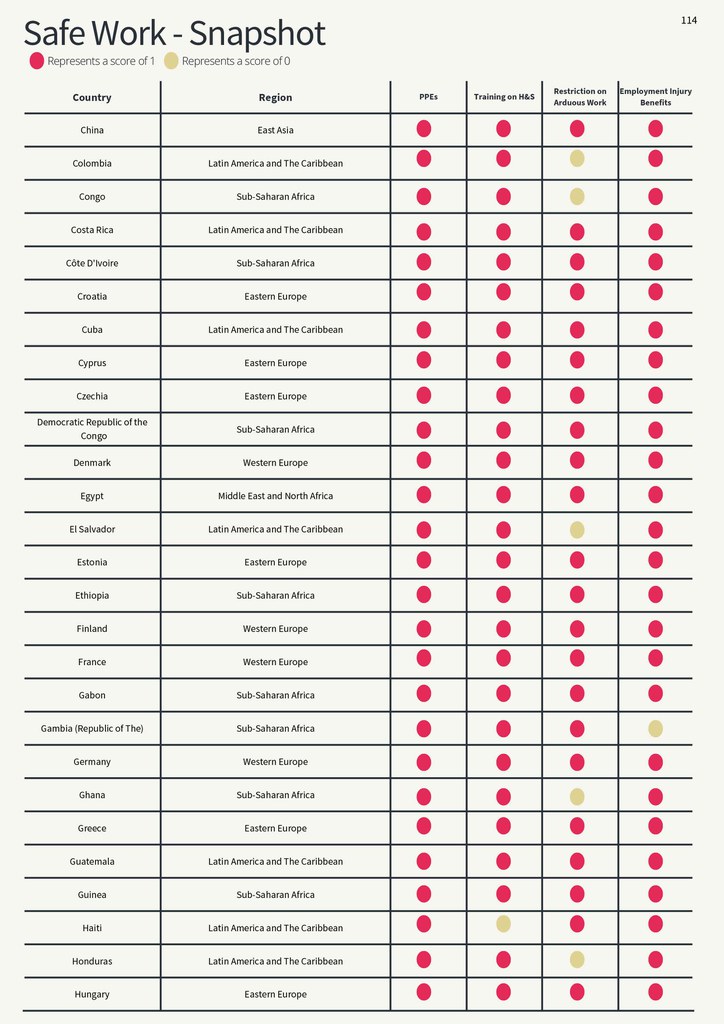

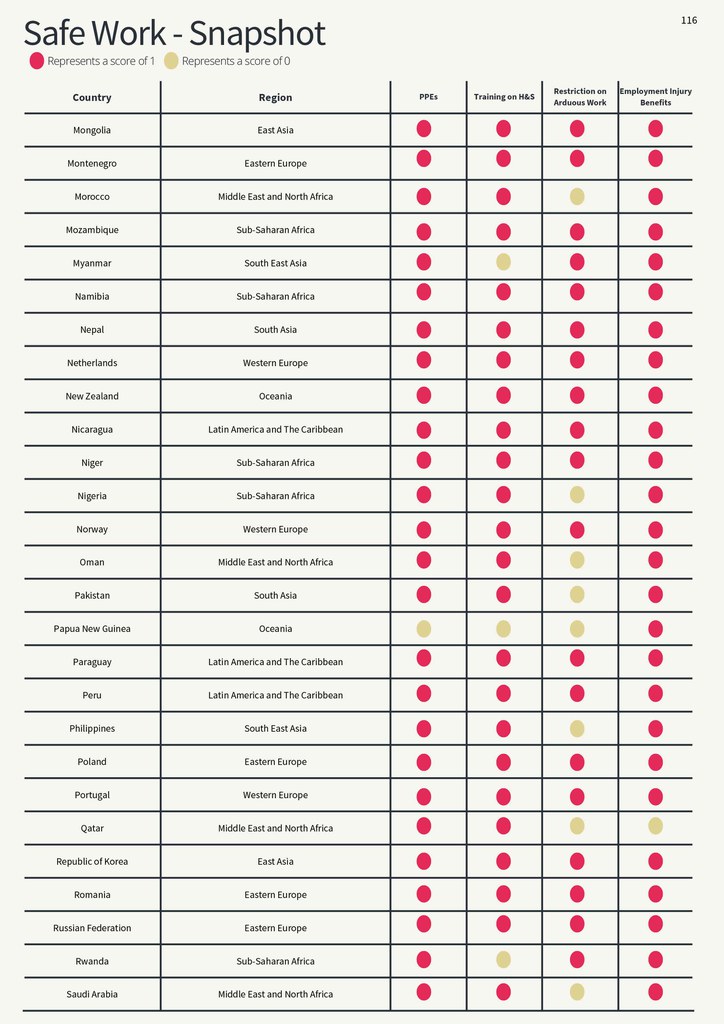
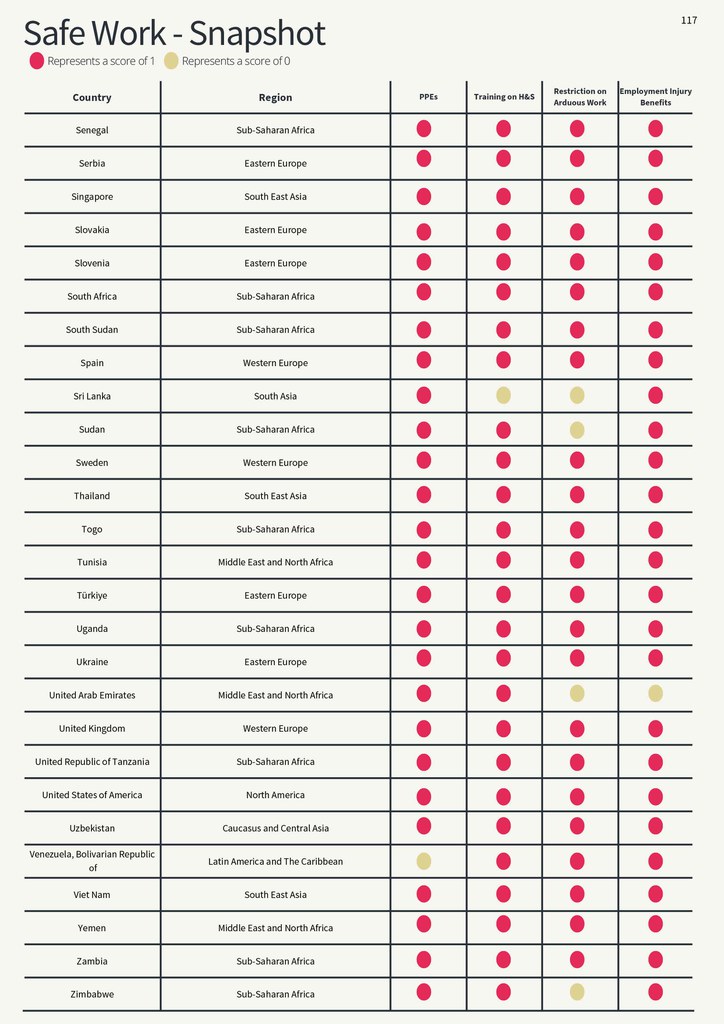
Social Security
Adequate social protection is an important aspect of decent work. Protection from the major risks in life through social protection helps keep people out of poverty and prevents them from being thrown into poverty when unforeseen catastrophes occur, such as an accident, an illness, loss of a job or in old age when work is impossible or very difficult
7.1 Old Age Pension
Does the law provide for old age pension?
International Regulatory Standard
Social Security (Minimum Standards) Convention, 1952 (No. 102) stipulates the provision of old-age benefits at the rate of 40 per cent of a worker’s former wage, where the contingency covered shall be survival beyond a prescribed age of not more than 65 years or such higher age as may be fixed by the competent authority with due regard to the working ability of elderly persons in the country concerned. National laws or regulations may provide that the benefit of a person otherwise entitled to it may be suspended if such person is engaged in any prescribed gainful activity or that the benefit, if contributory, may be reduced where the earnings of the beneficiary exceed a prescribed amount and, if non-contributory, may be reduced where the earnings of the beneficiary or his other means or the two taken together exceed a prescribed amount. The benefit shall be a periodical payment.
Methodology
Whether law provides for old-age pension:
1: Legislation creates a contributory old-age pension or if an old-age pension is paid through a non-contributory universal benefits system (both administered by the state).*
0: There is no explicit provision for the state-administered old age pension, it is employer liability, or the old age pension is means-tested.
87% of the assessed countries provide for a contributory old age pension, funded through a social insurance system.
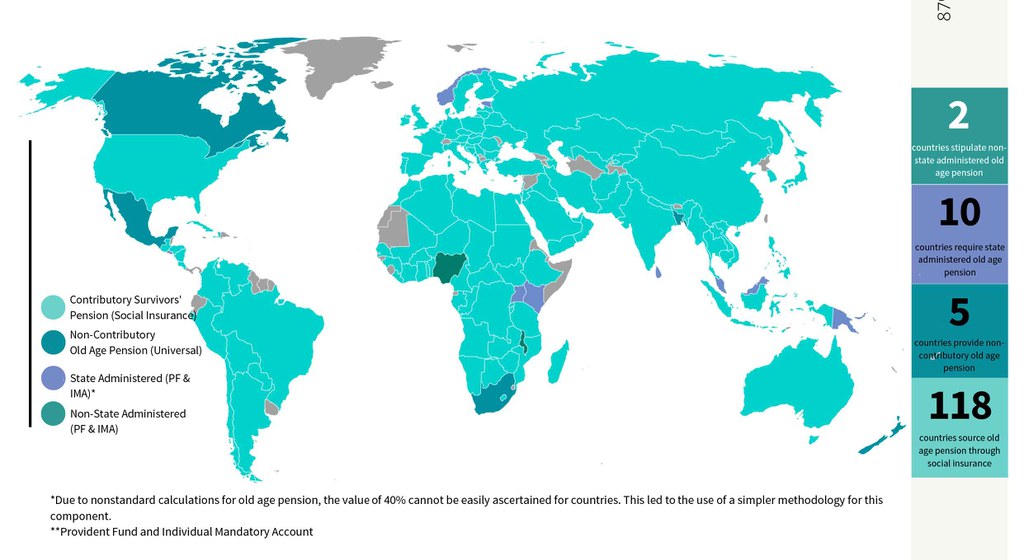
7.2 Dependents'/Survivors' Pension
Does the law provide for dependents'/survivors' pension?
International Regulatory Standard
Social Security (Minimum Standards) Convention, 1952 (No. 102) stipulates the provision of survivors’ benefits for wives and children of breadwinners at the rate of at least 40 per cent of the worker’s wage, where the contingency covered shall include the loss of support suffered by the widow or child as the result of the death of the breadwinner; in the case of a widow, the right to benefit may be made conditional on her being presumed, in accordance with national laws or regulations, to be incapable of self-support. National laws or regulations may provide that the benefit of a person otherwise entitled to it may be suspended if such person is engaged in any prescribed gainful activity or that the benefit, if contributory, may be reduced where the earnings of the beneficiary exceed a prescribed amount, and, if non- contributory, may be reduced where the earnings of the beneficiary or his other means or the two taken together exceed a prescribed amount. The benefit shall be a periodical payment.
Methodology
Whether law provides for survivors' /dependents’ pension:
1: The legislation provides for contributory social insurance or non-contributory universal benefits for the survivors’ or dependents’ pension in the event of workers’ or pensioners’ death once they are eligible for old-age pension or disability pension (both administered by the state).*
0: There is no explicit provision for state-administered survivors’ pension or is the employer’s liability or if survivors’ pension is means-tested.
Only 5% of the assessed countries require payment of survivors' pension through state administered provident funds and individual mandatory accounts.
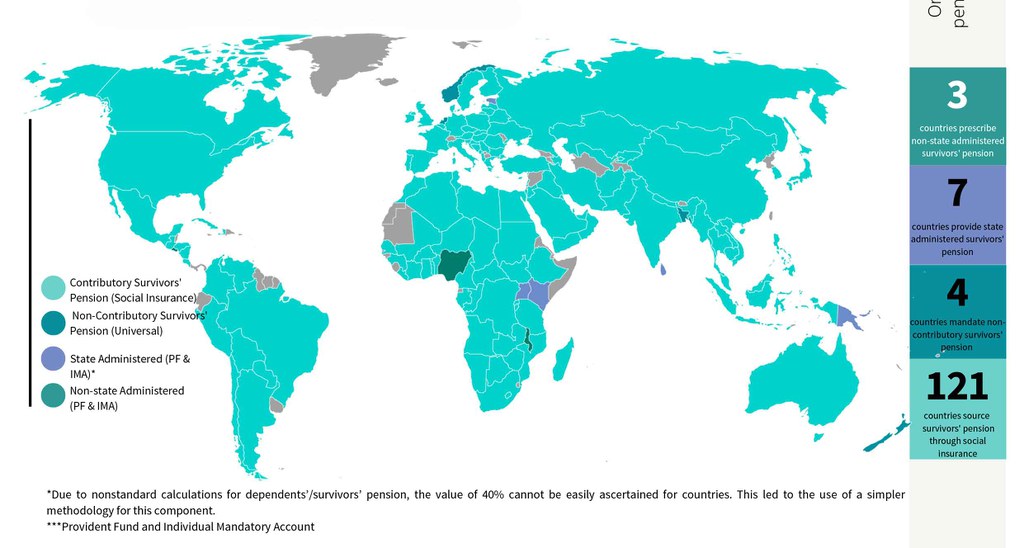
7.3 Unemployment Benefits
Does the law provide for unemployment benefits?
International Regulatory Standard:
Social Security (Minimum Standards) Convention, 1952 (No. 102) stipulates the provision of unemployment benefits at the rate of at least 45 per cent of a worker’s former wage, where the contingency covered should include earnings’ suspension as defined by national laws or regulations, due to inability to obtain suitable employment in the case of a person protected who is capable of, and available for, work. The minimum duration of the benefit shall be a periodical payment for 13 weeks in a period of 12 months or periodical payment for 26 weeks within 12 months where all residents whose means during the contingency do not exceed prescribed limits.
Methodology:
Whether law provides for unemployment benefits:
1: The legislation provides for unemployment benefits when a worker loses employment, either through a contributory social insurance system or a non- contributory universal benefits system.*
0: There is no explicit provision for a state-administered unemployment benefits system or where unemployment benefits are means-tested or where only severance pay is provided.
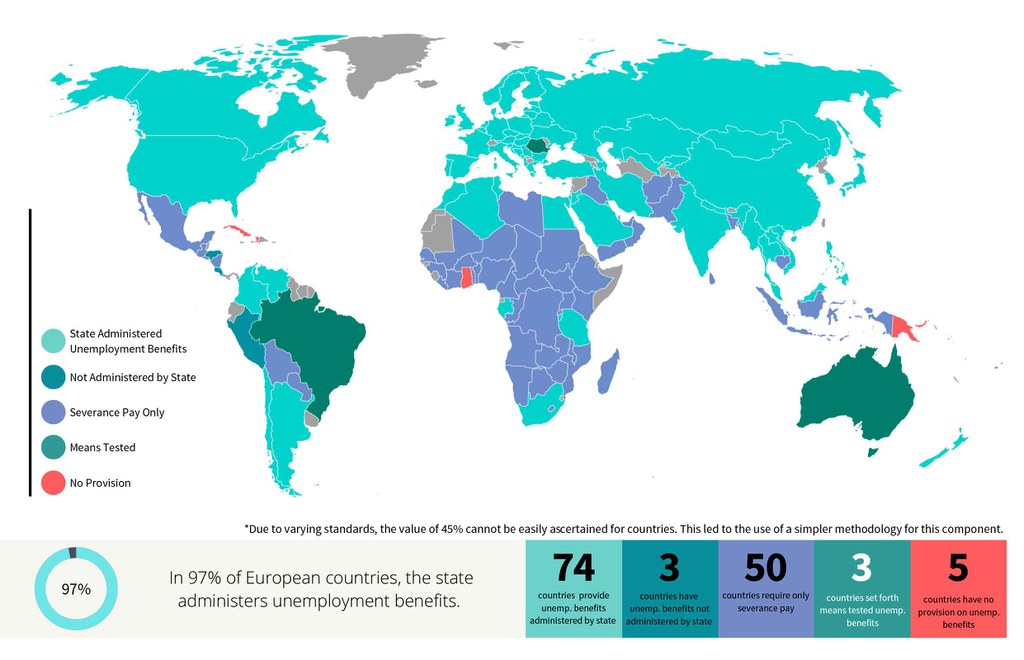
7.4a Sickness Benefits - Duration
Does the law require paid sick leave for the first six months of sickness?
International Regulatory Standard
Social Security (Minimum Standards) Convention, 1952 (No. 102) stipulates the provision of sickness benefits at the rate of at least 45 per cent of a worker’s former wage, where the contingency covered should include incapacity for work resulting from a morbid condition and involving suspension of earnings, as defined by national laws or regulations. The benefit shall be a periodical payment for the whole of contingency and limited to 26 weeks in each case of sickness, in which event it need not be paid for the first three days of suspension of earnings or where all residents whose means during the contingency do not exceed prescribed limits are protected.
Methodology
Whether law provides for paid sick leave for the first six months of sickness:
1: The legislation allows paid sick leave or sickness benefits for a minimum of the first six months of illness. The paid sick leave/sickness benefits must have been funded through a contributory social insurance system or universally accessible system.
0: Paid sick leave/sickness benefits are less than six months or if it is paid after a more than 10-day waiting period, or if it is only employer liability.
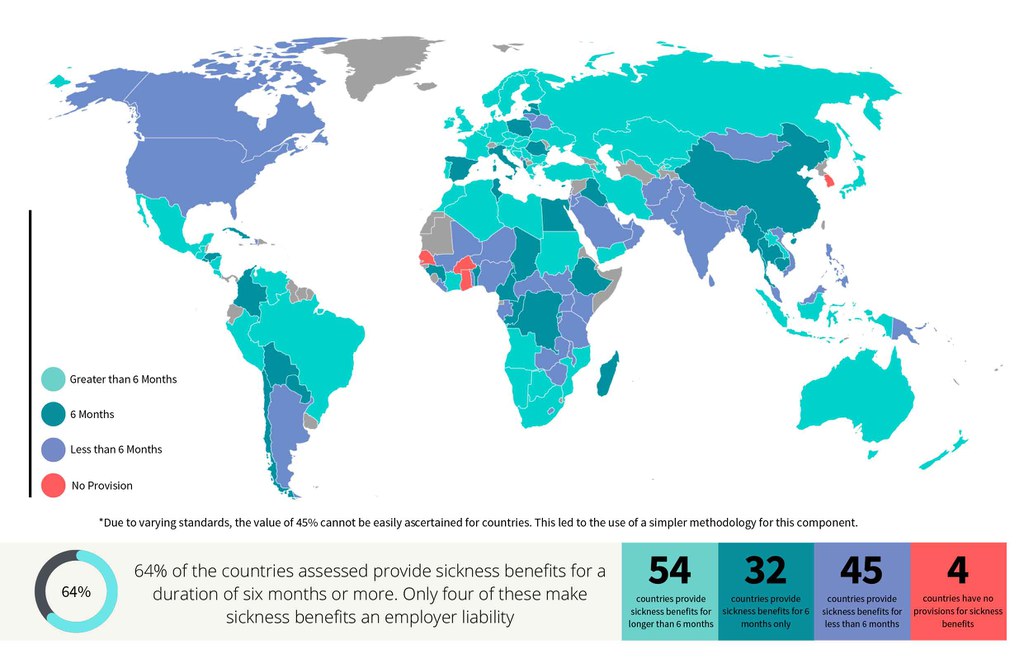
7.4b Sickness Benefits - Source
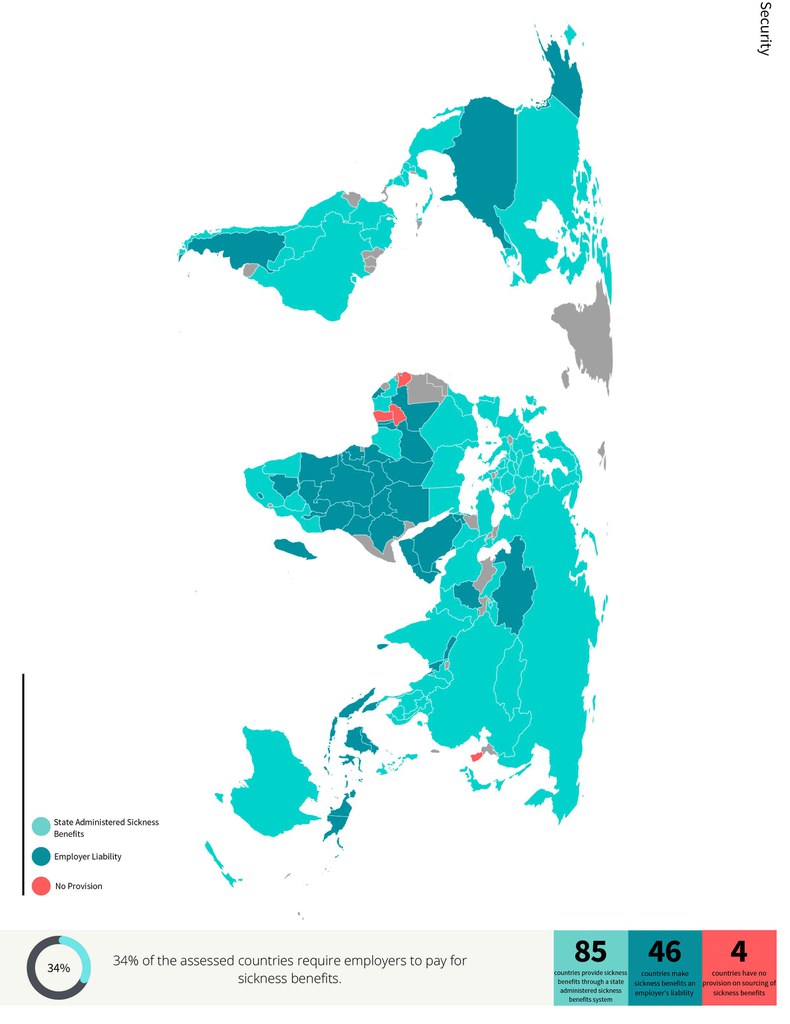
7.5 Invalidity Pension
Does the law provide for invalidity pension?
International Regulatory Standard
Social Security (Minimum Standards) Convention, 1952 (No. 102) stipulates the provision of invalidity benefit at the rate of 40 per cent of a worker’s former wage, where the contingency covered shall include the inability to engage in any gainful activity to an extent prescribed which inability is likely to be permanent or persists after the exhaustion of sickness benefit. The benefit shall be a periodical payment, and it shall be granted throughout the contingency or until an old- age benefit becomes payable.
Methodology
Whether legislation provides for invalidity pension:
1: Occupational disability or invalidity pension is provided under the law and is paid through a contributory social insurance system or through a non-contributory universal benefits system financed through general taxation (both administered by the state).*
0: The invalidity pension is only employer liability or means-tested, or if there is no explicit provision for a state-administered invalidity pension.
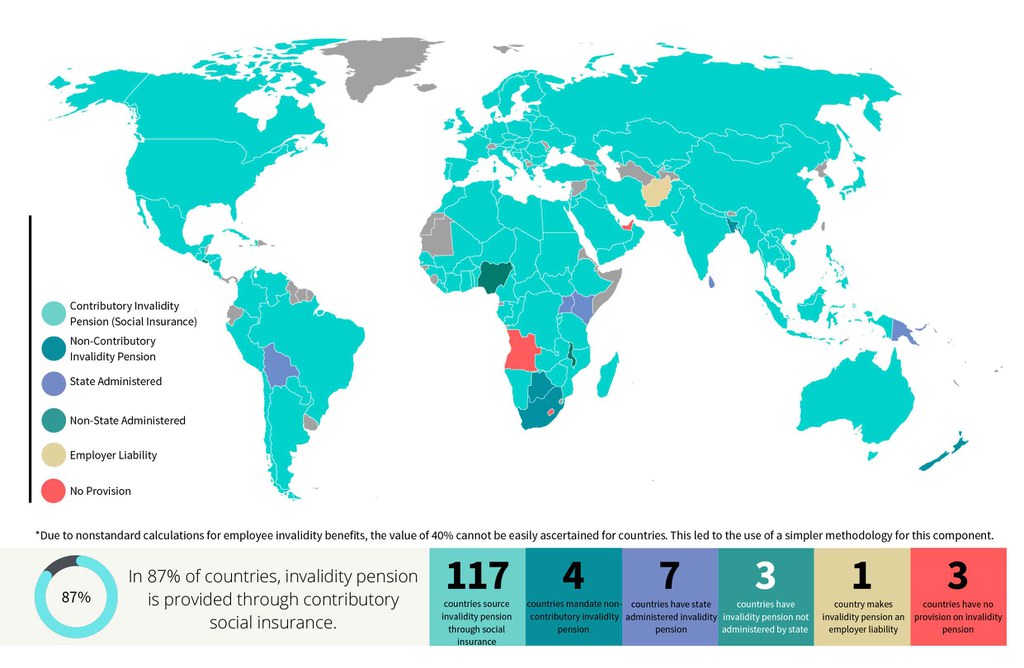
Social Security - Snapshot
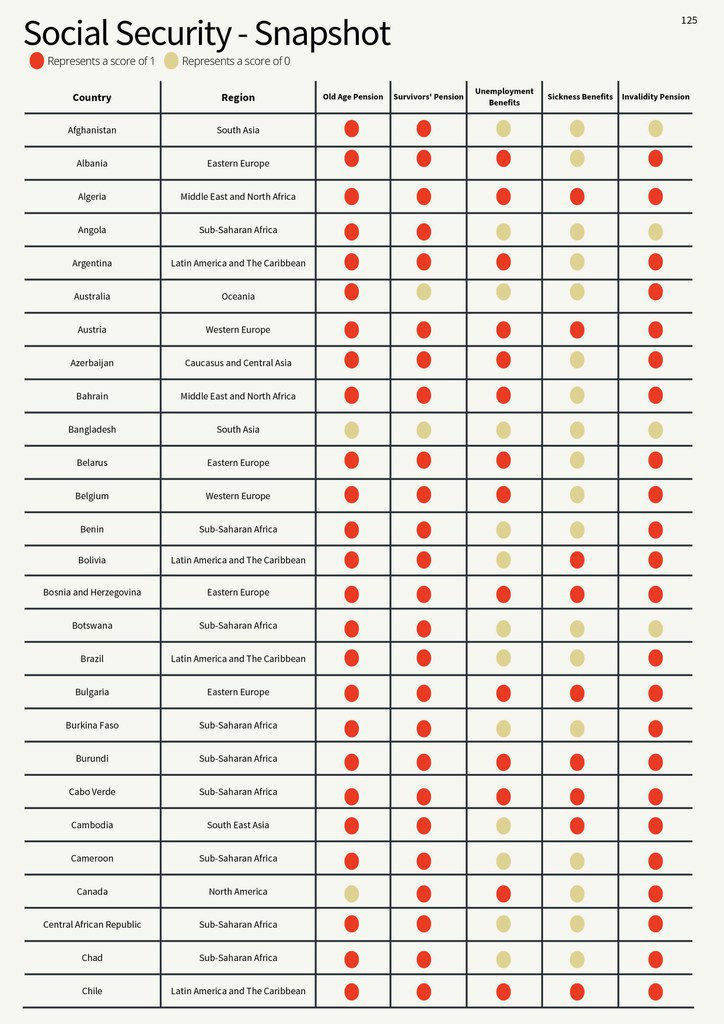
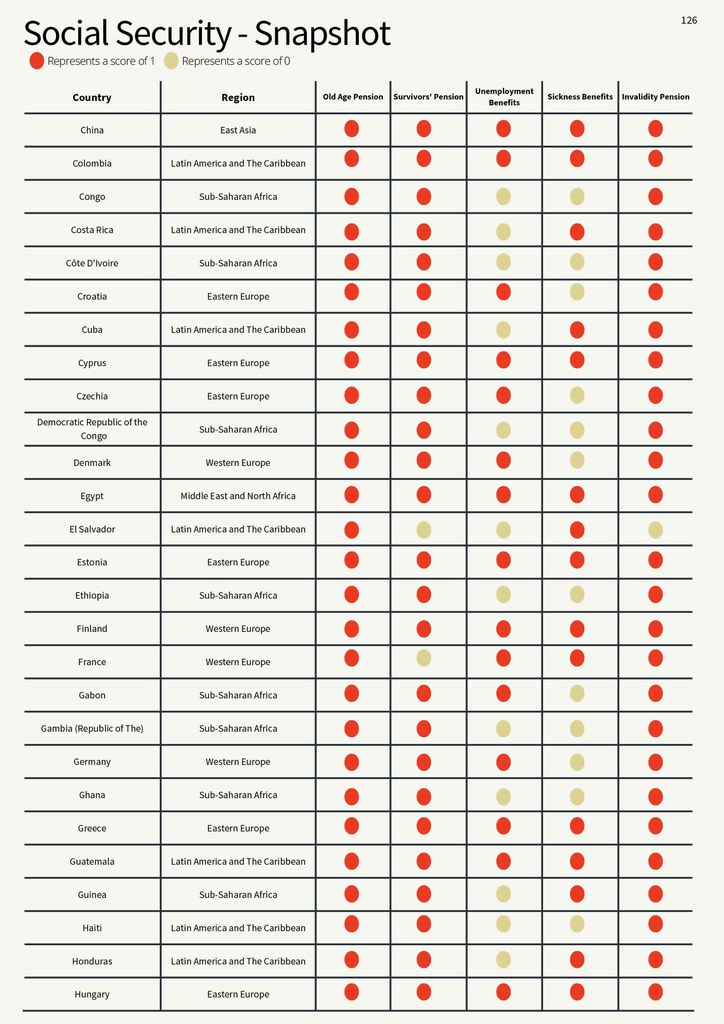
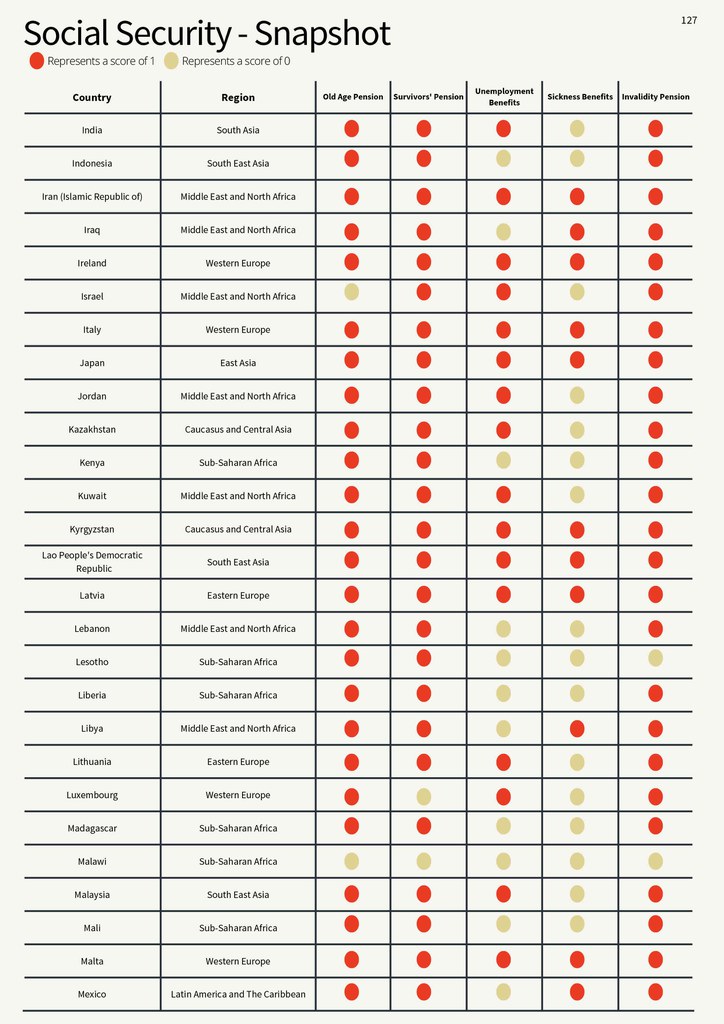
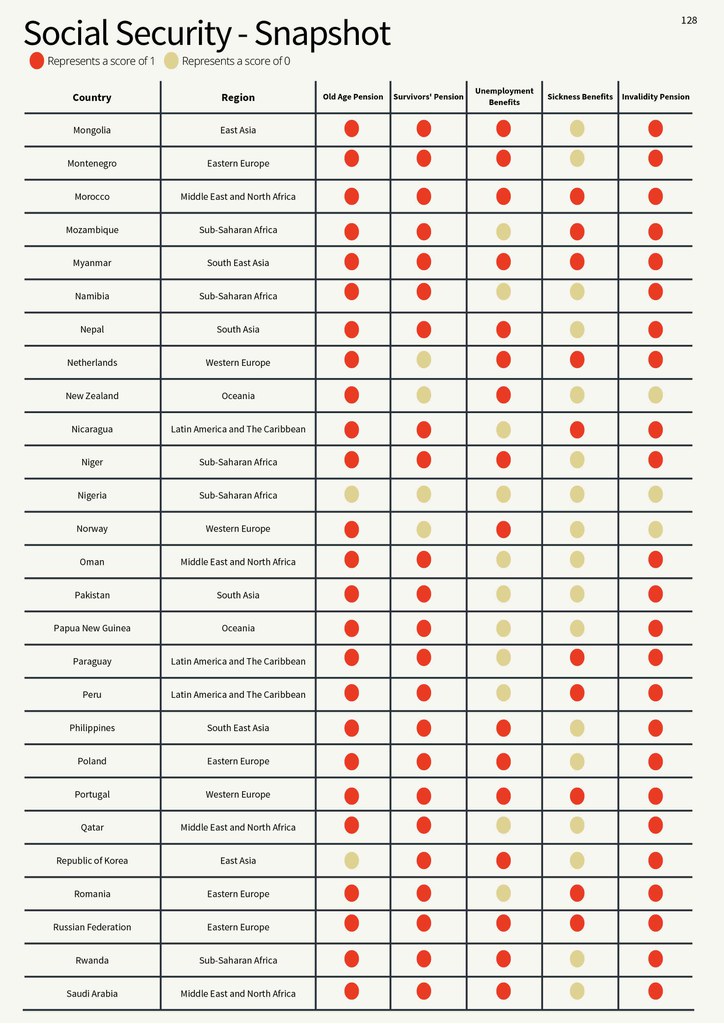
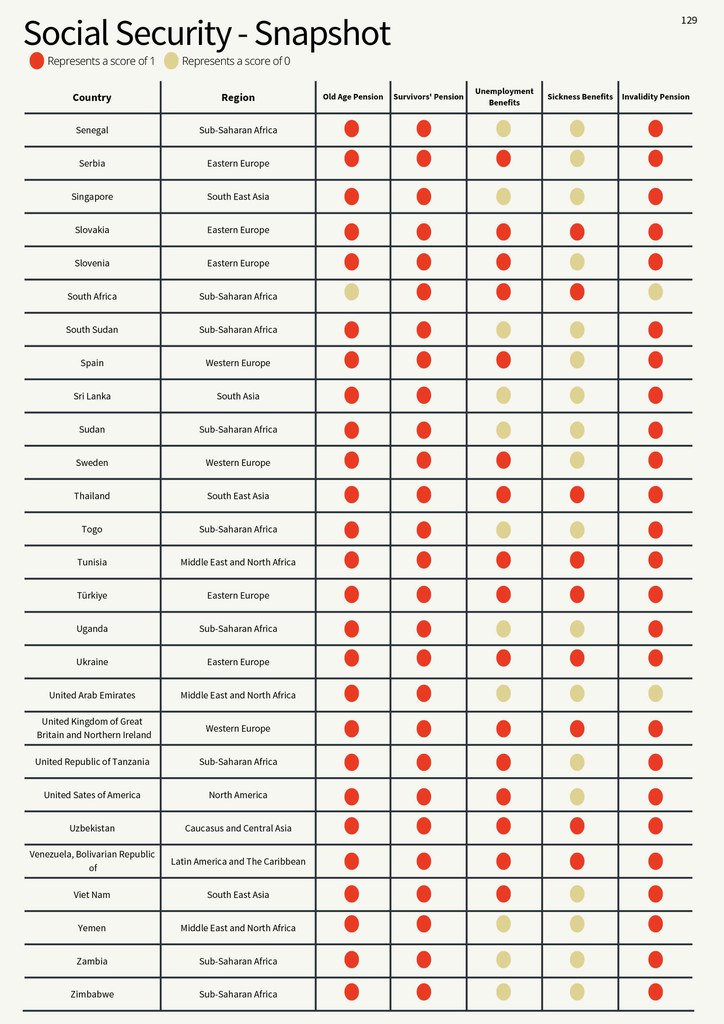
Fair Treatment
The Fair Treatment indicator measures legislation causing wage gap, discrimination in employment matters, sexual harassment at work, employment segregation and unequal access to basic labour protection for gig workers. Equal remuneration for all workers, referring to the rates of remuneration without discrimination based on gender and any other discriminatory grounds is the fundamental requirement for promoting non-discrimination at the workplace.
8.1 Equal Remuneration
Does the law require equal remuneration for men and women workers for work of equal value?
International Regulatory Standard
Article 2 of the Equal Remuneration Convention, 1951 (No. 100) stipulates that the principle of equal remuneration for men and women workers for work of equal value should be promoted and ensured for all workers by means appropriate to the methods in operation for determining rates of remuneration. This principle may be applied through national laws or regulations, legally established or recognised machinery for wage determination, collective agreements between employers and workers, or a combination of these various means.
Methodology
Whether the law requires equal remuneration for work of equal value:
1: The legislation mandates equal remuneration for male and female workers for work of equal value without discrimination on the grounds of sex.
0: The law limits the principle of equal remuneration to the same work, similar work, equal work or work of a similar nature.

8.2 Sexual Harassment in Employment
Does the law prohibit sexual harassment in employment?
International Regulatory Standard
Article 7 of the Violence and Harassment Convention, 2019 (No. 190) states that without prejudice to and consistent with Article 1 (definitions of violence and harassment as well as gender-based violence and harassment), each Member shall adopt laws and regulations to define and prohibit violence and harassment in the world of work, including gender-based violence and harassment. Article 10 of the Convention suggests that members may impose sanctions, where appropriate, in cases of violence and harassment in the world of work.
Methodology
Whether law prohibits sexual harassment at work:
1: The legislation protects against workplace sexual harassment.
0: There is no such legislation or if it addresses harassment in general or has a general prohibition on harassment only without any criminal penalties (either fines or imprisonment) or civil remedies (monetary compensation for victims and recovery of damages).

8.3 Discrimination in Employment
Does the law prohibit discrimination in employment matters?
International Regulatory Standard
Article 2 of the Discrimination (Employment and Occupation) Convention, 1958 (No. 111) states that equality of opportunity and treatment in respect of employment and occupation, with the purpose of eliminating any discrimination, should be promoted.
Article 8 of the Maternity Protection Convention, 2000 (No. 183) prohibits employers from terminating the employment of a woman during her pregnancy or absence on leave or during a period following her return to work to be prescribed by national laws or regulations, except on grounds unrelated to the pregnancy or birth of the child and its consequences or nursing.
Methodology
Whether the law prohibits discrimination in employment:
1: The law prohibits employers from discrimination or mandates equal treatment of all workers in an employment matter. A score of 1 is assigned only if a country has prohibited discrimination on at least seven of the above ten grounds.
0: the law does not prohibit such discrimination or only prohibits such in one aspect of employment, such as pay or dismissal. The prohibited grounds for discrimination are “race, colour, sex, religion, political opinion, national extraction or social origin, age, disability and trade union membership".
27% of the countries, representing more than 52% of the global labour force, do not prohibit discrimination in employment on at least 7 of the 10 grounds.
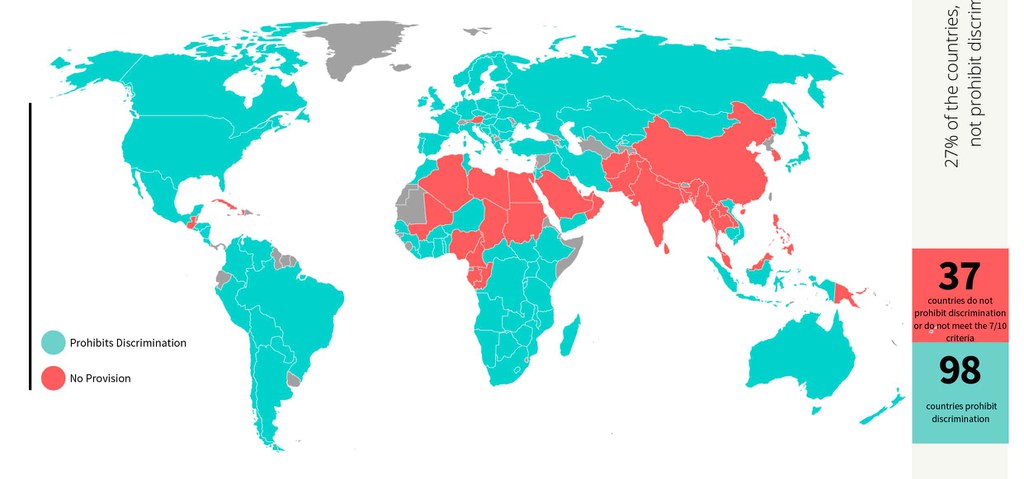
8.4 Access to Same Jobs as Men
Does the law allow women to do the same job as men?
International Regulatory Standard
The Discrimination (Employment and Occupation) Convention, 1958 (No. 111) requires each ratifying Member to declare and pursue a national policy designed to promote, by methods appropriate to national conditions and practice, equality of opportunity and treatment in respect of employment and occupation, to eliminate any discrimination in respect thereof.
Methodology
Whether the law allows women to do the same jobs as men:
1: The legislation does not restrict non-pregnant and non-nursing women from working in the same jobs as men.
0: The law prohibits or restricts women from working in jobs deemed hazardous, arduous, morally inappropriate and during night hours.
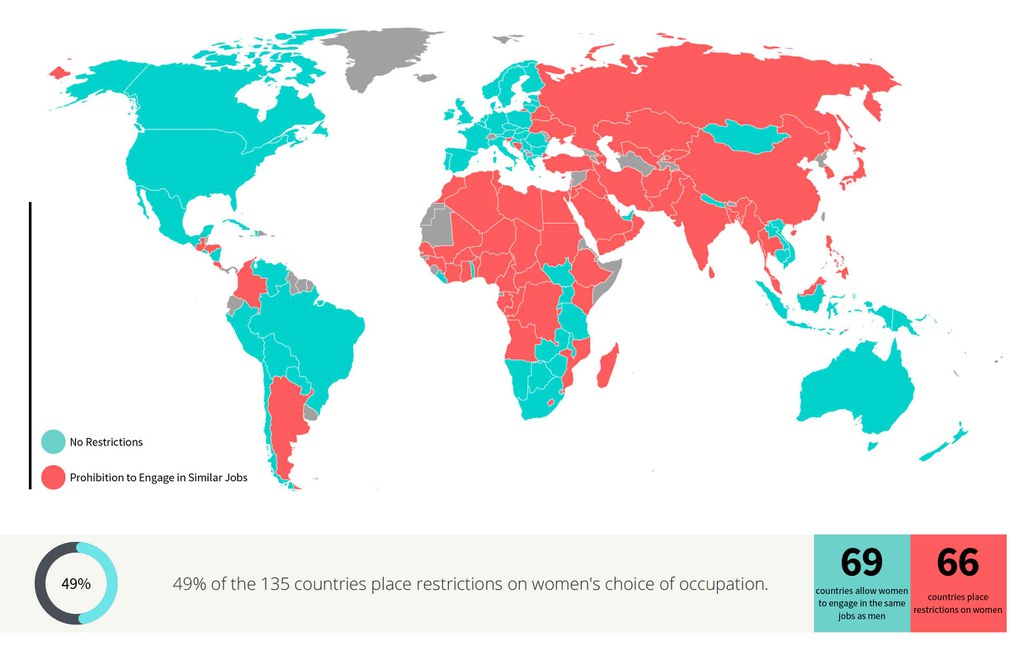
8.5 Basic Social Protection - Gig Economy
Does the law guarantee basic labour protection to the gig economy workers?
International Regulatory Standard
The Global Commission on the Future of Work 2019 recommended the development of an “international governance system for digital labour platforms”, requiring platforms (and clients) to respect certain minimum rights and protections. The Maritime Labour Convention 2006 (MLC, 2006) can be used as an example.
Similarly, provisions of the Tripartite Declaration of Principles concerning Multinational Enterprises and Social Policy (MNE Declaration) 2017, can be used as guiding principles.
Methodology
Whether the law guarantees basic labour protection to the gig economy worker:*
1: Considering the new phenomenon of the gig economy, a score of 1 is currently assigned to all such countries which provide at least the basic social protection** (old age pension, survivors’ benefits and invalidity benefits) to self-employed workers.
0: The basic social protection is not afforded to self- employed workers or where access to these benefits is linked to citizenship.
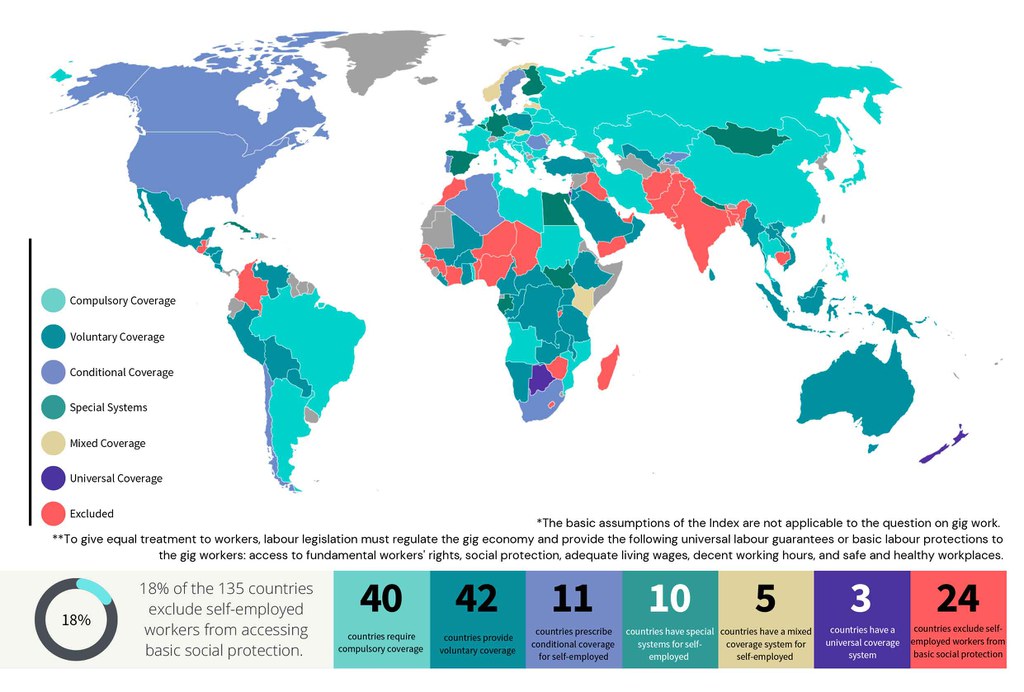
Fair Treatment - Snapshot
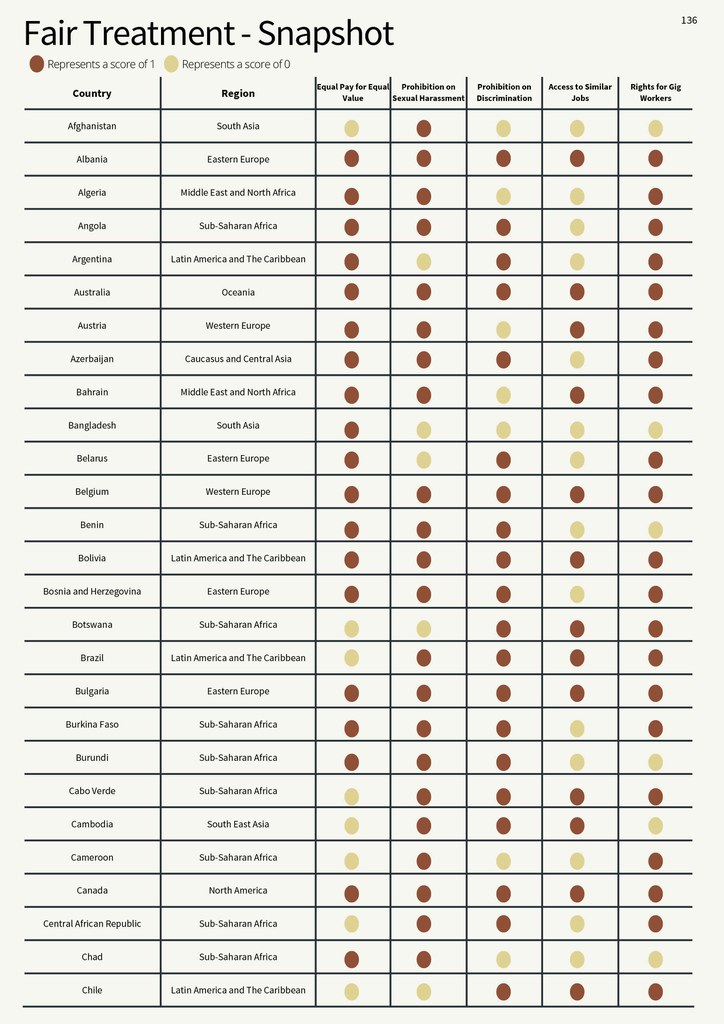
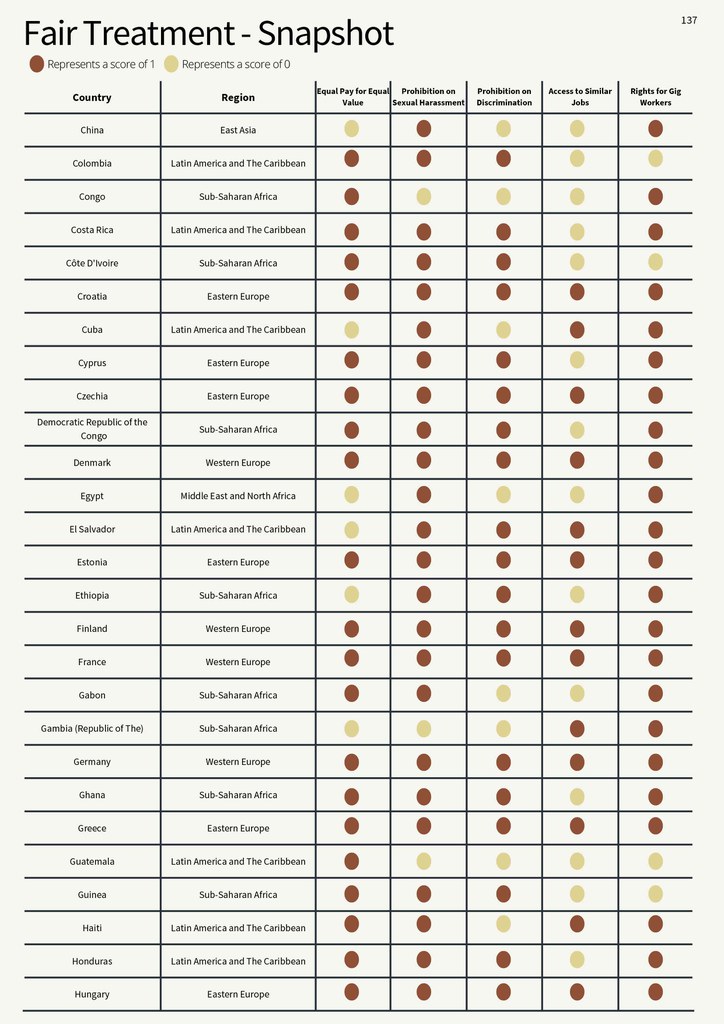
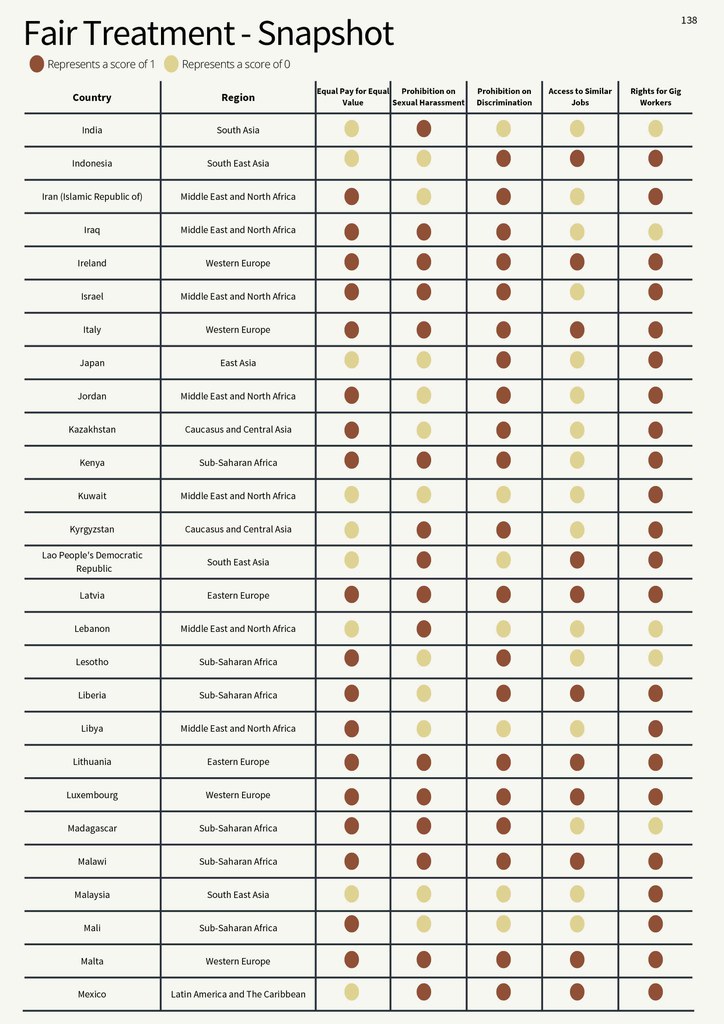
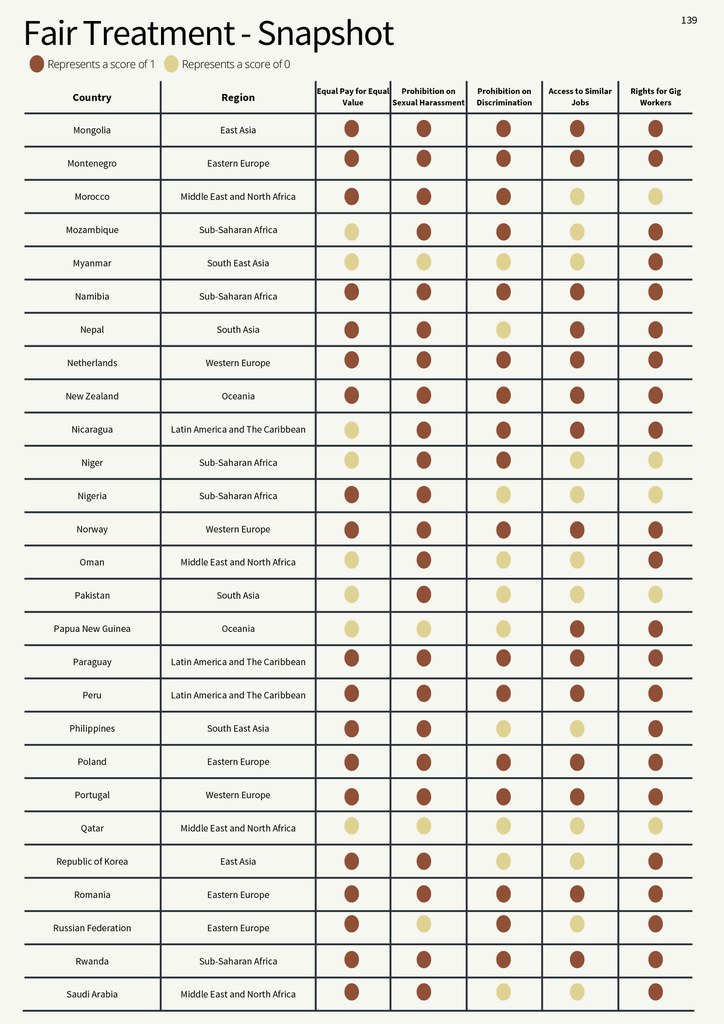
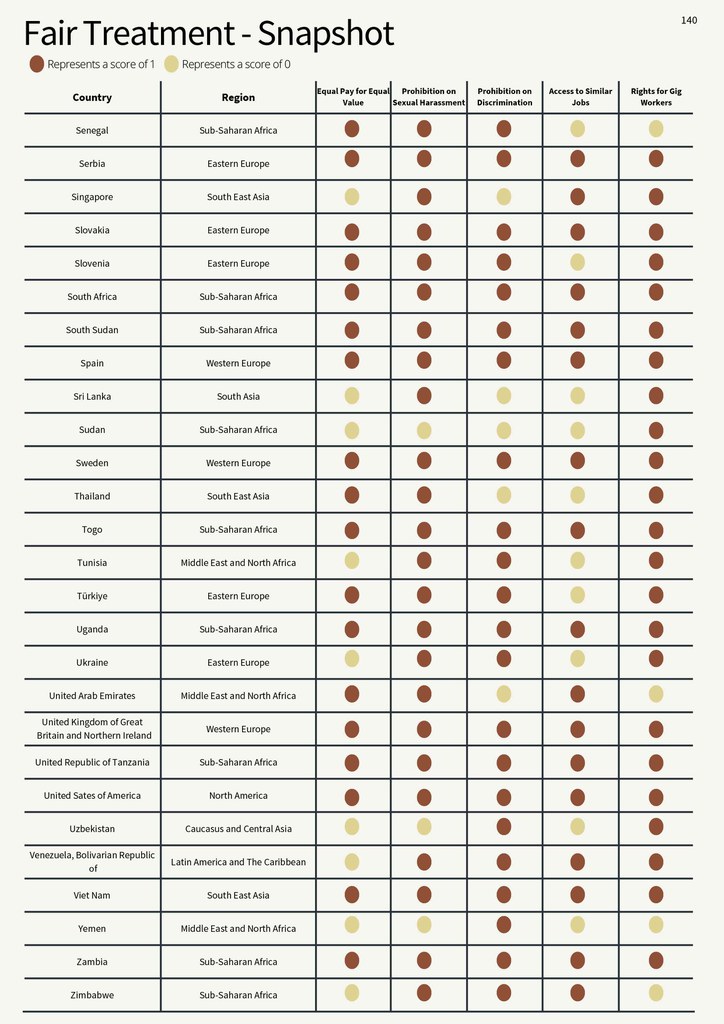
Child and Forced Labour
The Child and Forced Labour indicator measures legislation regulating the employment of children and linking this employment to their compulsory education.
The indicator also measures whether legislation prohibits forced labour.
9.1 Employment Age
Does the law prohibit employment of children?
International Regulatory Standard
Article 2 of Minimum Age Convention 1973 (No. 138) states that a minimum age for admission to employment or work shall not be less than the age of completion of compulsory schooling and, in any case, shall not be less than 15 years.
However, a ratifying Member whose economy and educational facility are insufficiently developed may, after consultation with the organisations of employers and workers concerned, initially specify a minimum age of 14 years.
Article 32(2) of the Convention on the Rights of the Child can be applied here as well. It states that the States Parties shall take legislative, administrative, social and educational measures to ensure the implementation of a minimum age or minimum age for admission to employment; provide for appropriate regulation of the hours and conditions of employment; Provide for appropriate penalties or other sanctions to ensure the effective enforcement of the present article.
Methodology
Whether the law prohibits the employment of children:
1: The legislation prohibits the employment of children under the age of 15 years (14 years in the case of developing countries).
0: The employment entry age is lower than 15 years (14 years in the case of developing countries).
19% of the assessed countries, spread across Africa, Americas and Asia, set the minimum age for employment at 14.
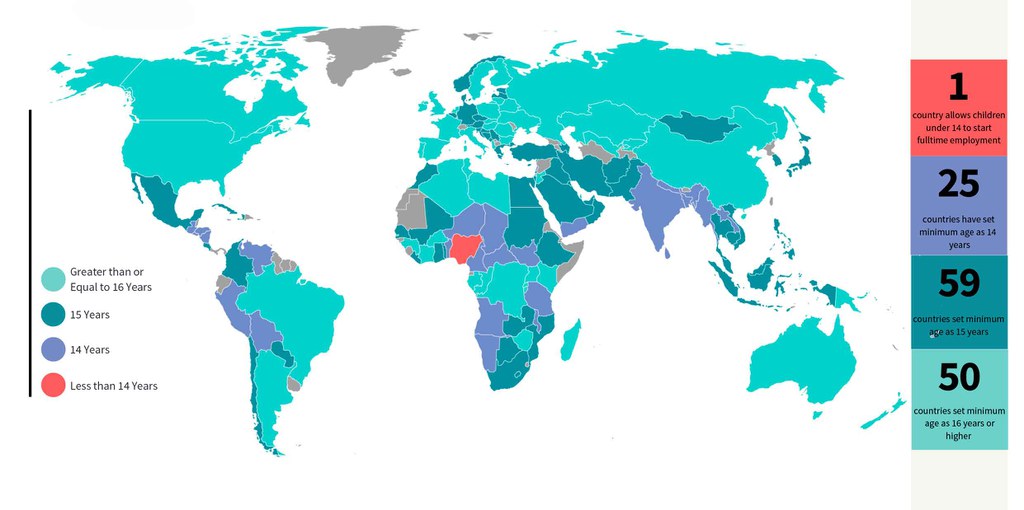
9.2 Compulsory Schooling Age
Does the law set employment entry age equal or higher than the compulsory schooling age?
International Regulatory Standard
Article 2(3) of Minimum Age Convention 1973 (No. 138) specifies that the minimum age for employment shall not be less than the age of completion of compulsory schooling and, in any case, shall not be less than 15 years (14 years for developing countries).
Methodology
Whether employment entry age is similar or higher than the compulsory education age:
1: The legislation sets the employment entry age similar to or higher than the compulsory education age.
0: The employment entry age is lower than the compulsory education age or if the compulsory schooling age is not defined under the law.
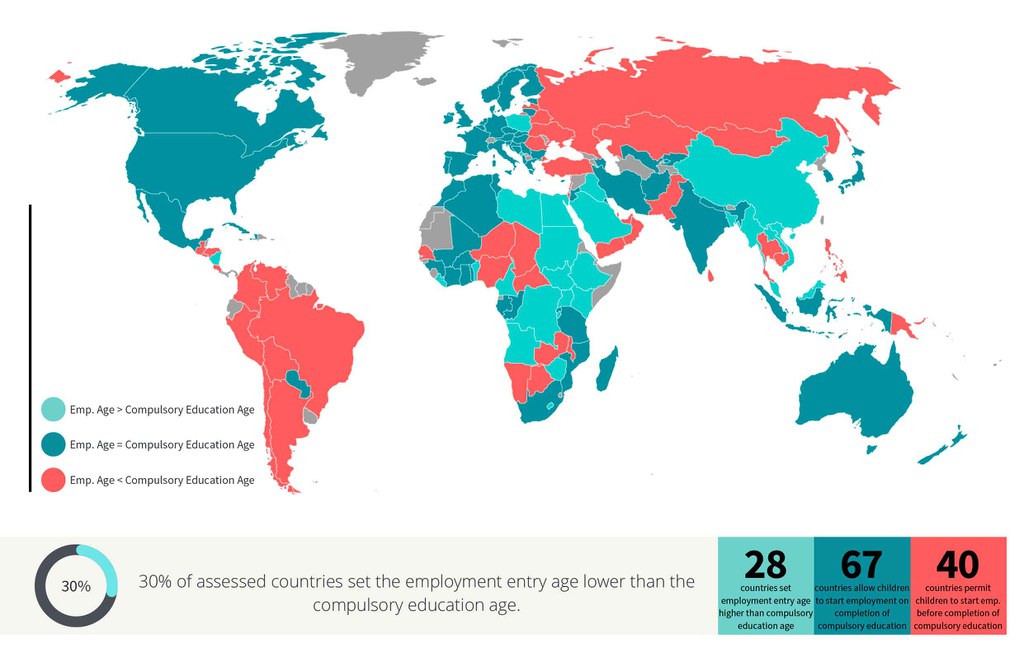
9.3 Age for Hazardous Work
Does the law prohibit the employment of children in hazardous work under the age of 18 years?
International Regulatory Standard
Article 3 of Minimum Age Convention 1973 (No. 138) stipulates that the minimum age for admission to any type of employment or work which, by its nature, or the circumstances in which it is carried out, is likely to jeopardise the health, safety or morals of young persons shall not be less than 18 years. The types of employment or work shall be determined by national laws or regulations or by the competent authority, after consultation with the organisations of employers and workers concerned, where such exist. National laws or regulations or the competent authority may authorise employment or work from the age of 16 years on the condition that the health, safety and morals of the young persons concerned are fully protected and that the young persons have received adequate specific instruction or vocational training in the relevant branch of activity.
Furthermore, Article 32 (1) of the Convention on Rights of Child states that there should be recognition of the right of the child to be protected from economic exploitation and from performing any work that is likely to be hazardous or to interfere with the child’s education, or to be harmful to the child’s health or physical, mental, spiritual, moral or social development.
Methodology
Whether the law prohibits the employment of adolescents in hazardous work:
1: The legislation prohibits the employment of children under the age of 18 years in hazardous work.*
0: The employment entry age for hazardous work is lower than 18 years or is not specified.
97% of the assessed countries set the minimum age for hazardous work at 18, making it a global standard.
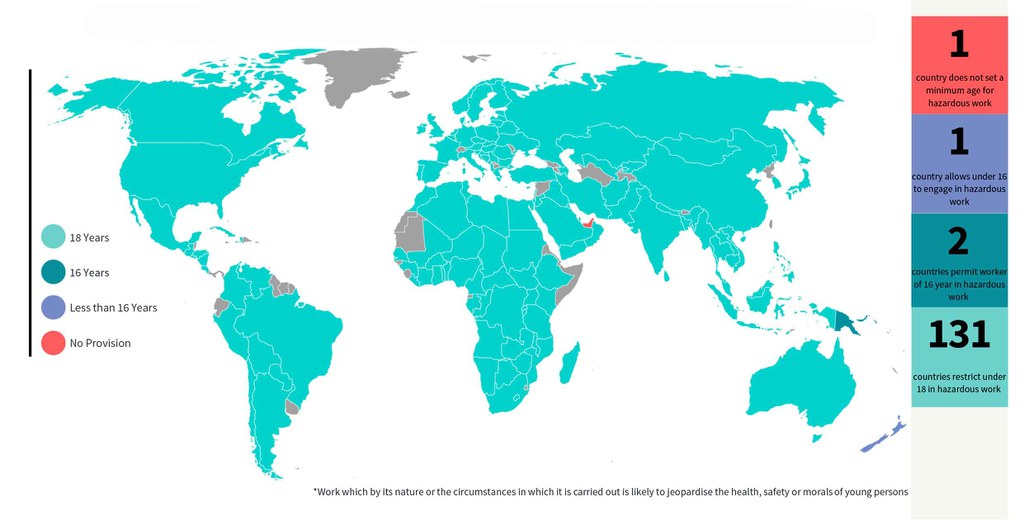
9.4 Forced Labour
Does the law prohibit forced labour?
International Regulatory Standard
Article 2 of the Forced Labour Convention, 1930 (No. 29) specifies that forced or compulsory labour means all work or service (with some exceptions) which is exacted from any person under the menace of any penalty and for which the said person has not offered himself voluntarily.
Protocol of 2014 to the Forced Labour Convention, 1930 focuses on taking effective measures to prevent and eliminate the use of forced or compulsory labour, to provide protection to victims and access to appropriate and effective remedies, such as compensation, and sanction the perpetrators of forced or compulsory labour. It also refers to specific action against trafficking in persons for the purposes of forced or compulsory labour.
Article 8 of the International Covenant on Civil and Political Rights states that no one shall be held in slavery or servitude; slavery and the slave trade in all their forms shall be prohibited, and no one shall be required to perform forced or compulsory labour.
Methodology
Whether the law prohibits forced labour:
1: The legislation prohibits forced labour except in certain extraordinary circumstances.
0: The law does not prohibit forced labour or has only a general prohibition without any sanctions.
More than 95% of the countries prohibit forced labour and impose penal sanction on those involved in the crime.

Child and Forced Labour - Snapshot
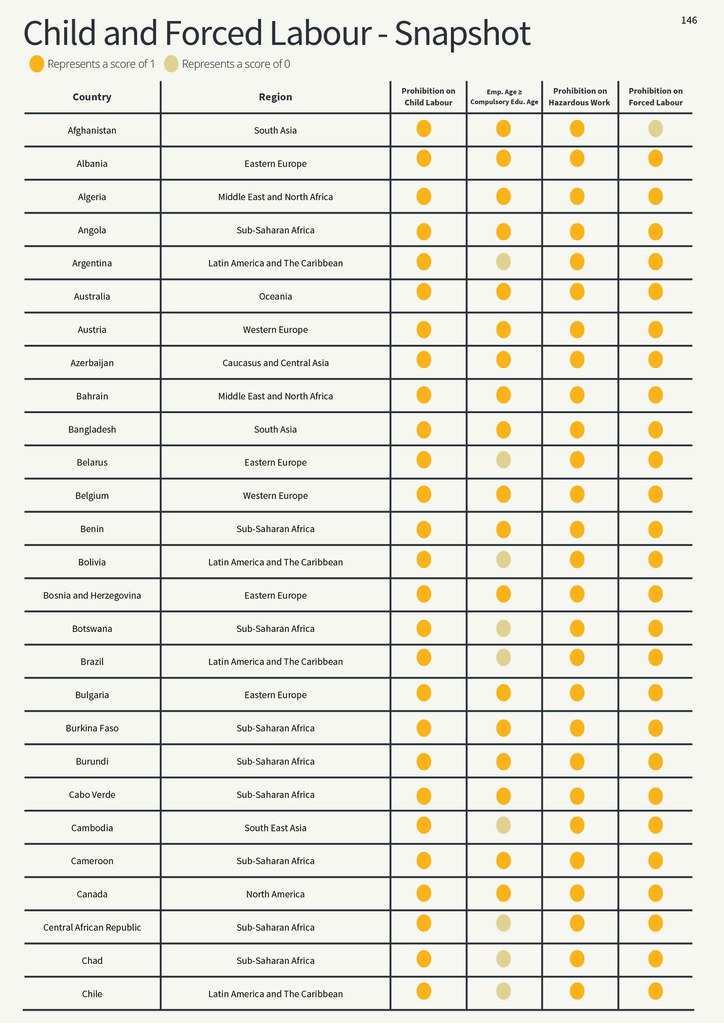
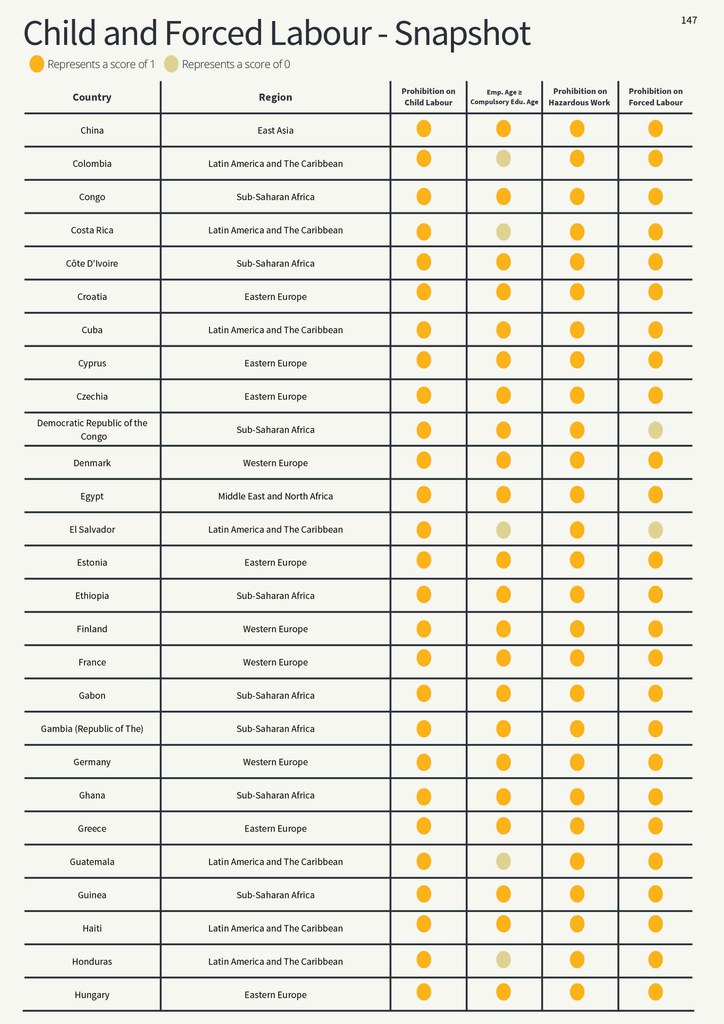
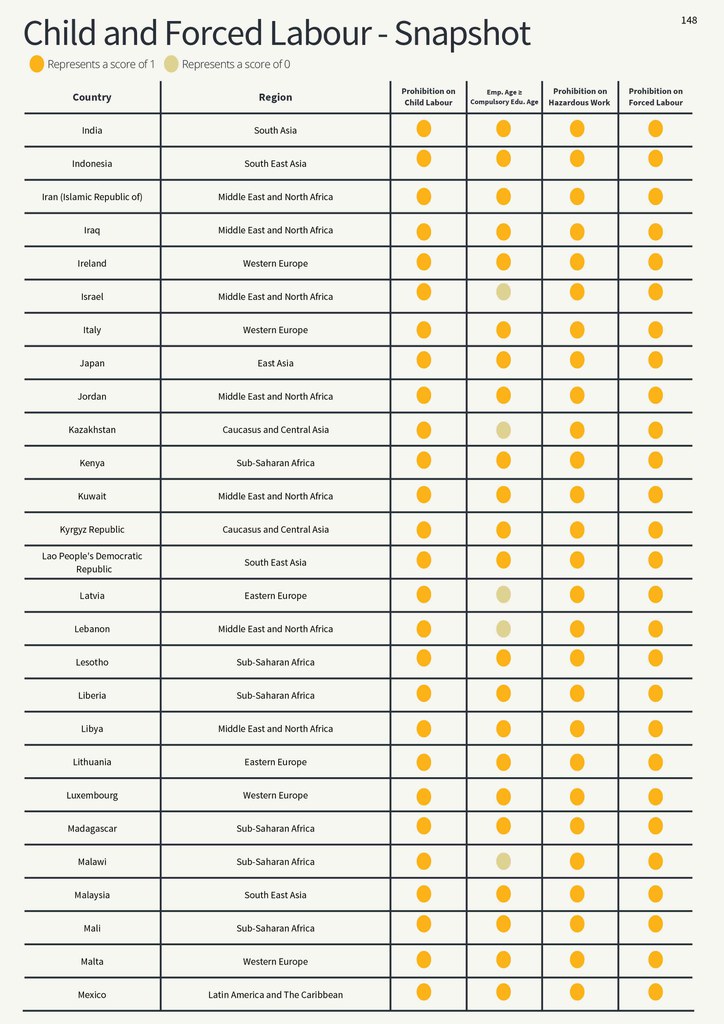
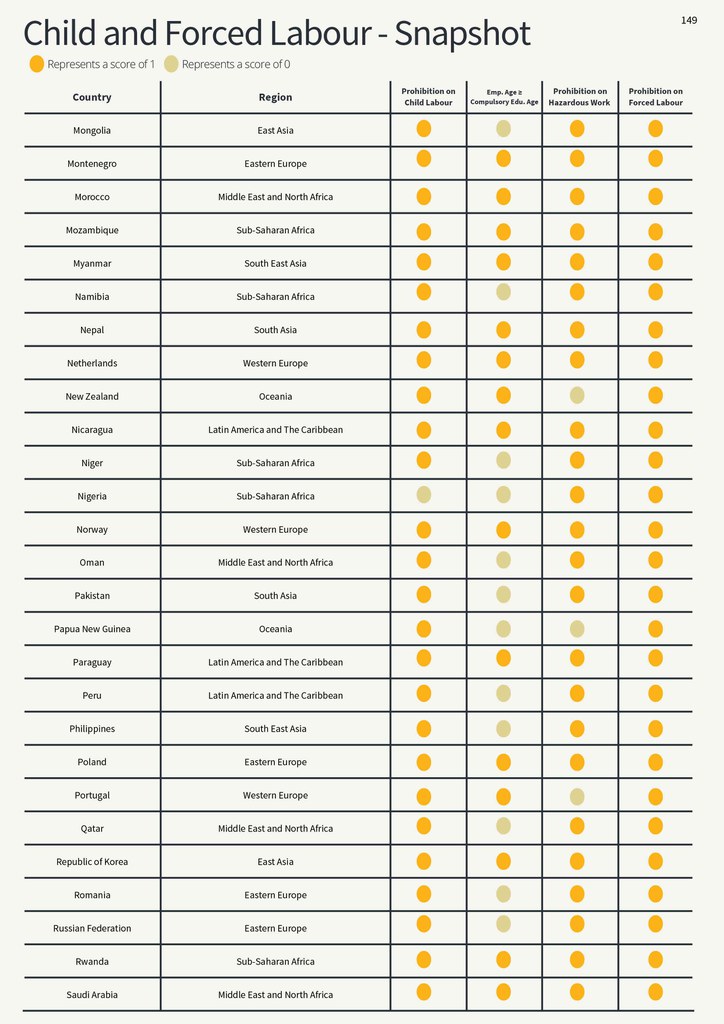

Trade Union
The Trade Union indicator measures legislation regulating freedom of association, the right to collective bargaining as well as the
right to strike.
The indicator also measures whether law prohibits employers from replacing workers on a legal strike.
10.1 Freedom of Association
Does the law allow workers to form and join unions of their own choice?
International Regulatory Standard
Article 2 of the Freedom of Association and Protection of the Right to Organise Convention, 1948 (No. 87) states that workers and employers, without distinction whatsoever, shall have the right to establish and, subject only to the rules of the organisation concerned, to join organisations of their own choosing without previous authorisation.
Methodology
1: The legislation allows workers to form and join organisations of their own choice except for armed forces, police, and public administration workers engaged in the administration of the state.
0: There is an explicit general prohibition in law of the right to establish and join organisations, or the law prohibits more than one trade union in a single enterprise, or there is a state monopoly through the imposition of a single organisation to which workers must belong.
Workers are excluded from the right to form and join organisations of their own choice based on exclusionary criteria like race, political opinion, nationality, age or on the grounds of occupational categories (public or private sector).
The legislation places excessive requirements on the right to organise in an enterprise by setting a minimum number of workers for registration of a trade union (minimum of 50 workers) or a high percentage of workers to be union members (more than 10% of total workers).
43% of the 135 countries prevent workers from their right to practice freedom of association.
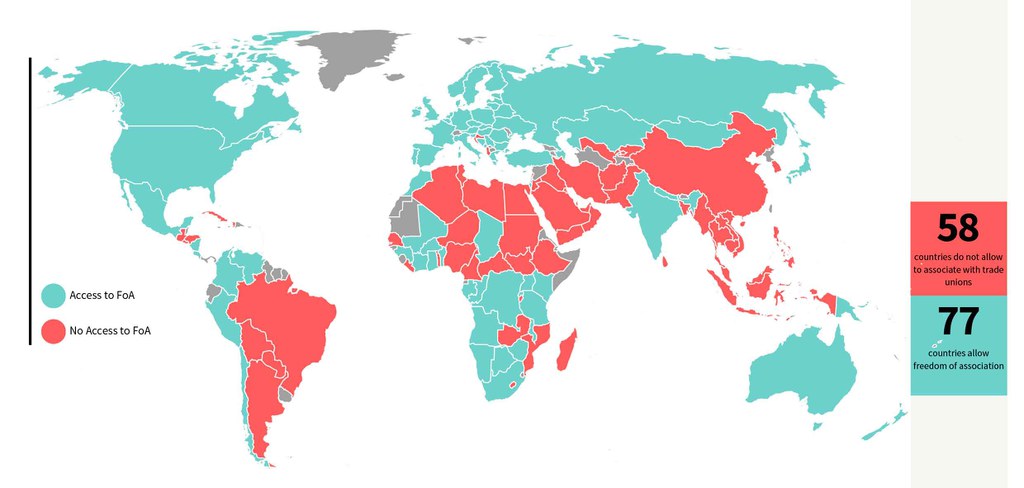
10.2 Collective Bargaining
Does the law allow workers to bargain collectively with employers through their representative unions?
International Regulatory Standard
Article 4 of the Right to Organise and Collective Bargaining Convention, 1949 (No. 98) states that measures appropriate to national conditions shall be taken, where necessary, to encourage and promote the full development and utilisation of machinery for voluntary negotiation between employers or employers’ organisations and workers’ organisations, with a view to the regulation of terms and conditions of employment by means of collective agreements.
Methodology
Whether the law allows workers to bargain collectively:
1: The legislation allows workers* and their representative organisations to negotiate and conclude collective agreements with employers to determine terms and conditions of employment.
0: There is an explicit general prohibition in the law of the right to collective bargaining. Workers are excluded from the right to bargain collectively based on exclusionary criteria like race, political opinion, nationality or on the grounds of occupational categories (public or private sector) except those referred to above. There is a lack of objective, pre-established and precise criteria for determining and recognising trade unions entitled to collective bargaining. There are excessively high representation thresholds (higher than 20%) for trade unions to engage in collective bargaining.
42% of the 135 countries prevent workers from their right to bargain collectively with employers.
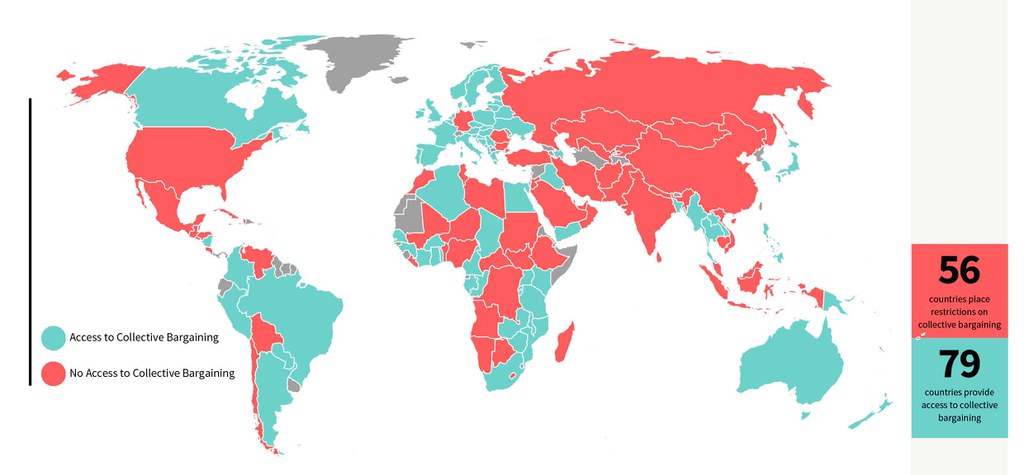
10.3 Right to Strike
Does the law provide the right to strike?
International Regulatory Standard
Article 11 , Convention 87 states that each Member of the International Labour Organisation for which this Convention is in force undertakes to take all necessary and appropriate measures to ensure that workers and employers may exercise freely the right to organise.
Para 751 of the Compilation of decisions of the Committee on Freedom of Association, 2018 shares that while the Committee has always regarded the right to strike as constituting a fundamental right of workers and of their organisations, it has regarded it as such only in so far as it is utilised as a means of defending their economic interests. Para 754 further states that the right to strike is an intrinsic corollary to the right to organise protected by Convention No. 87.
Methodology
Whether the law allows the right to strike:
1: The legislation provides for the right to strike for workers.
0: The right to strike is not provided in law or if there is an explicit general prohibition on strikes. There are excessive exclusions based on race, political opinion, nationality, or occupational categories (public or private sector). The right is jeopardised through many Restrictions (e.g. limiting or stipulating the duration of a strike before initiation of strike action or where the list of essential services is broader than the approved list*
A requirement of more than 50% of members to be in favour of a strike is present (requirement of an absolute majority,).
The legislation sets too long periods for previous negotiation, conciliation, and mediation (greater than 30 days) or unreasonable notice/cooling-off periods before calling a strike (greater than 14 days).
Only 29% of the 135 countries allow their workers the right to strike.
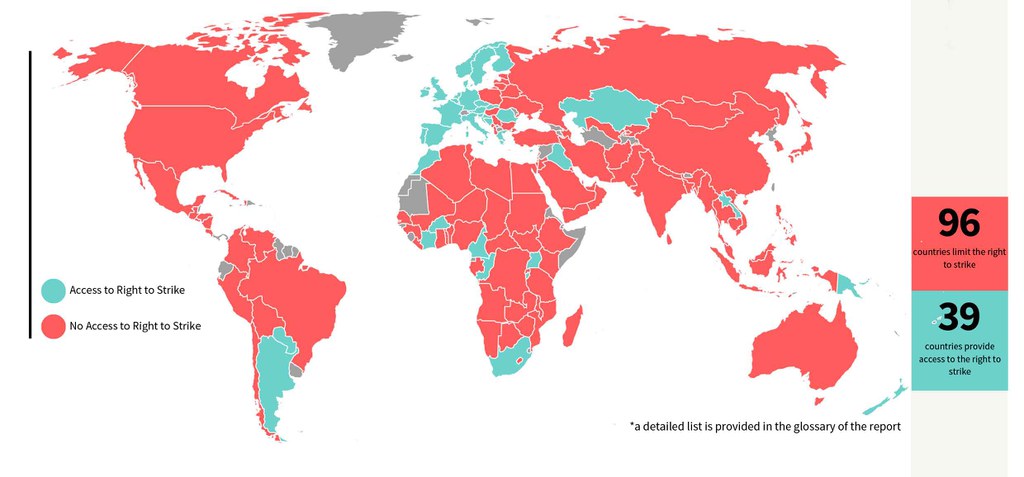
10.4 Replacing Workers on Strike
Does the law prohibit employers from terminating employment contracts of striking workers?
International Regulatory Standard
Article 1 of the Right to Organise and Collective Bargaining Convention, 1949 (No. 98) states that workers shall enjoy adequate protection against anti-union discrimination in their employment. Such protection shall apply more particularly in respect of actions calculated to make the employment of a worker subject to the condition that he shall not join a union or shall relinquish trade union membership; or to cause the dismissal of or otherwise prejudice a worker because of union membership or because of participation in union activities outside working hours or, with the consent of the employer, within working hours.
Methodology
Whether the law prohibits replacing workers on strike:
1: The legislation prohibits the replacement of striking workers.
0: The law does not prohibit replacing workers on legitimate and peaceful strikes,and there are excessive sanctions in case of strikes,including imprisonment of workers.
There are excessive, disproportionate and/or penal sanctions for organising or participating in a legitimate strike, irrespectively whether the strike is lawful or unlawful under the national legislation.
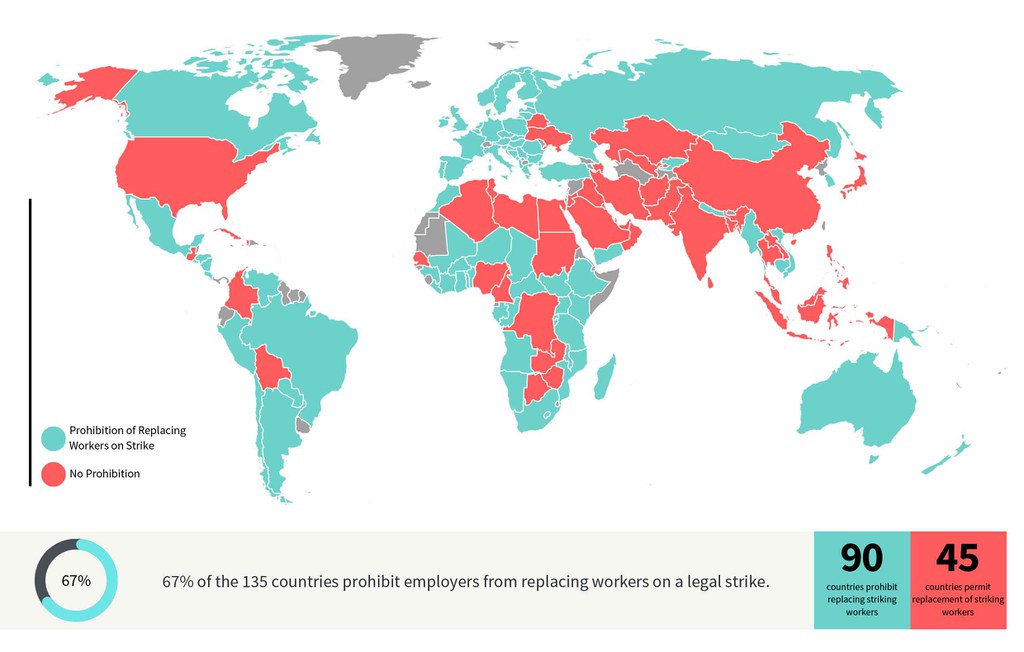
Trade Union - Snapshot
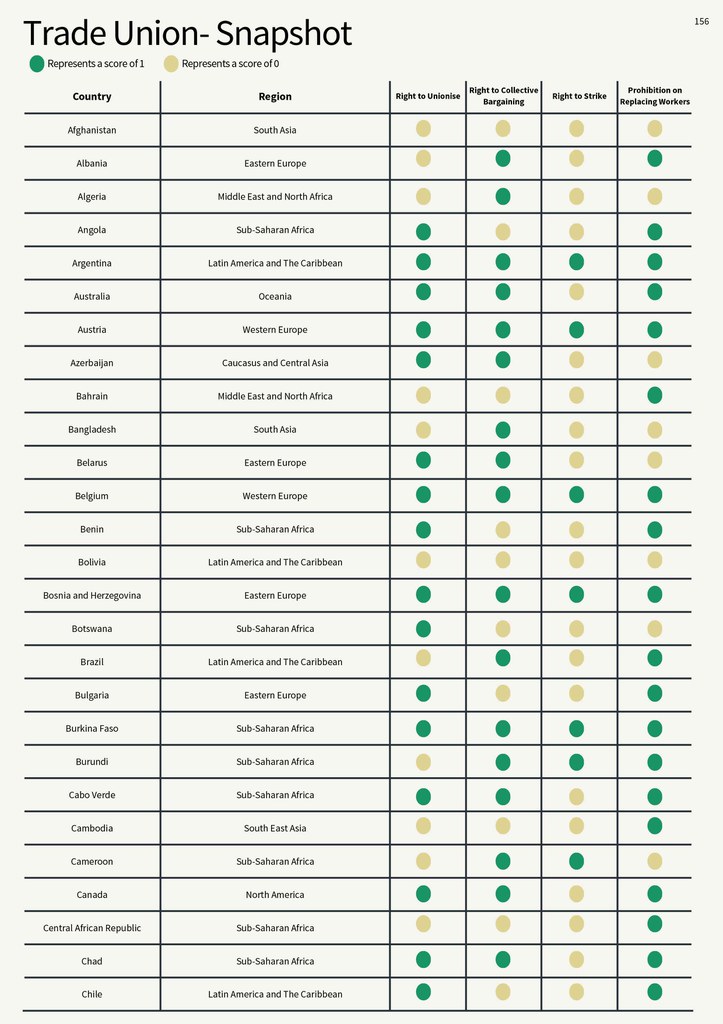

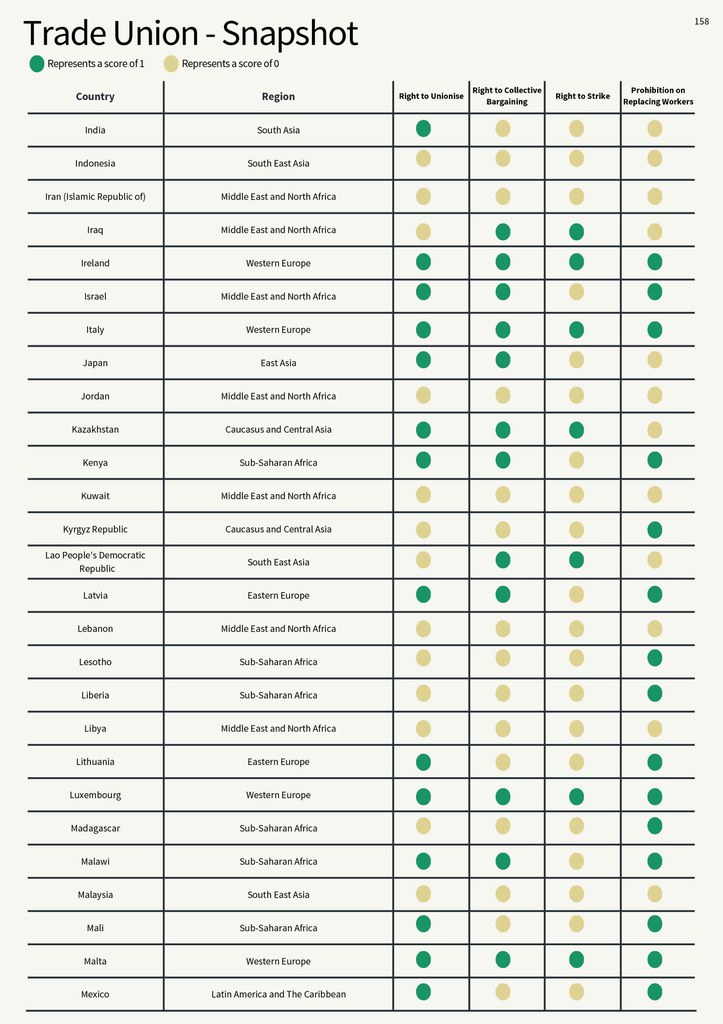
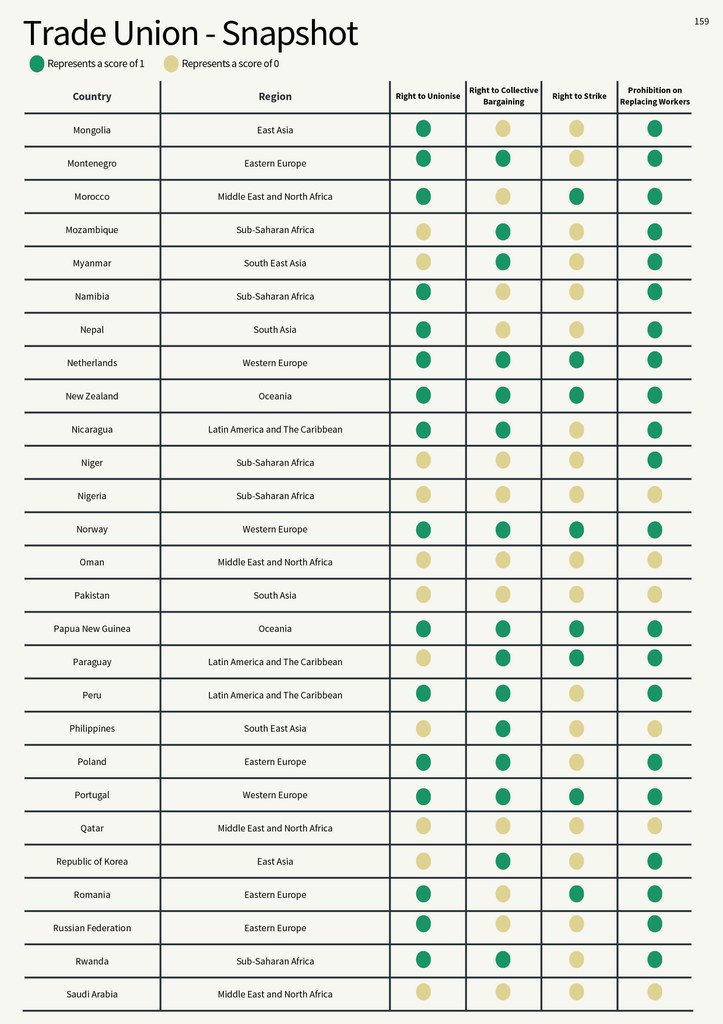
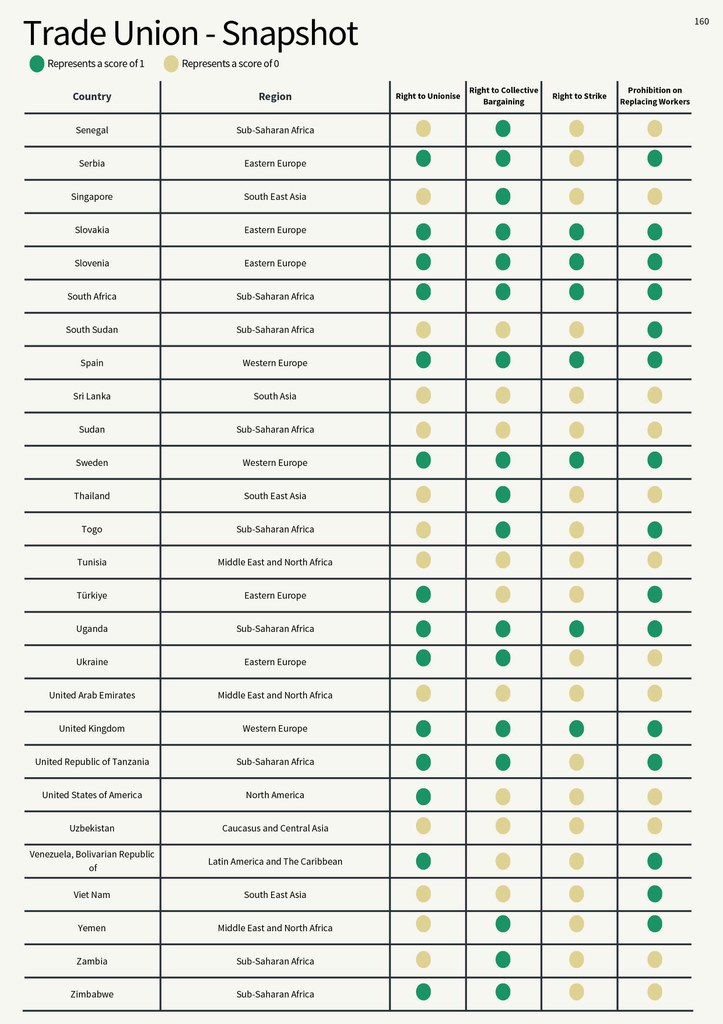
CONTEXTUALISING AND NORMALISING THE COUNTRY SCORES ON THE LABOUR RIGHTS INDEX
The Labour Rights Index Methodology
The Labour Rights Index (LRI) scores 135 countries across ten indicators that span fair wages, decent working hours, employment security, family responsibility, maternity at work, social security, forced labour and a workerʼs access to trade union and freedom of association.
Each indicator is made up of four to five binary questions that assess the countryʼs legislation and legal provisions on its ability to guarantee a specific right to its worker.
Under the Employment Security indicator, for instance, this would look like this:
- Does the law require written employment pr particulars?
- Does the law restrict the hiring of fixed-term contract workers?
- Does the law limit the length of the probation period, including renewals, to three months?
- Does the law require a 30-day notice period before contract termination?
- Does the law require severance pay at the rate of at least two weeks of wages for every year of service?
Each question will be answered as Yes (1) or No (0) against a specific criterion detailed within the methodology.
This score is then scaled to 100.
The final score of a country is a simple average of all ten indicators.
The Limits of the Index
As each indicator with its relevant questions (46 in total) assesses a country on legislation and legal text, the LRI fails to capture the on-ground realities present in the application of the law.
Having robust legislation that declares that workers will be provided with employment contracts, sets limits to the use of a fixed-term contract, and states that the probation period should be less than three months along with a guarantee of notice period followed by the provision of severance pay does not necessarily translate to execution.
This can be caused by a flawed democracy, a weak labour inspectorate system or simply because of a dominant informal sector that falls outside the power of the law amongst many reasons. However, the chasm between legislation and its application boils down in essence to a weak rule of the law.
Accounting for Reality
LRI-Normalized Heat Map
We normalise the LRI scores using the min-max method and then scaling the score to 100.
To bridge the gap between the de jure labour rights and the de facto situation, the index is used in conjunction with data on the legitimacy or effectiveness of laws in practice.
This is done by combining the LRI score with a multitude of additional indexes and data sources.
World Justice Project (WJP)
Factor 6 of the World Justice Project (WJP)ʼs Rule of Law Index measures the regulatory enforcement of the law in a country.[45] It scores between 0 and 1 with a lower score indicating a weaker adherence to the rule of law
The author creates a composite index by calculating a new score as a product of Factor 6 and the LRI score:
LRI scored adjusted under the Ruel of Law Index is given by:
Normalised (min-max) [Factor 6 of the Rule of Law X LRI score]
Size of Formal Sector
The size of the formal sector allows for the assessment of the proportion of the labour force that is under the jurisdiction of the legislation. A high score on the Labour Rights Index might not be as impactful if the laws assessed only protect a minority of workers.
To rectify this, we create a composite index by calculating a new score as a product of the formal sector[46] as a percentage of the workforce and the LRI score:
LRI scored adjusted under the formal sector size is given by:
Normalised [Formal sector (%age) X LRI score]
Worldwide Governance Indicators (WGI)
The Rule of Law dimension of the Worldwide Governance Indicators (WGI) by the World Bank captures “perceptions of the extent to which agents have confidence in and abide by the rules of society, and in particular the quality of contract enforcement, property rights, the police, and the courts, as well as the likelihood of crime and violence.”[47]
The scores under WGI range from approximately
-2.5 (weak) to 2.5 (strong) governance performance which has been readjusted from 0 (weak) to 5 (strong performance).
The author creates a composite index by calculating a new score as a product of the Rule of Law dimension and the LRI score:
LRI scored adjusted under the formal sector size is given by:
Normalised (min-max) [ ((0.2 x Rule of Law dimension) + 0.5) X LRI score]
Sustainable Development Goal 8.8.2
SDG indicator 8.8.2, calculated by the ILO, ranges from 0 to 10, with 0 being the best possible score and 10 the worst, indicating levels of compliance with Freedom of Association and Collective Bargaining rights. The score on Trade Union indicator of the LRI is replaced with the scaled score under SDG 8.8.2.[48]
To account for the de facto trade union rights present in a country, the we calculate a new score as follows:
Normalised {{ ∑ (9 indicators) + [(1 - SDGG 8.8.2)*100] } ÷ 10 (min-max) }
Final Output
This allows for the creation of four additional heat maps. Each adds a layer of context and granularity and provides an additional lens through which the end-user may interpret the Labour Rights Index.
However, no data set looks at each country assessed in the LRI. This leads to missing values in the resulting graphs. Until the Index extends to assessing the de facto application, composite indexes with missing values will have to act as a stopgap.
LRI Orignal Heatmap
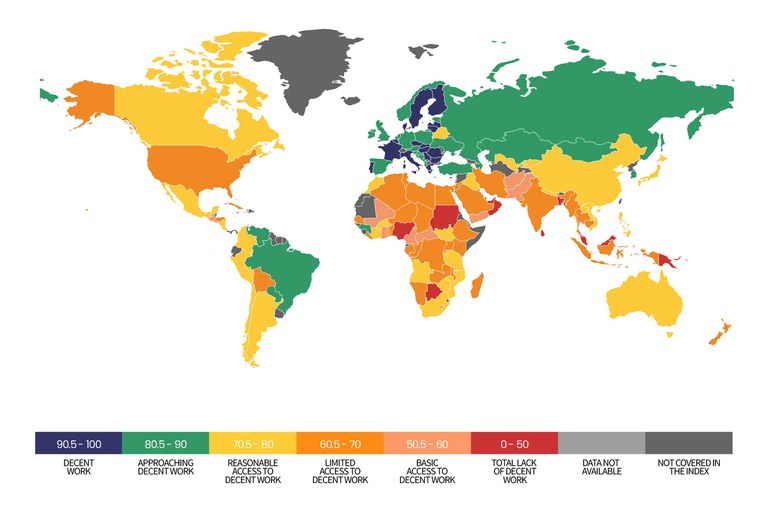
This is the original heat map of the Labour Rights Index 2022.
LRI Normalised Heatmap
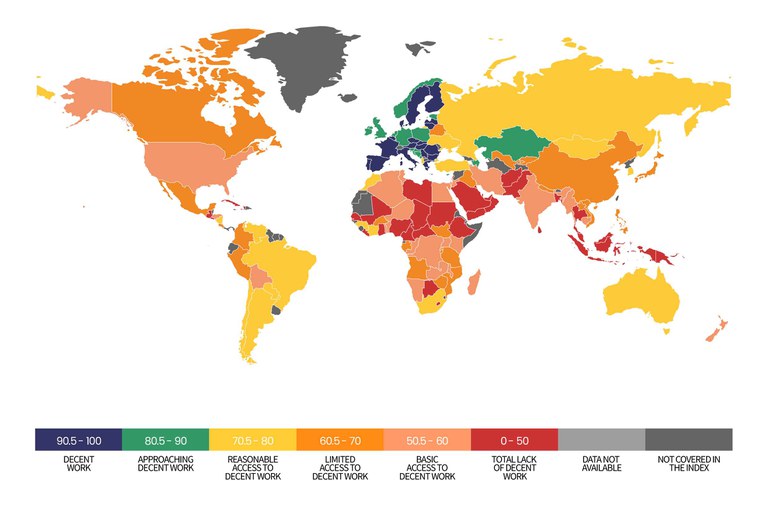
This map shows normalised scores from the Labour Rights Index by using the min-max method.
LRI-WJP Heatmap

This map is a product of the LRI overall score (0-100) and country score on Factor 6 (0-1), measuring regulatory enforcement from the Rule of Law Index of the World Justice Project. The scores are normalised using the min-max method and scaled to 100. WJP Data is, however, available only in 120 of the 135 LRI countries.
For more information about the WJP's Rule of Law Index, please follow the link: https://worldjusticeproject.org/rule-of- law-index/factors/2022
LRI-SDG 8.3.1 Heatmap

This map is a product of the LRI overall score (0-100) and the proportion of formal employment in total employment. The scores are normalised using the min-max method and scaled to 100. The proportion of formal employment is indirectly derived from SDG indicator 8.3.1, computed by ILO. Data is, however, available only in 70 of the 135 LRI countries.
For more information about the SDG Indicator 8.3.1 on proportion of informal employmentin total employment, please follow the link: https://www.ilo.org/shinyapps/bulkexplorer13/?lang=en&id=SDG_0831_SEX_ECO_RT_A
LRI-WGI Heatmap
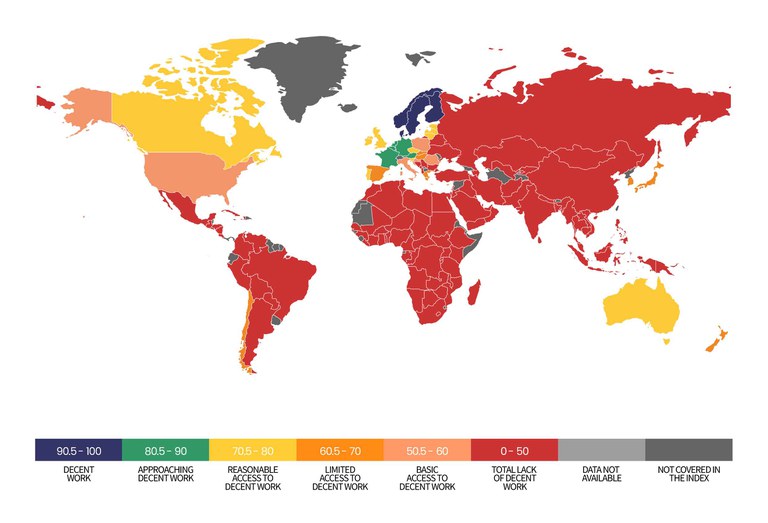
This map is a product of the LRI overall score and the scaled score on the Rule of Law dimension of the Worldwide Gover- nance Indicators (WGI) by the World Bank. The scores under WGI range from approximately -2.5 (weak) to 2.5 (strong) governance performance. These are readjusted from 0 (weak) to 5 (strong performance. The final scores are normalised using the min-max method and scaled to 100.WGI data is available for all LRI countries.
For more information about the World Gove rnance Indicators, ple ase follow the link: https://info.worldbank.org/ governance/wgi/
LRI-SDG 8.8.2 Heatmap
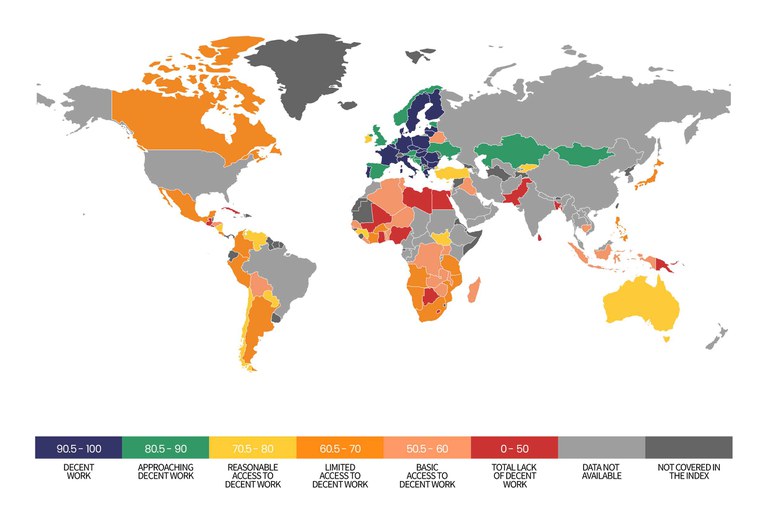
This map is created while using the country score on SDG 8.8.2 (after indirectly calculating the levels of compliance with FACB rights and scaling the result to 100) instead of the LRIʼs own Trade Union indicator score to account for the de facto trade union rights present in a country. SDG indicator 8.8.2, calculated by the ILO, ranges from 0 to 10, with 0 being the best possible score and 10 the worst, indicating levels of compliance with Freedom of Association and Collective Bargaining rights). The final scores are normalised using the min-max method and scaled to 100. Data is available for 97 of the 135 LRI countries.
For more information about the SDG Indicator 8.8.2 on the level of national compliance with labour rights (FOA& CB), please follow the link: https://www.ilo.org/shinyapps/bulkexplorer23/?lang=en&id=SDG_0882_NOC_RT_A
LRI SCORE AND RATINGS ADJUSTMENTS
While working on the Trade Union database under the Labour Rights Index, the following score and rating adjustments were made at the start of January 2023 due to the availability and accessibility of existing legal information. These adjustments have been reflected in indicator scores and overall scores. The heatmap has been revised as well.
| 7 October 2022 | 4 January 2023 | ||||
| Rating Changed | Total Score (LRI 2020) | Total score | Rating | Total score | Rating |
| Brazil | 77 | 79 | Reasonable Access to Decent Work | 81.5 | Approaching Decent Work |
| Mozambique | 66.5 | 69 | Limited Access to Decent Work | 71.5 | Reasonable Access to Decent Work |
| Country | LRI 2020 Score | LRI 2022 Score (7 Oct 2022) | LRI 2022 Score (4 Jan 2023 ) | Topic | Sub-Topic | Reason for Score Adjustment |
| Algeria | Not covered under 2020 LRI | 67 | 64.5 | Trade Union | Replacing Workers on Strike | Score adjusted from 1 to 0 since the legislation prescribes penalties for unlawful work stoppages ranging from eight days’ to two months’ imprisonment. |
| Austria | 90 | 87.5 | 90 | Trade Union | Right to Strike | Score adjusted from 0 to 1 since no violative legal provisions could be located. |
| Brazil | 77 | 79 | 81.5 | Trade Union | Collective bargaining | Score adjusted from 0 to 1 since no violative legal provisions could be located. |
| Cameroon | 66.5 | 56.5 | 59 | Trade Union | Right to Strike | Score adjusted from 0 to 1 since no violative legal provisions could be located. |
| Chile | 75 | 75.5 | 78 | Trade Union | Freedom of Association | Score adjusted from 0 to 1 since no violative legal provisions could be located. |
| Egypt | 69.5 | 65 | 67.5 | Trade Union | Collective bargaining | Score adjusted from 0 to 1 since no violative legal provisions could be located. |
| Germany | 84 | 86.5 | 89 | Trade Union | Right to Strike | Score adjusted from 0 to 1 since no violative legal provisions could be located. |
| Ireland | 81 | 81 | 83.5 | Trade Union | Collective bargaining | Score adjusted from 0 to 1 since no violative legal provisions could be located. |
| Kazakhstan | 84.5 | 82 | 84.5 | Trade Union | Right to Strike | Score adjusted from 0 to 1 since no violative legal provisions could be located. |
| Mozambique | 66.5 | 69 | 71.5 | Trade Union | Collective bargaining | Score adjusted from 0 to 1 since no violative legal provisions could be located. |
| New Zealand | 68.5 | 65.5 | 68 | Trade Union | Right to Strike | Score adjusted from 0 to 1 since no violative legal provisions could be located. |
| Papua New Guinea | Not covered under 2020 LRI | 39.5 | 42 | Trade Union | Collective bargaining | Score adjusted from 0 to 1 since no violative legal provisions could be located. |
| Portugal | 93 | 91 | 93.5 | Trade Union | Right to Strike | Score adjusted from 0 to 1 since no violative legal provisions could be located. |
| Tunisia | 65.5 | 65.5 | 63 | Trade Union | Replacing Workers on Strike | Score adjusted from 1 to 0 since the legislation prescribes penalties for illegal strikes ranging from three to eight months’ imprisonment. |
| United Kingdom | 81 | 83 | 88 | Trade Union | Right to Strike and Replacing Workers on Strike | Score adjusted on two questions from 0 to 1 since no violative legal provisions could be located. |
Glossary
Annual Leave
All employees are entitled to paid time off from work during each working year.
Child
Any young person under 15 years of age (14 years in developing countries) or still subject to compulsory full-time schooling under national law.
Collective Agreement
All agreements in writing regarding working conditions and terms of employment concluded between an employer, a group of employers or one or more employers' organisations, on the one hand, and one or more representative workers' organisations, or, on the absence of such organisations, the representatives of the workers duly elected and authorised by them per national laws and regulations, on the other. (Para. 2 (1) of the R91)
Collective Bargaining
A negotiation process between unions and employers regarding the terms and conditions of employment of employees and the rights and responsibilities of trade unions.
Compensation: Compensation is a form of recompense, both in the form of monetary reparation or time- off, for those working "unsocial hours," i.e., working overtime, at night, weekly rest days and public holidays.
Contributory Benefits System
The grant depends on direct financial participation by the persons protected or their employer or on a qualifying period of occupational activity. (Art. 1(j) of the C128)
De Jure
All such practices and actions that are legally recognised, irrespective of whether they exist in practice. De jure (based on law) is used in contrast to de facto (in practice).
Discrimination
Any distinction, exclusion or preference based on race, colour, sex, religion, political opinion, national extraction or social origin, age, disability and trade union membership that has the effect of nullifying or impairing equality of opportunity or treatment in employment or occupation.
Employment Segregation
The concentration of women and men in different types and levels of activity and employment, with women being confined to a narrower range of occupations than men (horizontal segregation) and lower work grades (vertical segregation).
Equal Remuneration for Work of Equal Value
Rates of remuneration established without discrimination based on sex.
Essential services
Services, the interruption of which may endanger the life, personal safety or health of the whole or part of the population. However, the concept is not absolute. A non-essential service may become essential if a strike lasts beyond a specific time or extends beyond a particular scope. The following may be considered to be essential services in the strict sense of the term: the hospital sector; electricity services; water supply services; the telephone service; the police and the armed forces; the firefighting services; the public or private prison services; the provision of food to pupils of school age and the cleaning of schools; air traffic control. (ILO CFA Digest of decisions and principles, Para. 840)
Family Responsibilities
Applies to men and women workers with responsibilities in relation to their dependent children, and to other members of their immediate family who clearly need their care or support, where such responsibilities restrict their possibilities of preparing for, entering, participating in or advancing in economic activity.
Fixed-Term Contract
An employment contract entered directly between an employer and a worker, where the end of the employment contract or relationship is determined by objective conditions such as reaching a specific date, completing a specific task, or the occurrence of a specific event.
Forced Labour
All work or service which is exacted from any person under the menace of any penalty and for which the person has not voluntarily offered himself. Exceptions include compulsory
General Weekly Hours
The number of hours specified in the relevant industrial instrument as the average number of hours per working week of an employee during a week.
Gig Economy
The gig economy combines online/digital marketplaces for engaging individuals for short-term tasks. These mini marketplaces are also referred to as digital labour platforms. The platform economy distinguishes between two primary forms of work: crowd work and work on demand via apps. Crowd work is performed online and is location-independent. 'Work on demand via apps', on the other hand, matches the worker and the client digitally, and the work is performed locally. Activities include transportation, food delivery and home services.
Fundamental Workers' Rights
Freedom of association and the effective recognition of the right to collective bargaining, freedom from forced labour, child labour and discrimination.
Invalidity Benefit
Cash payments on account of complete or partial inability to participate gainfully in the labour market due to disability. The invalidity may be congenital or result from an accident or illness during the victim's lifetime. Invalidity is also referred to as disability.
Living Wage
The level of wages sufficient to meet the basic living needs of an average-sized family in a particular economy.
Maternity Leave
Leave to which a woman is entitled to a continuous period, allocated before and/or after giving birth per national legislation and practice.
Night Time
Any period of not less than seven hours, as defined by national law, which must include the period between midnight and 5 a.m.
Night Worker
A worker who works at least three hours of his/her daily working time during night time as a regular course.
Non-Contributory Universal Benefits
Benefits the grant of which does not depend on direct financial participation by the persons protected or their employer or on a qualifying period of occupational activity (Art1, C128)
Overtime
The working hours of a worker above the standard established by law, a collective bargaining agreement, an individual employment contract or company policy. Such hours are generally paid for at "penalty" or overtime rates.
Occupational Accident
An Occupational accident is an unexpected and unplanned occurrence, including acts of violence, arising out of or in connection with work which results in one or more workers incurring a personal injury, disease or death. Occupational accidents are to be considered as travel, transport or road traffic accidents in which workers are injured and arise out of or in the course of work, i.e. while engaged in economic activity, at work, or carrying on the employer's business.
Parental Leave
The individual right to leave, in principle on a non-transferable basis, for all male and female workers following the birth or adoption of a child to enable them to take care of that child. There is usually a fixed amount of leave or fixed amounts of time in any year or years that may be taken for reasons concerning care responsibilities.
Part-time Work
Work arrangement implying working hours that are shorter than usual or standard full-time hours.
Paternity Leave
Employment-protected leave of absence for employed fathers at or in the first few months after childbirth.
Permanent Worker
A worker with an employment contract or relationship of indefinite duration.
Probationary Period
A fixed-length monitoring period allowed by law for new employees to determine whether they have the skills and abilities needed to perform the assignment in their employment contract.
Remuneration
Ordinary, basic or minimum wage or salary and any additional emoluments whatsoever payable directly or indirectly, whether in cash or kind, by the employer to the worker and arising out of the worker's employment.
Sexual Harassment Sanctions
Legislation may provide civil remedies and/or criminal penalties. The aim of civil remedies is to restore the victim to their position before the sexual harassment occurred. These include recovering monetary or emotional damages or compensation to the victims even after they have left employment. Criminal penalties penalise the perpetrator of harassment for committing sexual harassment. These include monetary fines and imprisonment.
Severance Payment
The final payment made to a worker when his/her employment is terminated.
Social Protection
Used interchangeably with 'social security', it is the set of policies and programmes designed to reduce and prevent poverty, vulnerability and social exclusion throughout the life cycle. It includes nine main areas identified in C102: child and family benefits, maternity protection, unemployment support, employment injury benefits, sickness benefits, health protection (medical care), old-age benefits, invalidity/disability benefits, and survivors' benefits. Social protection systems address all these policy areas through a mix of contributory schemes (social insurance) and non-contributory tax-financed benefits (including social assistance).
Strike
A concerted temporary stoppage of or withdrawal from work by a group of workers of an establishment or several establishments to express a concern or to enforce demands affecting wages, working hours and/or working conditions.
Violence and Harassment
A range of unacceptable behaviours and practices, or threats thereof, whether a single occurrence or repeated, that aim at, result in, or are likely to result in physical, psychological, sexual or economic harm.
Gender-based Violence and Harassment
Violence and harassment directed at persons because of their sex or gender, or disproportionately affecting persons of a particular sex or gender, and includes sexual harassment.
Trade Union
An association of workers to protect and promote common interests.
Wage
The payment in exchange for labour provided under a contract of employment. The gross wage is the wage before deduction of taxes and other authorised deductions. Wages are calculated according to time-rate or piece-rate systems.
Work Injury Benefit
Cash payments on account of complete or partial inability to participate gainfully in the labour market due to disability or fatality caused by an occupational accident.
References
- Anner, M., Kucera, D., & Sari, D. (2017). Labour Rights Indicators: A New Resource for Better Understanding of Labour Rights in the World. Global Labour Column.
- Botero, J., Djankov , S., La Porta, R., Lopez-de-Silanes, F., & Shleifer, A. (2004). The Regulation of Labour. Quarterly Journal of Economics, 1339-1382.
- Center for Global Workers’ Rights. (2020). Labour Rights Indicators. Retrieved from Penn State University: http://labour-rights-indicators.la.psu.edu/
- Diane F. Frey, G. M. (2016). A Human Rights Lens on Full Employment and Decent Work in the 2030 Sustainable Development Agenda. SAGE.
- Frey, D. F., & MacNaughton, G. (2016). A Human Rights Lens on Full Employment and Decent Work in the 2030 Sustainable Development Agenda. SAGE.
- Gentilini, Ugo; Almenfi, Mohamed; Orton, Ian; Dale, Pamela. 2020. Social Protection and Jobs Responses to COVID-19 : A Real-Time Review of Country Measures. World Bank, Washington, DC. © World Bank. https://openknowledge.worldbank.org/handle/10986/33635 License: CC BY 3.0 IGO.
- Hannah Ritchie, Edouard Mathieu, Lucas Rodés-Guirao, Cameron Appel, Charlie Giattino, Esteban Ortiz-Ospina, Joe Hasell, Bobbie Macdonald, Diana Beltekian and Max Roser (2020) - "Coronavirus Pandemic (COVID-19)". Published online at OurWorldInData.org. Retrieved from: 'https://ourworldindata.org/coronavirus
- Hawkins, A. J. (2020, May). UBER and LYFT’S Fragmented Future can be Glimpsed in California’s Driver Classification Lawsuit. Retrieved from THE VERGE: https://www.theverge.com/2020/5/7/21250955/uber-ab5-california-lawsuit-driver- misclassification-future-ny-nj-analysis
- Heymann, J., & Earle, A. (2009). Raising the Global Floor: Dismantling the Myth that We Can’t Afford Good Working Conditions for Everyone. Stanford University Press.
- ILO. (2008). ILO Declaration on Social Justice for a Fair Globalisation. Geneva:
International Labour Organization. Retrieved from https://www.ilo.org/wcmsp5/groups/public/---dgreports/--- cabinet/documents/genericdocument/wcms_371208.pdf - ILO. (2013, April 3). Labour Inspection Country Profiles. Retrieved from International Labour Organization: http://ilo.org/labadmin/info/WCMS_DOC_LAB_INF_CTR_EN/lang-- en/index.htm)
- ILO. (2018, April 30). More than 60 per cent of the World’s Employed Population are in the Informal Economy. Retrieved from International Labour Organization: https://www.ilo.org/global/about-the-ilo/newsroom/news/WCMS_627189/lang-- en/index.htm
- ILO. (2020). Decent Work Indicators. Retrieved from International Labour Organization: https://www.ilo.org/integration/themes/mdw/WCMS_189392/lang--en/index.htm
- ILO. (2020). Retrieved from Employment Protection Legislation Database (EPLex): https://eplex.ilo.org/?p_lang=en%29
- ILO. (2020). Global Database on Occupational Safety and Health Legislation. Retrieved from International Labour Organization: https://www.ilo.org/dyn/legosh/en/f?p=14100:1:0::NO:
- ILO. (2020, July 1-9). ILO Global Summit on COVID-19 and the World of Work - Building a Better Future of Work. Retrieved from International Labour Organization: https://www.ilo.org/global/topics/coronavirus/events/WCMS_747476/lang--en/index.htm
- ILO. (2020). Legal Database on Industrial Relations. Retrieved from International Labour Organization: https://www.ilo.org/dyn/irlex/en/f?p=14100:1:0::NO:
- ILO. (2020). Working Conditions Laws Database. Retrieved from International Labour Organization: https://www.ilo.org/dyn/travail/travmain.home
- ILO. (2010). World Social Security Report 2010/11: Providing Coverage in Times of Crisis and Beyond. Geneva: International Labour Organization. Retrieved from International Labour Organization: https://www.ilo.org/wcmsp5/groups/public/---dgreports/---dcomm/---publ/documents/publication/wcms_146566.pdf
- ITUC. (2020). ITUC Global Rights Index. Retrieved from ITUC CSI IGB: https://survey.ituc- csi.org/ITUC-Global-Rights-Index.html?lang=es
- Millennium Development Goals in Latin America and the Caribbean. (2020). Retrieved from Economic Commission for Latin America and the Caribbean (ECLAC): https://www.cepal.org/cgibin/getProd.asp? xml=/mdg/noticias/paginas/7/35557/P35557.xml&xsl=/mdg/tpl/p18f-st.xsl&base=/mdg/tpl- i/top-bottom.xsl
- Miller, T., Kim, A. B., & Robert, J. M. (2020). 2020 Index of Economic Freedom. The Heritage Foundation.
- OECD. (2020). OECD Indicators of Employment Protection. Retrieved from OECD: https://www.oecd.org/employment/emp/oecdindicatorsofemploymentprotection.htm
- Social Security Administration. (2020). Research, Statistics & Policy Analysis: Social Security Programs Throughout the World. Retrieved from Social Security Administration: https://www.ssa.gov/policy/docs/progdesc/ssptw/index.html
- The National Bureau of Economic Research. (2020). The 2004 Global Labor Survey: Workplace Institutions and Practices Around the World. Retrieved from The National Bureau of Economic Research: https://www.nber.org/papers/w11598
- United Nations. (2014). The Road to Dignity by 2030: Ending Poverty, Transforming All Lives and Protecting the Planet. New York.
- United Nations. (2017). Work of the Statistical Commission pertaining to the 2030 Agenda for Sustainable Development. Resolution adopted by the General Assembly on 6 July 2017, (pp. 1-25).
- United Nations. (2020). Promote Sustained, Inclusive and Sustainable Economic Growth, Full and Productive Employment and Decent Work for All. Retrieved from Department of Economic and Social Affairs: https://sdgs.un.org/goals/goal8
- University of Cambridge. (2020). Apollo: CBR Leximetric Datasets. Retrieved from University of Cambridge: https://www.repository.cam.ac.uk/handle/1810/256566
- World Bank. (2004). Doing Business in 2004: Understanding Regulation. Washington DC: World Bank; The International Finance Corporation; Oxford University Press. Retrieved from https://www.doingbusiness.org/content/dam/doingBusiness/media/Annual- Reports/English/DB04-FullReport.pdf
- World Bank. (2016). Doing Business 2016: Measuring Regulatory Quality and Efficiency. Washington DC: World Bank. doi:10.1596/978-1-4648-0667-4
- World Bank. (2019). Women, Business and the Law 2019. Washington DC: World Bank. Retrieved from https://openknowledge.worldbank.org/bitstream/handle/10986/31327/WBL2019.pdf? sequence=4&isAllowed=y
- World Bank. (2020). Doing Business 2020: Comparing Business Regulation in 190 Economies. Washington DC: World Bank. DOI:10.1596/978-1-4648-1440-2.
- World Economic Forum. (2016). The Global Competitiveness Report 2016-2017. Geneva: World Economic Forum. Retrieved from http://www3.weforum.org/docs/GCR2016- 2017/05FullReport/TheGlobalCompetitivenessReport2016-2017_FINAL.pdf
- Yang, L. (2014). An Inventory of Composite Measures of Human Progress. United Nations Development Programme Human Development Report Office.
